About the Commission
The Social Mobility Commission is an independent advisory non-departmental public body established under the Life Chances Act 2010 as modified by the Welfare Reform and Work Act 2016. It has a duty to assess progress in improving social mobility in the UK and to promote social mobility in England. The Commission board comprises:
Chair
Alun Francis OBE, Chief Executive of Blackpool and The Fylde College.
Deputy Chairs
Resham Kotecha, Head of Policy at the Open Data Institute.
Rob Wilson, Chairman at WheelPower – British Wheelchair Sport.
Commissioners
Dr Raghib Ali, Senior Clinical Research Associate at the MRC Epidemiology Unit at the University of Cambridge.
Ryan Henson, Chief Executive Officer at the Coalition for Global Prosperity.
Parminder Kohli, Chair Shell UK Ltd and Shell Group Executive Vice President Sustainability and Carbon.
Tina Stowell MBE, The Rt Hon Baroness Stowell of Beeston.
This report was written by Dr Lindsay Richards, Sociology Department, University of Oxford; Dr Yang Yu, Centre for Social Investigation at Nuffield College, University of Oxford; Dr Lewis Anderson, Department of Social Policy and Intervention, University of Oxford; Julia Jungblut, Sociology Department, University of Oxford; Gio Epifani, Sociology Department, University of Oxford; Dr Elena Mylona, Research Fellow, Centre for Time Use Research, UCL, and Early Career Fellow, Institute of Advanced Studies/Department of Sociology, University of Warwick. We are also grateful for contributions from members of the SMC secretariat.
Executive summary
This report sets out to highlight inequalities in the lives of children and their parents in access to aspects of life that are thought to help or hinder social mobility. Our coverage is broad. For example, we look at parents reading to their children and helping them with homework, as well as ‘softer’ areas of home life, including parenting styles and values, and qualities of the child–parent relationship. We also cover how much ‘social capital’ parents have, extending to features of the neighbourhoods they live in, as well as parents’ ‘cultural capital’ and how interested they are in topics like the arts, science and maths. We examine some practical areas of home life that are likely to be important for the child to do well at school, including good access to the internet at home and available study space – topics highlighted by the pandemic – as well as more general points such as paid private tuition. We make a conceptual distinction between ‘parental endowments’ and ‘parental investments’, which we might roughly interpret as what parents have versus what parents do. The final chapter is dedicated to ‘children’s lives’; in it we examine inequalities in mental health, in children’s ‘strengths and difficulties’ including inattention and hyperactivity, and in using alcohol and drugs.
Overall, we consider the measures we report to be indicators (sometimes imperfect ones) of the possible pathways by which parents’ socio-economic status might affect their children’s life chances.
This report is an update of work originally published in 2016, which showed widening inequalities in parental time investments and in children’s conduct disorders. This new report gives fresh attention to and detail on child wellbeing and covers experiences of the pandemic, which have implications beyond that specific period, highlighting important differences in life at home that may tell us about the capability to be resilient in crises.
Chapter 1. Parental endowments
The key findings of this chapter are:
- Social capital: there are stark differences across backgrounds in terms of neighbourhood trust, and levels of satisfaction with local amenities also tend to be higher among parents with higher socio-economic status. These parents also tend to have higher civic engagement and do more volunteering, and when they do, they are more likely to report that they experience social mixing with people from different backgrounds and different neighbourhoods. There are smaller differences in informal networks (having friends to rely on).
- Cultural capital: the types of cultural activities that are most popular include cinema, museums, theatre and live music, and the order of these preferences seems to be the same across all groups. However, the levels of almost all activities are higher among higher socio-economic classes. Looking at the reasons given by parents for not doing these cultural activities, it appears that the higher socio-economic groups are more likely to say they are short of time. The lower socio-economic groups are much more likely to cite poor health as a reason (15% among those with no or low education).
- Values, interests and knowledge: there are some differences in the qualities that parents wish for their children. While ‘thinking for themselves’ is the most desired quality for all parents, higher-educated parents (59%) and those in a higher socio-economic group (63%) are more likely to emphasise it compared with parents with no education or low education levels (33%) and lower-working-class parents (42%). Parents in high socio-economic status groups are more likely to report that their child is likely to go to university (58% among higher professionals versus 35% among lower-working-class parents). Despite this, parents with low socio-economic status show high levels of awareness of the importance of qualifications and good knowledge of the education system. We also report parents’ interest in arts, science, technology, engineering and maths. We find that levels of interest are often low (e.g., below 10% for engineering and maths) but that they are always higher among the parents with higher socio-economic status.
Chapter 2. Parental investments
The key findings relating to the time, activities and support invested by parents in their children are as follows:
- The picture is mixed in terms of the type of ‘investments’ in a home learning environment, such as doing activities and helping with homework. We do not see a uniform picture of parents in a lower occupational class or less-educated parents lacking in investments in terms of activities with their children. In many cases they actually do more than more-advantaged parents, and for some activities such as music, stories and arts, the picture is one of greater inequality within lower socio-economic groups, i.e., more children do daily activities but there are also more who never do these things.
- Time use data shows that mothers with higher socio-economic status spend on average 79 minutes per weekday on ‘developmental activities’ – reading and playing with their young children – compared with 50 minutes for lower-working-class mothers.
- There are moderate gradients in parental monitoring, talking about things that matter, discussing school reports, and quarrels, although the overall ‘parenting styles’ seem to be very similar across socio-economic groups.
Chapter 3. Children’s lives
This chapter looks at experiences of school, experiences of the pandemic and various dimensions of wellbeing. The key findings are:
- In contrast to the 2016 report, we find no differences across socio-economic background in truancy and exclusion from school. We find a reverse gradient in drinking alcohol, vaping and illegal drugs, which is to say higher levels of these activities among school children from more-affluent families.
- Our findings are indicative of a potential crisis in adolescent mental health in the UK. On some items, such as feeling nervous and losing confidence in new situations, 35% of girls aged 11 to 15 agree – a strikingly high number.
- We find that gender differences in mental wellbeing are often larger than differences across socio-economic background, although on most measures there is also evidence that those from lower socio-economic backgrounds are worse off than those from higher socio-economic backgrounds.
- We find that the inequalities among 11-year-olds that we reported in 2016 in conduct disorders, emotional symptoms, and hyperactivity and inattention remain among children aged 17. For example, lower-working-class parents are 3 times more likely to report issues relating to hyperactivity and inattention than higher professional parents. However, the differences are almost non-existent when relying on children’s own self-reports.
- Experiences of the pandemic: we find that children from lower socio-economic groups are more likely to report that they had issues during lockdown with having a suitable place to work at home and a suitable device to work on. For example, 18% of lower-working-class children report that they relied on their mobile phone to do school work, and a further 9% had no suitable device. The figures were 5% and 1% among children in higher professional families.
- There are differences in children’s reports of whether they plan to go to university: 78% of children of higher professional parents reported planning to go to university compared with 58% of lower-working-class children. Children from lower-working-class backgrounds are more likely to report that this is because they would rather get a job, or because their family cannot afford it.
Introduction
The socio-economic background of families has a strong influence on life chances. Children growing up in better-off families will have better chances of doing well in school, getting into university and getting the best jobs once they finish their education. Of course, social background is not the only thing that matters for whether children will do well. Children will be more or less lucky in their natural aptitude for academic work, and birth order might matter, as will the local area they happen to be born into. There are many more opportunities for good jobs, for example, in the economically thriving cities of the UK, and fewer elsewhere. Family size and structure may matter too. Despite all of these complexities, however, the chances of doing well are, on average, better for those children growing up in families from higher socio-economic backgrounds (see inset box on deterministic versus probabilistic associations).
Throughout this report we focus on socio-economic differences in the lives of children across the UK, but we fully acknowledge that socio-economic status does not capture everything that is important in family life. The correlation between the socio-economic position of parents and that of their grown-up children is often taken as a key pattern that reveals levels of fairness and unfairness in society and is thus one indicator of social mobility. A strong link between parents’ and their children’s position equates to low social mobility (or ‘fluidity’). When the link is weaker we have high fluidity. When a child from a deprived background can ‘rise up’ and do well, this might be interpreted as an indicator of a fair society, one in which a difficult start in life does not obstruct individual effort and talent.
A common – but overly simple – belief is that we live in a meritocratic society that works in the following way: the bright and motivated kids do better at school, get into good colleges and universities, and therefore get access to the best jobs. Few would say that children who achieve upward mobility along this trajectory are undeserving of their success. However, this report provides a different side to the story. We do not contradict the idea that academic abilities and efforts matter for doing well, but we focus instead on some of the pathways that may link the socio-economic circumstances of parents and the kinds of things that might help or hinder children in terms of their educational and occupational success.
Some examples of these pathways include less well-off parents being less able to provide their children with resources such as study spaces and computers, and having less time and money for social, cultural and educational activities. Experiences of school are likely to vary by socio-economic background, and so may the kinds of family situations that children are exposed to. Everyone is likely to have some social capital, in terms of the benefits gained from social ties. However, parents from better-off backgrounds are thought to have more social connections that are conducive to helping their children navigate the schooling system or the labour market. They are also able to draw upon their own experiences of education and work to help their children make choices. One implication of these patterns is that children from worse-off backgrounds with good cognitive skills may be more likely to slip through the net and not achieve their potential.
Studies have also looked at how socio-economic circumstances interact with parenting. In one study, for example, it was found that poverty influences intellectual development because of lower cognitive stimulation at home – for example, as a result of lower-quality books at home or less time spent reading or playing together. The same study showed that poverty-related stress in parents was also found to lead to a parenting style that used harsher discipline and punitiveness. This illustrates that the effects of parental background on the chances of success are determined not by parental socio-economic status alone but by compound interactions of resources and actions. In summary, the basis for this report is that childhoods matter, and that the chances of success are far more complex than simply ‘smart kids do well’ or ‘poor kids do badly’.
Probabilistic versus deterministic associations
The Social Mobility Commission’s 2023 State of the Nation report reported that adults whose parents are in lower-working-class occupations are about 3 times more likely to end up in a lower-working-class occupation themselves compared to adults with higher professional parents. And in terms of education, adults whose parents have degrees are far more likely to get a degree themselves than those whose parents had no qualifications (64% against 18%).
These are stark inequalities, but they do not mean that everyone growing up in working-class families ends up in the working class, or that it is impossible to go to university if your parents did not get a degree. The differences between the groups – those with high and those with low socio-economic backgrounds – are evident in the probability of ending up in a certain class or getting a university degree.
A key distinction used in the social sciences when understanding and interpreting statistics is between probabilistic and deterministic associations. Restated, this means that your family background does not determine with certainty where you are going to end up in terms of education or occupation (a deterministic association), but it does influence the chances of where you might end up in terms of education or occupation (a probabilistic association).
We can illustrate with some hypothetical cases:
Example 1: A child has parents who are both degree-educated and in professional occupations. Her mother is a lawyer and her father is a pharmacist. Her parents always emphasised the importance of studying hard and helped her at a young age to figure out what she wanted to do. She was interested in becoming a vet because she loved animals and science, and her parents helped her to make the right choices at school and get relevant work experience by using their social contacts. This helped her to get onto a degree course, in which she did well, and she became a fully qualified vet at age 24. This child ended up where we would expect, given her background and childhood experiences of home and family life.
Example 2: A child has parents who didn’t get the chance to receive much education themselves. His mother is a cleaner and his father is a supervisor in a factory. However, he was good at academic study as a child and enjoyed the experience of learning. Teachers at his school helped him to know how to apply for further education and which courses would suit him. Encouraged by his parents, he studied geography, followed a few years later by a teacher training course at a local college. He became a teacher and had a successful career despite the fact that his parents were not highly educated. The child in this example bucked the trend, doing better in terms of educational and occupational attainment than might have been expected by looking just at his background.
Example 3: A child’s mother had a disability and couldn’t work, and his father worked driving a delivery van. His mother left school at 16 with few qualifications, and his father went into an apprenticeship from school. He did OK at school, but things were often fraught at home due to stress with his mother’s health and the lack of money. He didn’t discuss his grades or ambitions with his parents, and he left school not knowing what he wanted to be. He started working at the petrol station so that he would at least have money to be independent. Later he worked out that he liked building things and wished he could have studied engineering, but he felt it was too late to do anything now, and he was not even sure how to go about getting back into education.
Everyone has a story, and their socio-economic background is only ever one part of it. It can be an important part, as illustrated by these stories. While we acknowledge that individual lives are defined by much more than their socio-economic status, it is also worth emphasising here that socio-economic inequalities can be larger than other dimensions of inequality. For example, a study looking at ethnic, gender and class inequalities (all together in a single analysis) in 2021 showed that the size of the gap in achievement at GCSE level between those from the highest and lowest socio-economic groups was 3 times larger than the gap between boys and girls, and 8 times larger than the gap between the highest- and lowest-achieving ethnic group.
However, not all stories are simple. The co-occurence and compounding effects of many factors add complexity to each story. We know from our own work that the influences of socio-economic background and protected characteristics, such as ethnicity, can vary starkly depending on the type of outcome assessed. For example, at age 11, 44% of disadvantaged pupils met the expected standard for reading, writing and maths in 2022 to 2023 compared to 66% of other pupils. However, if we look at the effects of both socio-economic background and ethnicity, the differences are even more pronounced. Disadvantaged children of Chinese children represent the highest proportion achieving the expected standard (71%) and Gypsy or Roma ethnicity represent the lowest (14%).
Still, the story doesn’t end there. Given the uneven geographical distribution of children of different ethnicities, there may be regional effects contained in these different outcomes. We know from our recent State of the Nation report that there are indeed disparities in educational attainment between places such as London and many other areas of the country, such as the North West.
Taken together, these findings suggest that we require a much more rounded approach beyond socio-economic background alone to truly understand what is going well and for whom, and what could be improved. There are indeed gaps in the relative chances of different groups, but a wider perspective is needed. There are many exceptions, and we need a much better understanding of why – from apparently similar starting points – such differences exist and persist. The Social Mobility Commission intends to explore these questions in more detail to understand what sits behind these differences in outcomes.
Background
This report comprises a revised and updated account of The Childhood Origins Of Social Mobility published in 2016. An inspiration for the original report was an influential book by US political scientist Robert Putnam, called Our Kids. In that book, Putnam placed particular emphasis on change over time, claiming that children from high and low socio-economic backgrounds had ‘diverging destinies’. A key argument was that we need to measure these divergences now, to predict what might happen to social mobility in the future, instead of waiting (as many traditional academic studies do) for children to come to ‘occupational maturity’ at around age 35. Putnam’s prediction was one of declining mobility as those from well-off backgrounds pull away, leaving the rest left behind. However, the 2016 report by the Social Mobility Commission showed the British case to be more complex.
Some of the main areas of concern highlighted in the report 8 years ago were, first, the widening inequalities in childhood problems including hyperactivity, conduct disorders and wellbeing; and second, the widening gap in the time that parents invest in their children in terms of ‘developmental childcare’, a measure that included reading and educational play.
On time spent, we found that parents from all socio-economic groups had increased the time they spent on developmental childcare but that increases were larger when both of the parents were well educated, thus leaving a wider gap in 2015 than in 1974. On behavioural problems, we found that the risk of a child experiencing conduct disorders was the same in all classes in 1969 but by 2012, the risks were far higher for those in lower socio-economic backgrounds.
Of all the antecedents of social mobility covered, these 2 – behaviour and wellbeing in children and time investments by parents – are likely to have large and pervasive influences on later life outcomes such as the type of job the grown-up child might get and how much they might earn. These areas therefore receive extended attention in this revised report.
The report in 2016 had some good news stories as well as bad. For example, it showed declining inequalities in some norm-violating behaviours among children, such as truancy from school and the use of alcohol and drugs. The report speculated that these were “floor and ceiling” effects which tend to show narrowing inequalities over time as behaviours become rare (going towards the floor) or become ubiquitous (going towards the ceiling). The 2016 report also pointed to some areas of life that were once important but now have declining salience. One of these was library visits. While libraries are a favourite cultural space for many, it is important to acknowledge that many changes have occurred in society, and it may be that digital technologies, coupled with the relative decline in costs of books, means that children who do not go to libraries are not necessarily deprived of reading materials.
One key change we make in this report is that we reduce the emphasis on change over time, for several reasons. First, the data on time trends is often messy and difficult to measure (for example, when a data source changes its indicator of socio-economic status). We also have the time of the pandemic to contend with, which disrupted the lives of everyone. Many of our key data sources go up to 2020 and 2021, when the pandemic was in full swing.
Second, in reducing the emphasis on change we also prioritise the general picture of inequality in children’s lives, not a picture muddied by unclear patterns over time. There will be times in this report when we do choose to present change over time – for example, in the chapter on child wellbeing. We do this because this topic is highly salient at the moment, due to the probable crisis in child and adolescent mental health. Elsewhere we will show over time trends in the appendix.
Other things have changed since the 2016 report. The current context in the UK includes a cost-of-living crisis that is likely to be having strong and pervasive effects on the lives of millions of families. Increases in the cost of food, heating and household bills in the last year have been unprecedented, and housing costs have also gone up. While much of the data available to us for this report comes from before this crisis, it is important to bear in mind that the patterns we show may have become more acute during economic turmoil.
The COVID-19 lockdowns also shone a spotlight on the mental wellbeing of children and adolescents, but there is no doubt that this is an area of concern that goes well beyond the pandemic. Newer studies since the last report have shown that wellbeing, hyperactivity and conduct disorders among children influences the chances of upward social mobility.
Structure of the report
To structure the report, we borrow an important distinction from the economic theory of social mobility between endowments and investments. Endowments are assets that include ‘human capital’ (or education), social status, social networks and economic resources. Investments, on the other hand, are activities and behaviours undertaken by parents that are aimed at influencing child outcomes. These parental investments may include money spent on children’s wellbeing, education, and living conditions, as well as the time and effort put into overseeing and assisting offspring as they navigate life, the education system and the transition to the labour market.
In practice, it may be difficult to empirically disentangle endowments from investments. If a parent gets involved in running a sports club at their child’s school, is this part of their own social capital and personal values or a deliberate time investment aimed at improving their child’s experience? The type of data we use in this study does not usually allow us to know the motivations behind behaviours. However, despite this shortcoming, the distinction allows us a useful separation between what parents have (i.e. parental endowments) and what parents do (i.e. parental investments), which provides a steer when thinking of the practical implications emerging from the findings we present.
While deliberate investments might be the most obvious way that parents take action to influence their children’s success, it is important to keep the focus on endowments too. Parents who are well-resourced, perhaps particularly in terms of their human capital (or ‘parental capital’), will be better placed to strategise, adjusting the learning environment they create for their children, considering institutional cultures, in order to ensure that their children do well. For example, parents’ social capital – such as connections with business owners, or those in high-up occupations such as lawyers and journalists – might become important when their teenage child is looking for an internship or a way to get started on a particular career trajectory. In other words, endowments are investments waiting to happen and can be activated when needed.
The structure of the report is set out in Figure 1 with example indicators. As well as endowments and investments, we cover several aspects of the lives of children themselves – their mental health and their experiences of school. We can think of these aspects of children’s lives as being (at least partially) a result, directly or indirectly, of parental endowments and investments.
Figure 1: The conceptual framework with example indicators
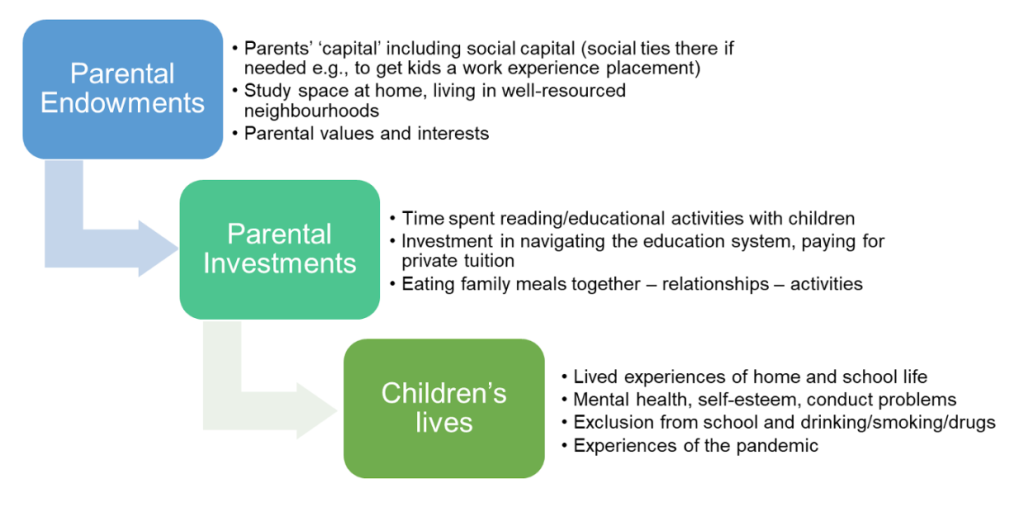
Understanding and measuring socio-economic inequality
The differences between families and between the kinds of lives that children lead are not just about living in poverty versus not being in poverty, but rather they are a gradient. A large body of evidence shows that income and socio-economic resources also matter in the middle: those in medium-high income brackets will do better than those on medium incomes, who do better than those on medium-low incomes. We include 2 measures of socio-economic status for the majority of the analysis in this report: parental class and parental education. Social class background refers to the highest occupational class of either parent and parental educational attainment refers to the highest educational qualification of either parent.
We rely on secondary data sources throughout this report, i.e., drawing on existing surveys of the UK population. Class and education are the 2 measures of socio-economic status for which we have the most consistent measures available. However, for some surveys – particularly those that sample pupils in schools (and where the parents are not interviewed) – we need to rely on proxy measures of socio-economic status such as the Family Affluence Scale, which is based on questions answered by the child on whether their family owns a car, whether they have their own bedroom and computers at home, and travelling abroad.
We do not include income as a dimension of inequality between families, but this is not because we do not think it is important. Income tends to be difficult to measure accurately in surveys, and reluctance to disclose income information means that there are often high levels of missing data. Thus, we do not include it here, but we do assume that income is tightly related to occupation and education. Occupational class is considered a robust indicator of resources because those in the higher categories (higher professional and managerial, for example) are most likely to have a regular salaried income, as well as having the lowest chances of unemployment. Education is important because it often dictates access to those top jobs and parental values.
Our approach in this report is to present socio-economic inequalities – by occupational class and education – in their simplest form, but we acknowledge that there are many complexities in the lived realities of different socio-economic positions. Single parents, for example, may be unable to work because they are taking care of their children full time, and our classification would place them in the ‘lower-working-class’ category, but of course this group could include highly educated parents who are therefore highly resourced in terms of human capital and able to offer their children more hours of educational activities and support than someone working long shifts in a factory.
Ethnicity and immigration status may be an additional dimension of inequality that intersects with class. For example, if qualifications obtained in another country may have less value in the British labour market, here too there could be a mismatch between education or skills and labour market position.
There may be regional differences too. While London and the other big cities may provide the best opportunities for professional jobs, the costs of housing may mean that there is not always space at home despite the family being relatively well off. The breadth of this report means that we are unable to dig into all of these complexities throughout the report. The findings we report by occupational class and education must be conceptualised as an average effect – which is to say, the effect of, for example, having a university degree, averaged out over ethnicity, region, job type and family situation. This simplicity has advantages: it tells a clear story about the extent of inequality in children’s lives.
Part 1. Parental endowments
Main findings
- Social capital: there are stark differences across backgrounds in terms of neighbourhood trust, and levels of satisfaction with local amenities also tend to be higher among parents with higher socio-economic status. These parents also tend to have higher civic engagement and do more volunteering, and when they do, they are more likely to report that they experience social mixing with people from different backgrounds and different neighbourhoods. There are smaller differences in informal networks (having friends to rely on).
- Cultural capital: the types of cultural activities that are most popular include cinema, museums, theatre and live music, and the order of these preferences seems to be the same across all groups. However, the levels of almost all activities are higher among higher socio-economic classes. Looking at the reasons given by parents for not doing these cultural activities, it appears that the higher socio-economic groups are more likely to say they are short of time. The lower socio-economic groups are much more likely to cite poor health as a reason (15% among those with no or low education).
- Values, interests and knowledge: there are some differences in the qualities that parents wish for their children. While ‘thinking for themselves’ is the most desired quality for all parents, higher-educated parents (59%) and those in a higher socio-economic group (63%) are more likely to emphasise it compared with parents with no education or low education levels (33%) and lower-working-class parents (42%). Parents in high socio-economic status groups are more likely to report that their child is likely to go to university (58% among higher professionals versus 35% among lower-working-class parents). Despite this, parents with low socio-economic status show high levels of awareness of the importance of qualifications and good knowledge of the education system. We also report parents’ interest in arts, science, technology, engineering and maths. We find that levels of interest are often low (e.g., below 10% for engineering and maths) but that they are always higher among the parents with higher socio-economic status.
1. Parents’ social capital
We begin this chapter on parental endowments with a look at parents’ ‘social capital’, a term that is still wrangled over by academics and known for being a slippery concept. It captures the benefits that social ties can bring, for example through flows of information, exchange of resources, shaping aspirations, providing mentorship and referrals for jobs. Some examples of social capital in action could include a friend of your mother who knows a journalist who could ‘put in a word’ for a summer internship, or a neighbour looking after the children while parents deal with an emergency.
Some classic definitions of social capital include social relationships and trust in the community or neighbourhood. A famous paper by James Coleman in the 1980s put forward the idea that knowing the parents of your child’s best friend is effectively an additional way to monitor your child’s activities, and is therefore associated with doing well at school. Neighbourhoods are also known to matter to educational outcomes, as they provide a source of role models and connection to wider society beyond the family.
Social capital is therefore broad in its coverage and hard to measure comprehensively. In social surveys, we often rely on ‘indicators’, or a proxy to suggest the existence of social capital rather than measuring it directly. A classic example from Robert Putnam’s famous book Bowling Alone uses civic engagement and volunteering as a key indicator, picking up on being in a book club, organising a kids’ sports team, sitting on a committee, volunteering in a library and so on. There is a long list of possible activities, but the central idea is that these group-based or organisation-based activities bring people together for a purpose, and are likely to foster social connections between people who would not otherwise know each other. These connections go beyond ‘people like me’, providing what Putnam calls “bridging social capital” to facilitate ties to people in different jobs, from different neighbourhoods or different socio-economic backgrounds. A recent study has shown that joining a voluntary association tends to be followed by an increase in the number of “high-status” social ties.
Civic engagement is not the only type of social capital that matters, but we treat it as an indicator of its potential presence. In this section, we follow some of these traditional ideas and look at social trust, civic participation, volunteering and diverse networks, as well as informal social support, which is known to be important for wellbeing and resilience.
Looking at the data, we see first that there is a strong social gradient in neighbourhood trust (Figure 1.1a). Of families in the higher professional class, 76% either strongly agree or agree (13% and 63% respectively) that their neighbours can be trusted compared with 50% of the lower working class (7% and 43% respectively), and there are similar differences when we look at differences by parental education rather than class (Figure 1.1b). More parents in the lower socio-economic groups also respond “neither agree nor disagree” to the question of whether they trust their neighbours. This may reflect the complexity of the lived experience: people may well have good friends among their neighbours but also perhaps some difficult neighbours.
Figure 1.1a: Neighbourhood trust by occupational class
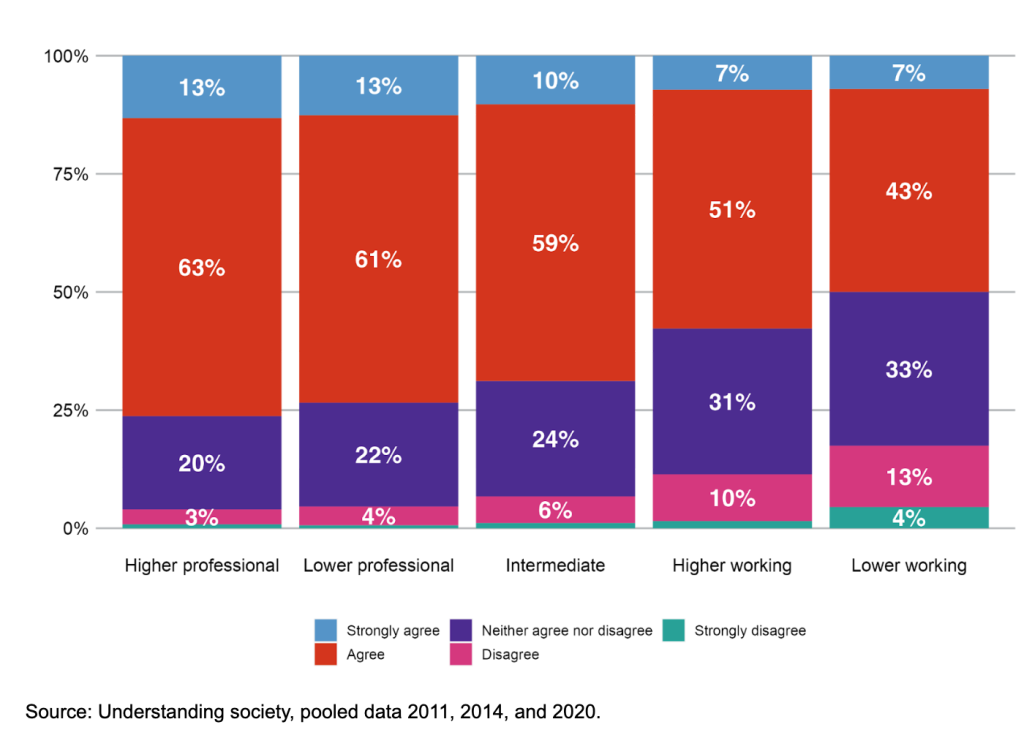
Notes: Children aged 11 to 15; geographical coverage is United Kingdom. Where the label is not shown, the value is 2% or less.
Figure 1.1b: Neighbourhood trust by educational level
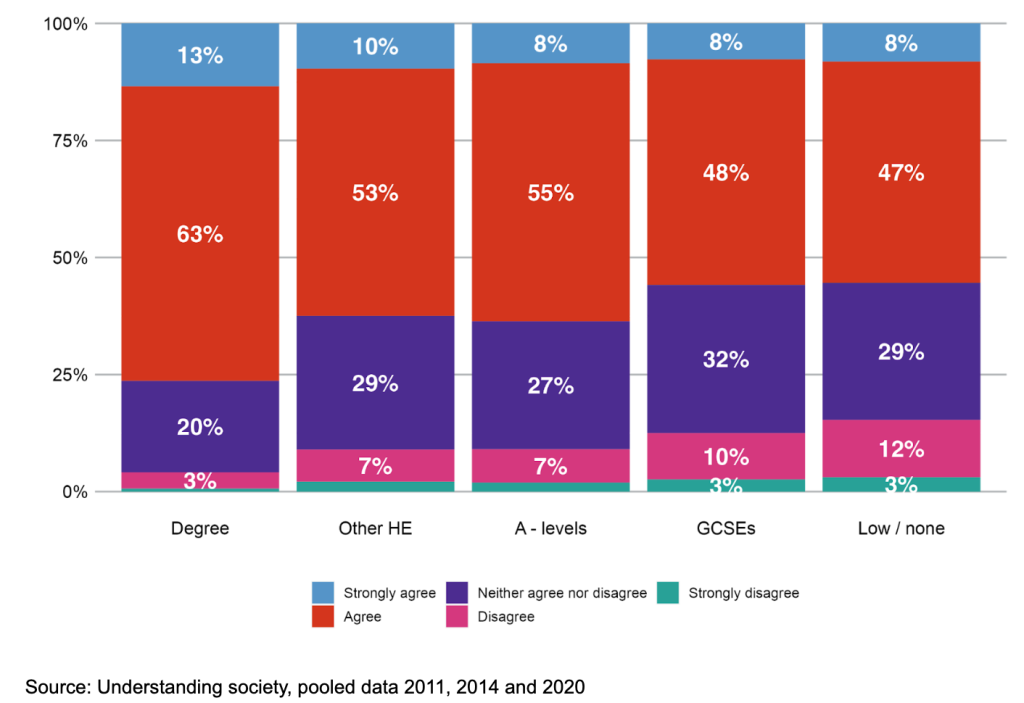
Notes: Children aged 11 to 15; geographical coverage is United Kingdom; HE refers to ‘higher education’. Where the label is not shown, the value is 2% or less.
Our interpretation here is not that those with a higher socio-economic status are more trusting people, but rather that they live in better neighbourhoods, while those in lower working classes or with little education are more likely to be living in neighbourhoods in which antisocial behaviour, crime and other difficult circumstances that affect experiences of community are more prevalent. Some scholars have emphasised the “dark side of social capital”, and parents are likely to be aware that not every social connection is a positive thing. In neighbourhoods with social issues, social connection may be a factor in undesirable outcomes, such as taking drugs or getting involved in crime.
We corroborate this idea by including – in Figures 1.2a and 1.2b – an indicator of how satisfied parents feel about the amenities in their local area. Although we don’t know for sure what people had in their minds as they answered this question in the survey, we can guess that they are concerned with local shops, schools, doctors, parks and public transport. Again, we see socio-economic differences. Of parents in the higher professional class, 34% report being very satisfied and 52% satisfied with their local amenities, compared with 23% and 48% of those in lower-working-class families. The levels look similar when looking at satisfaction by parents’ educational level.
Figure 1.2a: Satisfaction with local amenities by occupational class
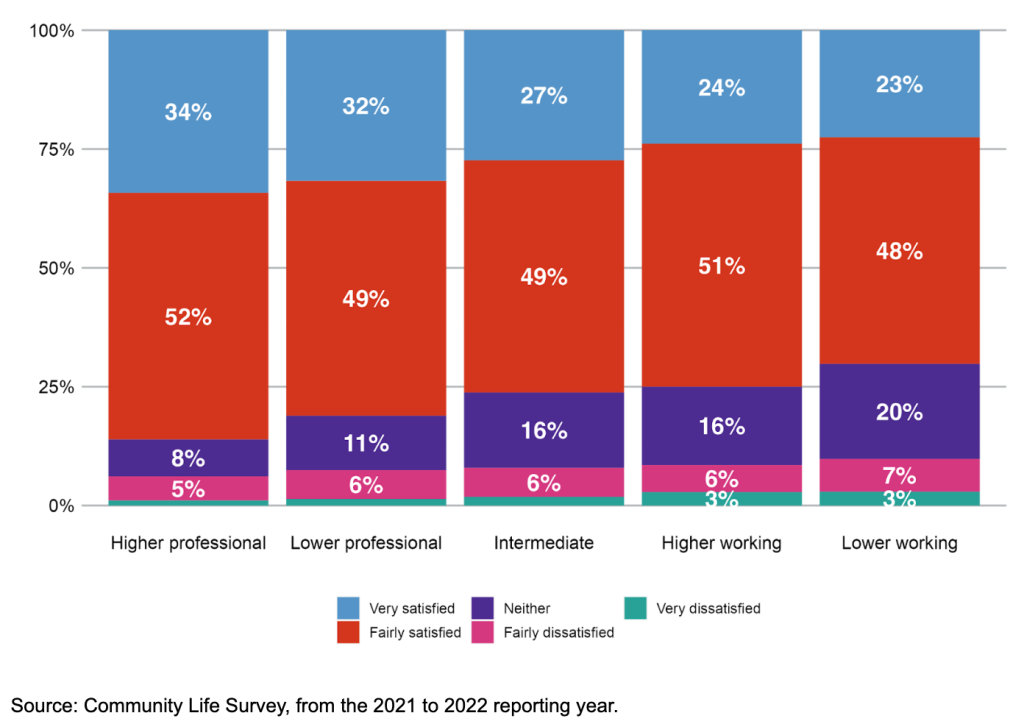
Notes: Parents; geographical coverage is England. Where the label is not shown, the value is 2% or less.
Figure 1.2b: Satisfaction with local amenities by educational level
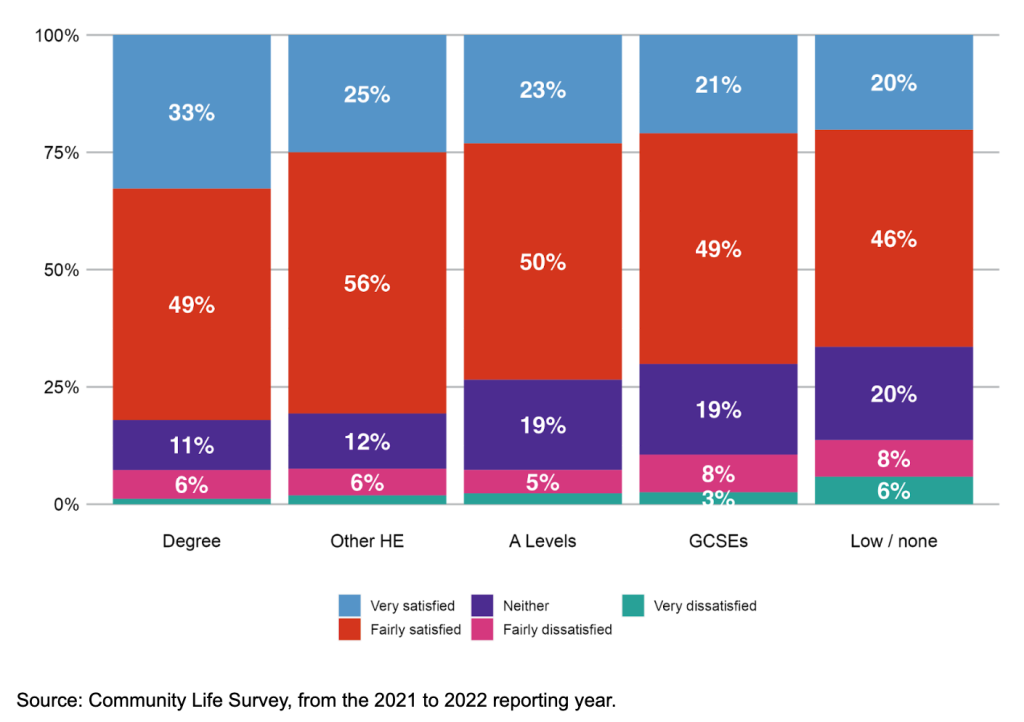
Notes: Parents; geographical coverage is England. HE refers to ‘higher education’. Where the label is not shown, the value is 2% or less.
The next indicator of social capital is civic participation, which is a single measure of whether parents are involved in associations such as a political party, church, trade unions, environmental groups, sports teams and so on. To reiterate, the idea is not that this is an activity that everyone should do, or that this is the only way to build good social networks, but rather that it indicates prosociality and possibly tells us about network reach. Figure 1.3a shows levels of civic participation separately for mothers and fathers, and differences by socio-economic status are evident. For example, over 50% of higher-professional mothers and fathers have civic involvement, compared to just over 30% of those in the lower working class. The gap seems a little larger when looking at parents’ education levels (Figure 1.3b), particularly for mothers.
Figure 1.3a: Civic participation by occupational class – fathers and mothers
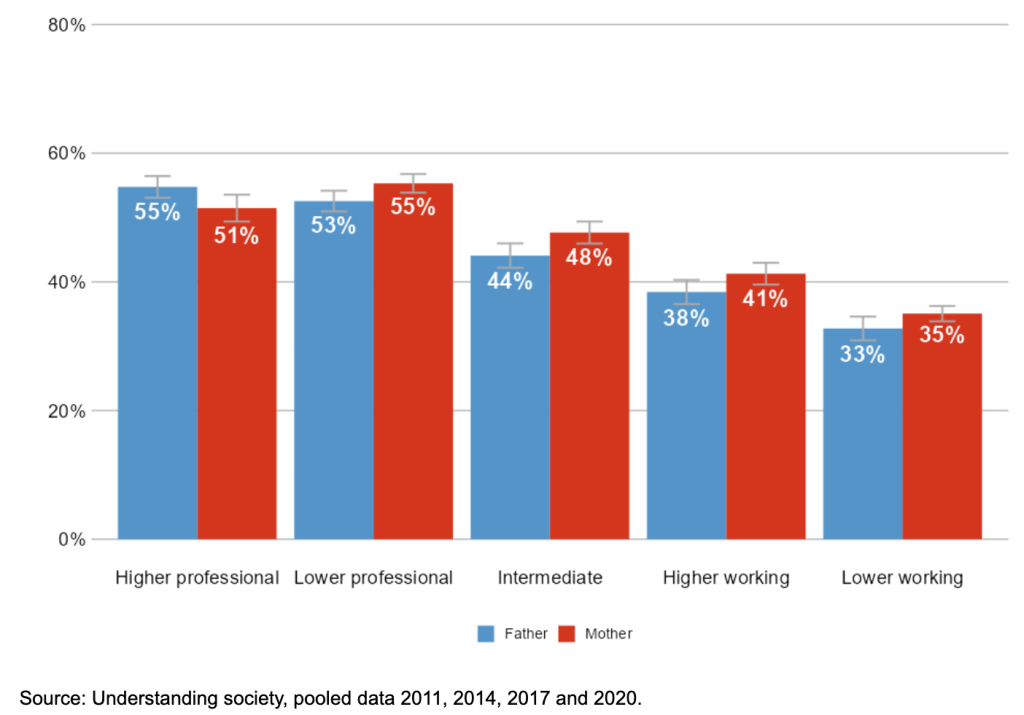
Notes: Parents; geographical coverage is United Kingdom.
Figure 1.3b: Civic participation by educational level – fathers and mothers
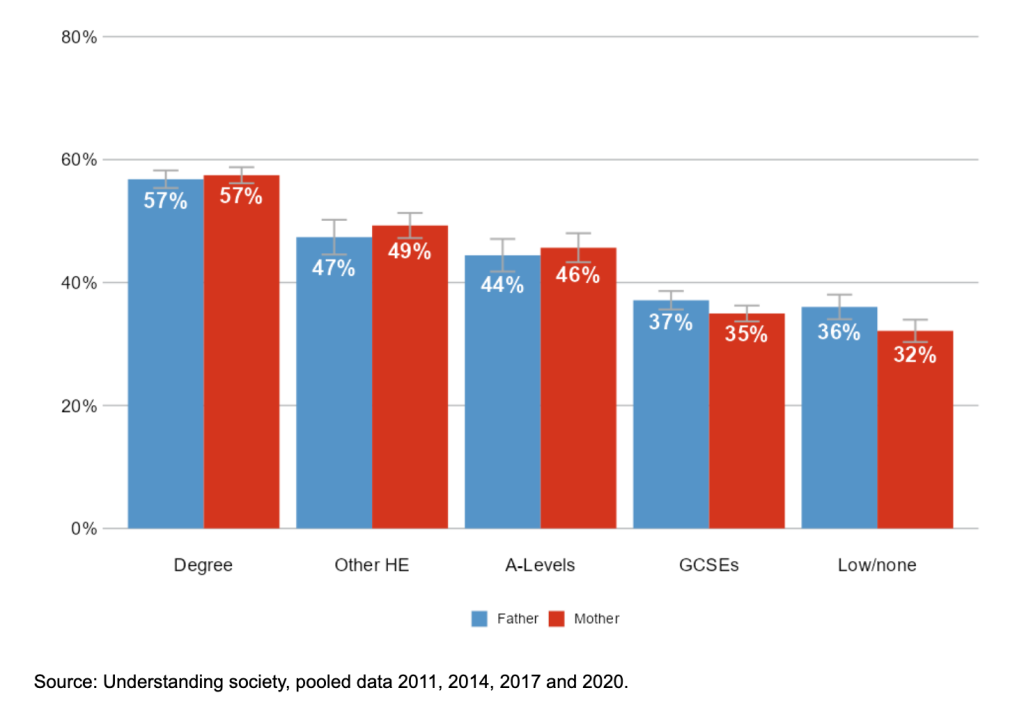
Notes: Parents; geographical coverage is United Kingdom. HE refers to ‘higher education’.
Figures 1.4a and 1.4b show volunteering, a concept closely related to civic participation. The difference is that volunteering involves giving time to an organisation, by helping to run events, sitting on committees, raising money, doing admin work and so on. Here again, we see that rates are lower among the lower working class and the low educated, while the highest volunteering rates are seen among the lower professionals and those with ‘other higher education’.
Figure 1.4a: Volunteering by occupational class
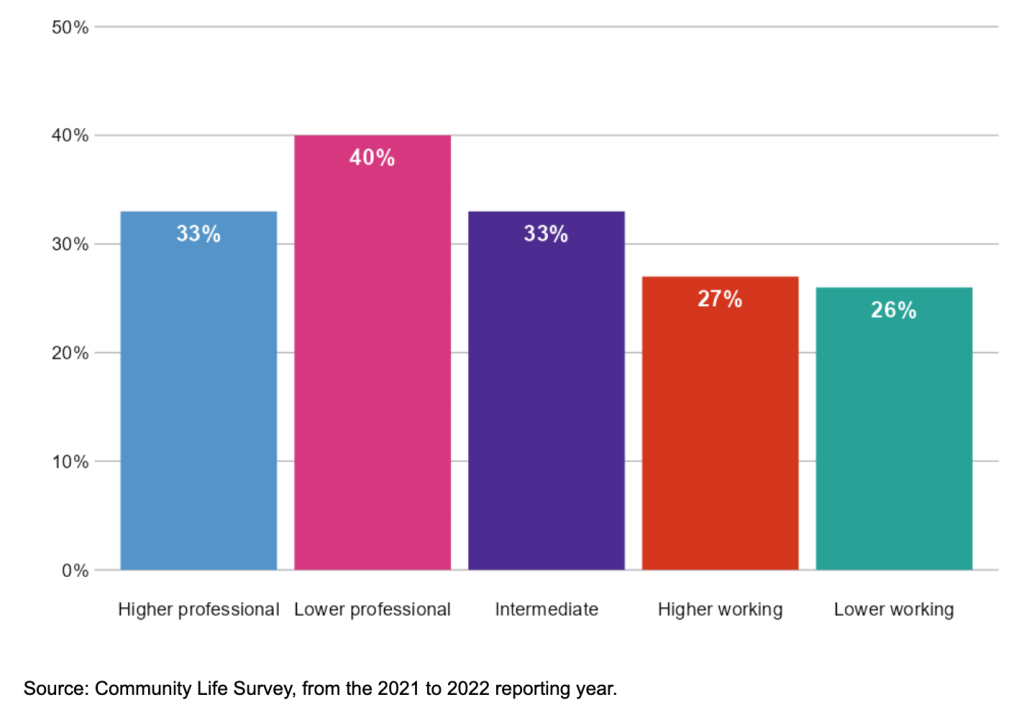
Notes: Parents; geographical coverage is England.
Figure 1.4b: Volunteering by educational level
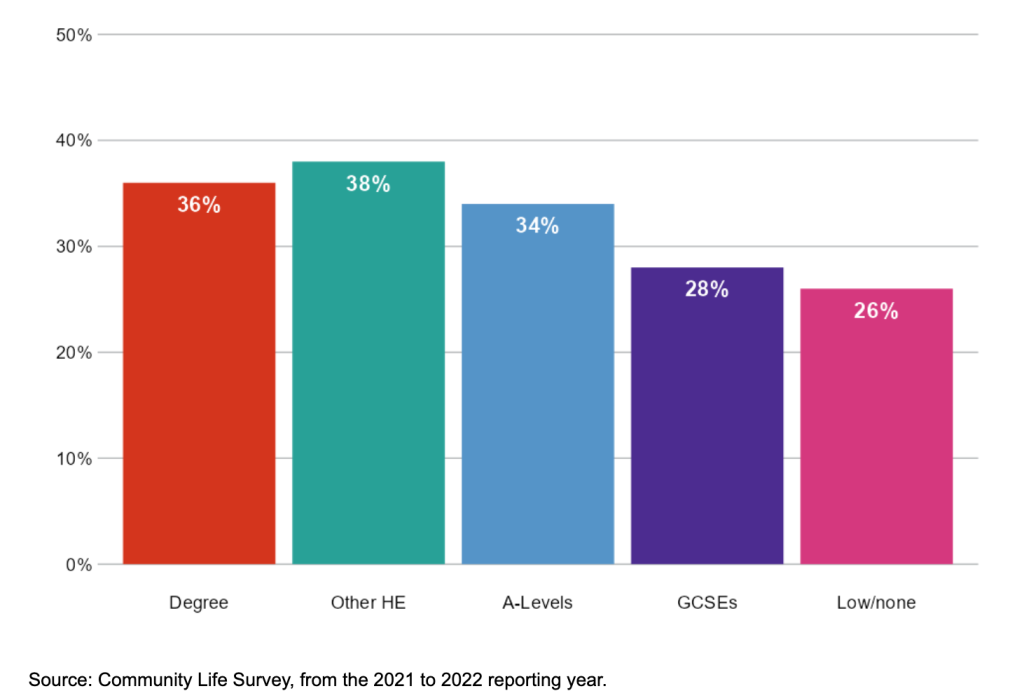
Notes: Parents; geographical coverage is England. HE refers to ‘higher education’.
This question on volunteering, asked in the Community Life Survey, was followed up with some questions about whether parents mix with different types of people through their volunteering activities. The results, as seen in Figure 1.5a, show that people in the lower socio-economic groups are less likely to say that they mix with people from different social and educational backgrounds and from different neighbourhoods. For example, 56% of lower-working-class volunteers say that they mix with people from different backgrounds, compared with 74% of the higher professionals. For mixing with people from different neighbourhoods, this is 61% compared with 47%. There are broadly similar patterns by parental education. If, as the theory suggests, civic participation and volunteering bring the benefit of network diversity, it seems that the value is higher in this regard for people in higher socio-economic positions.
Figure 1.5a: Social mixing among volunteers by occupational class

Notes: Parents; geographical coverage is England.
Figure 1.5b: Social mixing among volunteers by educational level
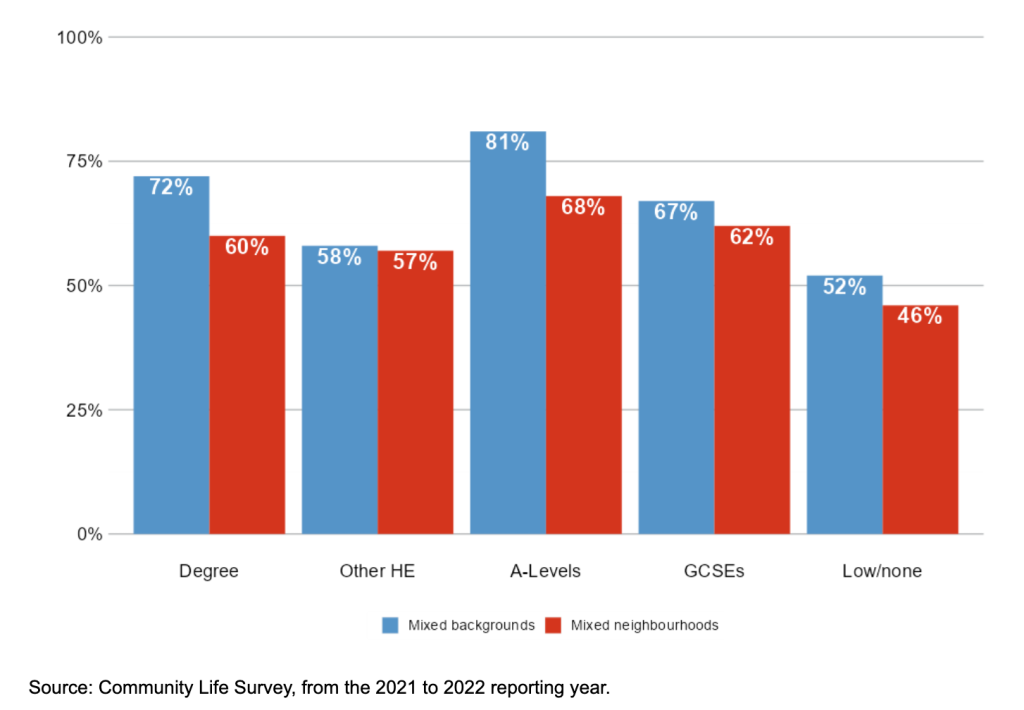
Notes: Parents; geographical coverage is England. HE refers to ‘higher education’.
Our final indicator of social capital is an informal aspect of social relationships, namely feeling that we have friends to rely on (Figures 1.6a and 1.6b). Informal social networks may be important for parents to be able to support their child’s learning, helping them to engage in their child’s education, by providing information flows and social support. Here we see that the inequalities are much lower, with similar percentages across all class and educational groups reporting “a lot” of social support among their friends.
Figure 1.6a: Having friends to rely on by occupational class
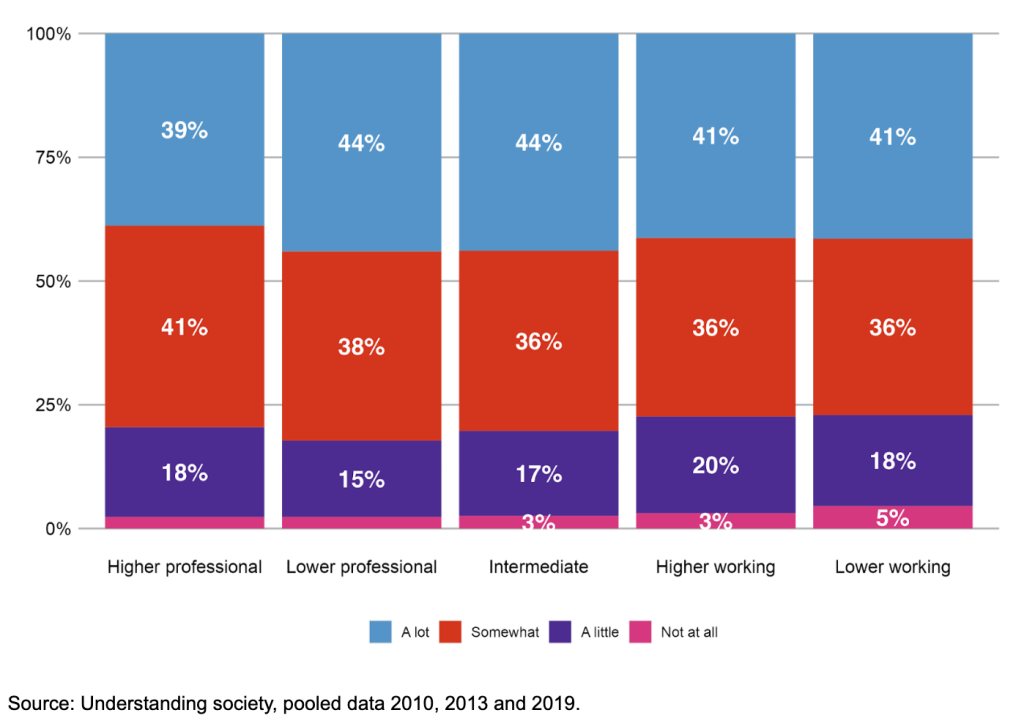
Notes: Parents; geographical coverage is United Kingdom. Where the label is not shown, the value is 2% or less.
Figure 1.6b: Having friends to rely on by educational level
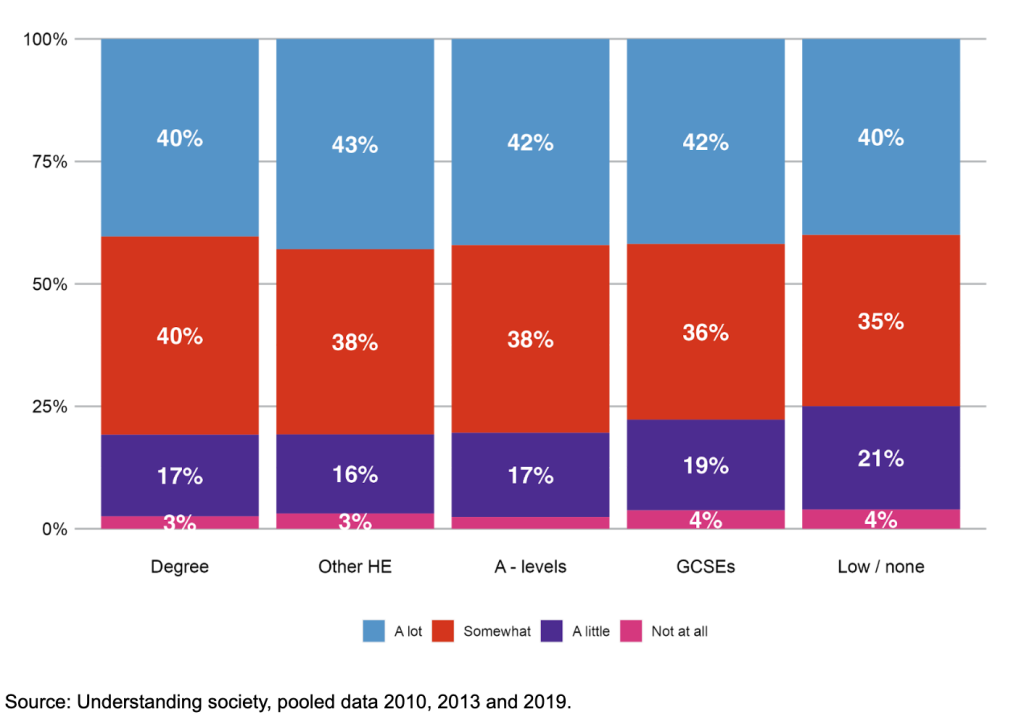
Notes: Parents; geographical coverage is United Kingdom. HE refers to ‘higher education’. Where the label is not shown, the value is 2% or less.
We are aware that in using these typical indicators of social capital, we may be missing some types of social capital that work for people in their community groups. People may well score low on the dimensions of social capital we have covered here but still have such capital through connections to family or local activities that we have not measured.
We also explore these indicators of social capital over time where possible, but we find no clear patterns of change between 2010 and 2020, with the exception that civic participation declined in 2020 – unsurprisingly in the context of the pandemic that shut many social activities down. The decline in 2020 affected families in both high and low socio-economic positions (see Appendix, Figures A1.1 to A1.4).
2. Parents’ cultural capital
Similarly to social capital, ‘cultural capital’ is a term that has been discussed in the academic literature for many decades but remains hard to define. The original theorist, Pierre Bourdieu, hypothesised that having “high-brow” cultural knowledge, for example knowing about the opera or perhaps the sport of polo, would help you to get ahead more than low-brow cultural capital such as pop music and football. Many studies have found an association between doing cultural activities and doing well in school, and in occupational attainment. However, the high-brow/low-brow distinction does not appear to matter; what matters is engaging in any culture at all. The benefits may arise not just from the experience itself, but from being able to talk about it later – to bond with others who have similar tastes in sports or music, for example. Some scholars understand cultural capital to capture a set of “non-cognitive skills”, which provide distinct advantages in education.
We looked at parents’ level of engagement in various cultural activities, which we show in Figure 1.7. Of the particular activities that were measured, we can see that going to see a movie – shown in the blue bar – is by far the most common; 62% of highly educated parents have been to the cinema in the last year compared to 38% of those with no qualifications. Some of the activities listed were uncommon – for example, just 7% of degree-holding parents had been to a dance performance and 13% to a book event. However, even among these more uncommon cultural activities, the parents with higher levels of education tend to do more of them. Attending a sport event is also included, as a single indicator relating to any type of sport. Here, we find that 25% of those with a degree or other professional qualifications have done this in the last year, compared with 19% of those with other qualifications and 16% of those with no qualifications. Note that with this dataset, we were not able to get the same level of detail on education, and we rely on these 4 categories. The patterns by occupational class are similar, and are shown in the Appendix Figure A1.5.
Figure 1.7: Cultural participation by educational level
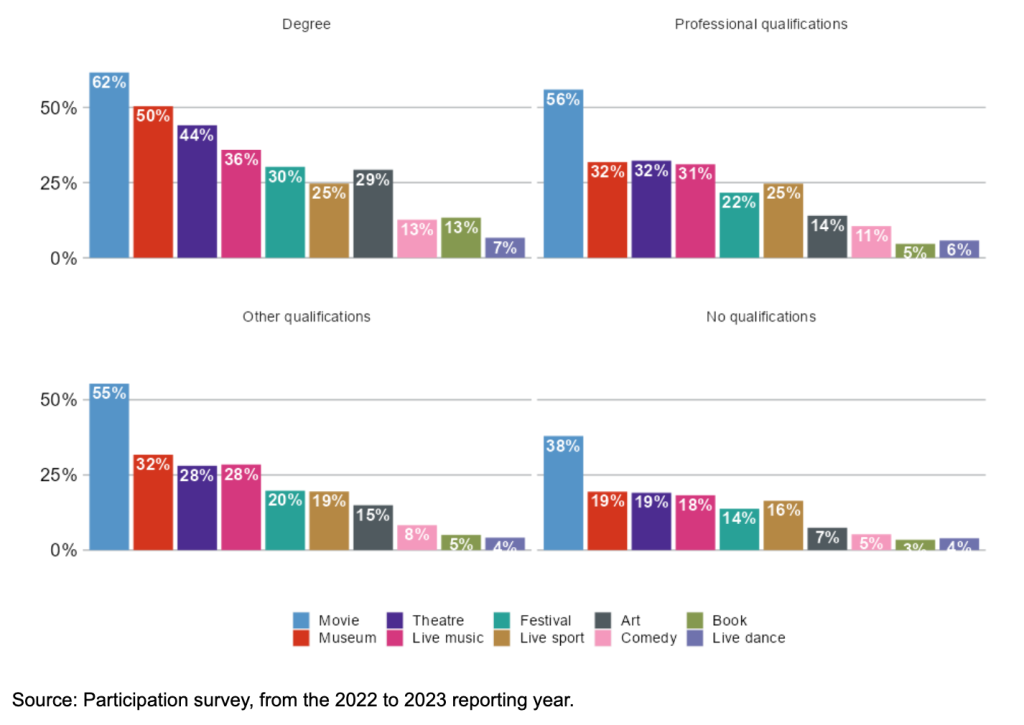
Notes: Parents; geographical coverage is England.
It is worth emphasising that the data on cultural participation does not reveal a pattern of high-brow or low-brow activities, or that different socio-economic groups tend to do different activities. Rather, the rank order of type of activities tends to be very similar across the board, with movies the most popular activity, followed by museums, then theatre and live music. The story here is that those in higher socio-economic positions tend to do more of these cultural activities whatever they are. The participation survey also provided data on online activities, such as streaming TV and music. We show these charts in the Appendix (A1.6) and here too we see higher levels of engagement in online cultural activities among the higher socio-economic group.
The survey participants who reported not having gone to any cultural events in the last year were asked an additional question about their reasons. We show the reported reasons in Figure 1.8. Among higher-professional parents, the most common reason given was not having enough time, whereas among those in the lower working class, not being interested was the most common reason (Figure 1.8a). Poor health was a key barrier to participation among those in the lower class (15%) but not for those in the higher professional class (1%); it is worth remembering that parents who are out of work are included in the lower-working-class category, thus including all those not able to work due to poor health or disability. The pattern is similar when looking at differences by parental education (Figure 1.8b).
Figure 1.8a: Barriers to cultural participation by occupational class
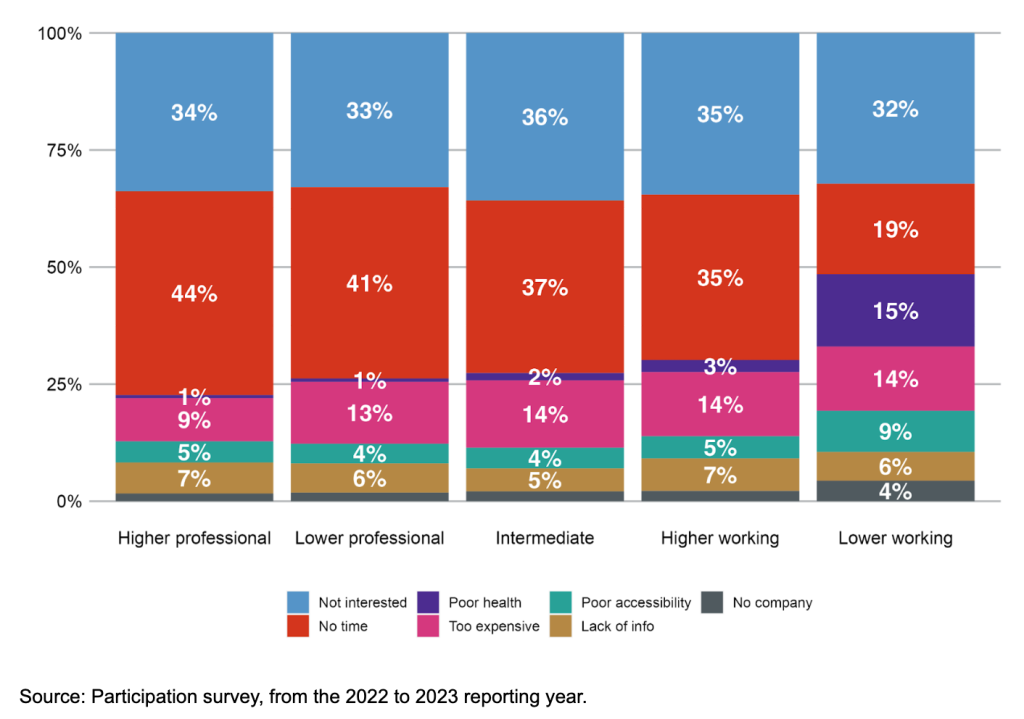
Notes: Parents; geographical coverage is England. Where the label is not shown, the value is 2% or less.
Figure 1.8b: Barriers to cultural participation by educational level
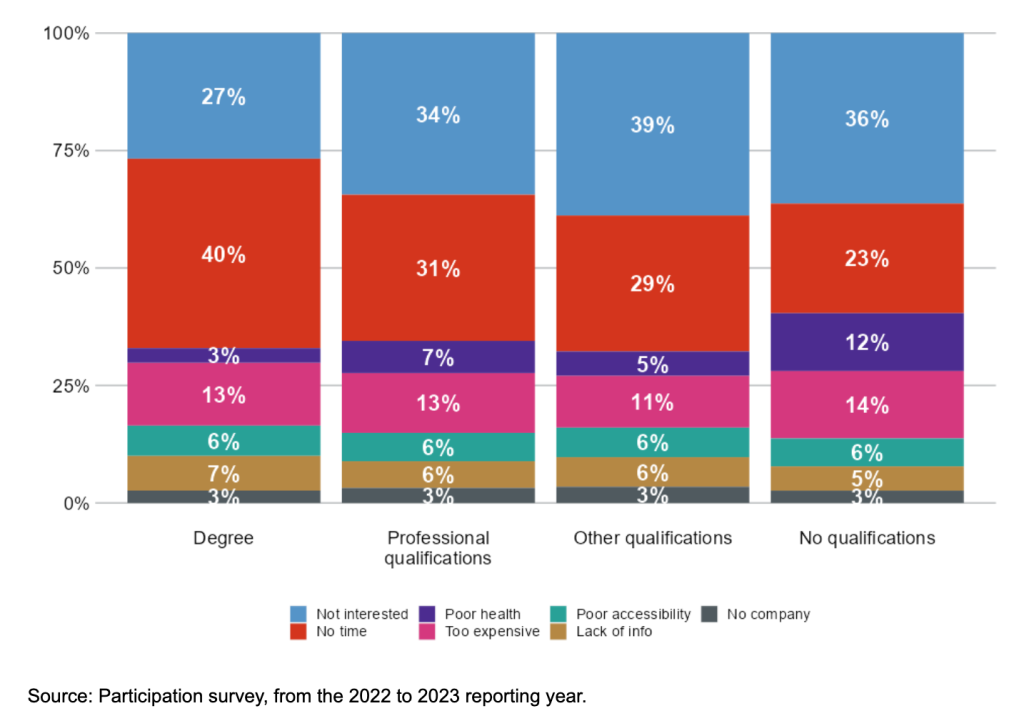
Notes: Parents; geographical coverage is England.
3. Parental values, interests and knowledge
In this section, we explore parental values, aspirations for their children, knowledge about the education system and interests. First we show an indicator of values based on a question asked to parents, when their children were aged around 4 years old, about what qualities they would most value in their children. These values are not directly related to their child’s education but rather are about the type of person parents would like their children to become. This is an area of life in which there are large differences by socio-economic status (see Figure 1.9). Among the higher-professional parents, 63% choose “having their child think for themselves” as the first choice, compared to 42% of lower-working-class parents (Figure 1.9a). Looking at parental education, there is an even larger divide, with just 33% of uneducated parents choosing this as the preferred quality compared to 59% of those with a degree (Figure 1.9b).
The rank order of the top qualities is the same across all socio-economic groups for thinking for themselves and helping others, but lower socio-economic groups are more likely to prioritise obeying parents; 16% of lower-working-class parents choose this compared to just 4% of the higher professionals. Hard work is also more valued among the lower socio-economic groups than the higher.
Figure 1.9a: Parental values (top qualities desired in child) by occupational class
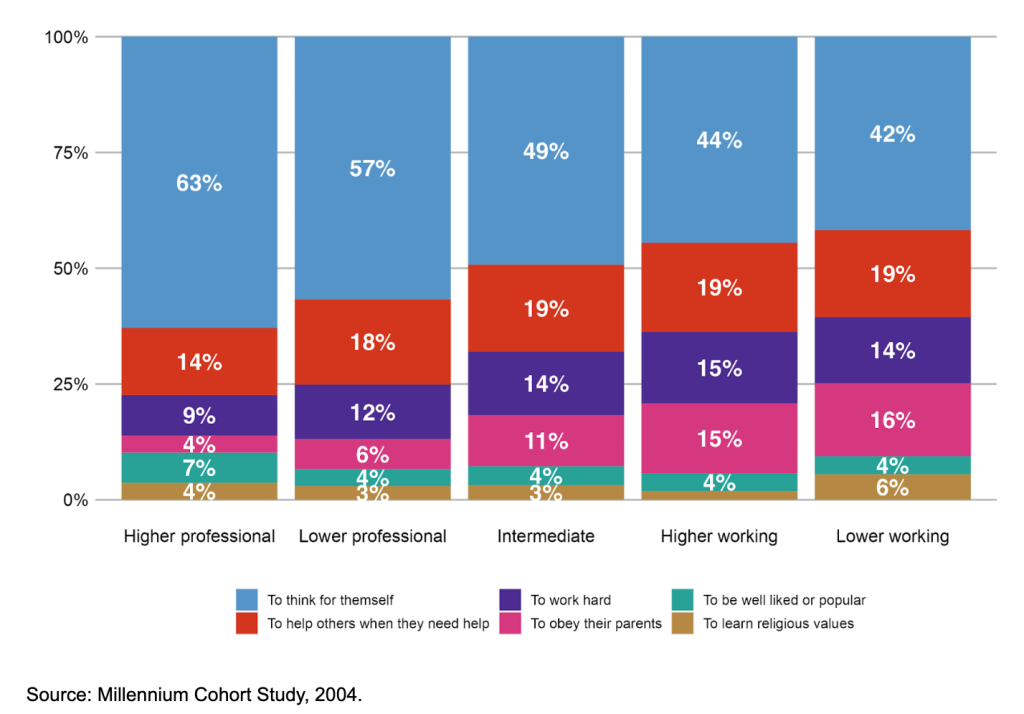
Notes: Parents’ responses when children aged 3 to 4; geographical coverage is the United Kingdom. Where the label is not shown, the value is 2% or less.
Figure 1.9b: Parental values (top qualities desired in child) by education level
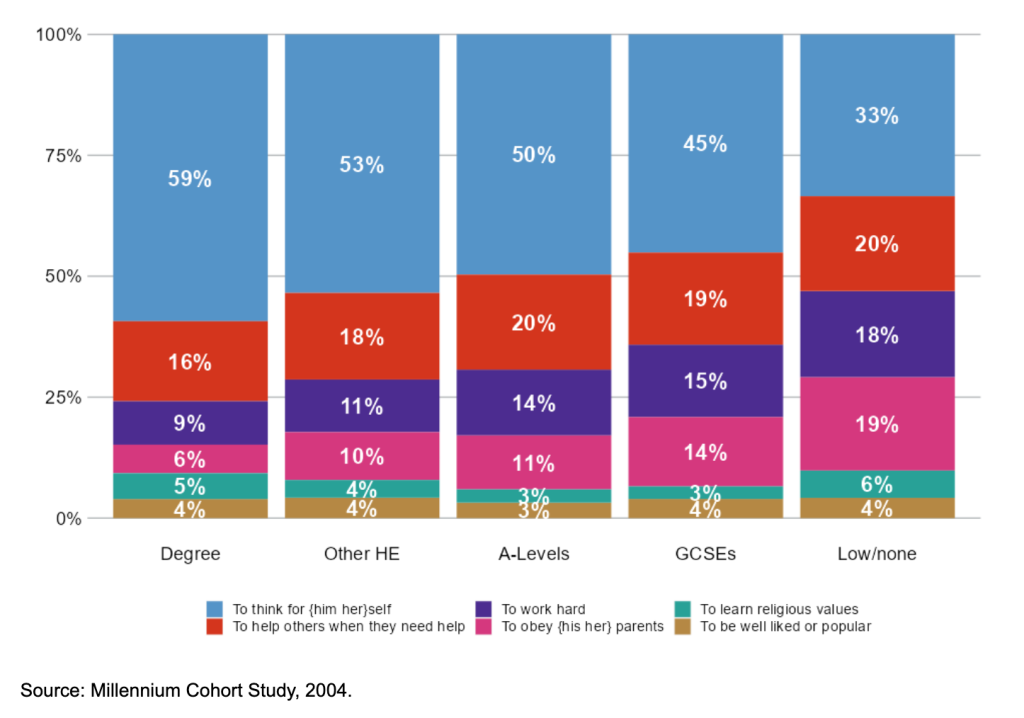
Notes: Parents’ responses when children aged 3 to 4; geographical coverage is the United Kingdom.
Some scholars have put forward the idea that parents’ values will be influenced by the type of work they do. For example, if a parent in a working-class job such as in a factory or a call centre has the experience that doing well at work means ‘toeing the line’, being on time and so on, they may well think that it is important to obey one’s seniors. It would be interesting to observe if people change their values as parents as they advance their education. We do not have the data to examine this question exactly, but previous research has shown that increases in educational attainment during adulthood are associated with changing attitudes to authority, alongside other outcomes.
Aspirations – what parents want for their children – are often considered to be an important part of parenting. They could be considered a type of value. Figures 1.10a and 1.10b show parents reporting the likelihood that their children will go to university to get a degree, asked when their children were in year 11 at school, aged 15 or 16 years old. Of course, the timing of the measurement may mean that parents take into consideration their children’s own preferences or academic abilities in their answer. Among higher-professional parents 58% say that their child is very likely to go to university and a further 26% say that this is fairly likely (Figure 1.10a). Among lower-working-class parents, 35% say very likely and 33% say their child is fairly likely to go to university.
Thus, while there is a difference between parents of higher and lower socio-economic status in this regard, the level of aspiration among lower-working-class parents is still fairly high. There are similar patterns by education but here, interestingly, it is revealed that parents with low or no education have higher aspirations for their children to go on to university than do those with GCSEs, A-levels or other higher education (Figure 1.10b). It seems, then, that having a low level of education does not hold parents back from wanting their children to obtain a university degree.
Figure 1.10a: Likelihood that child will go on to university by occupational class
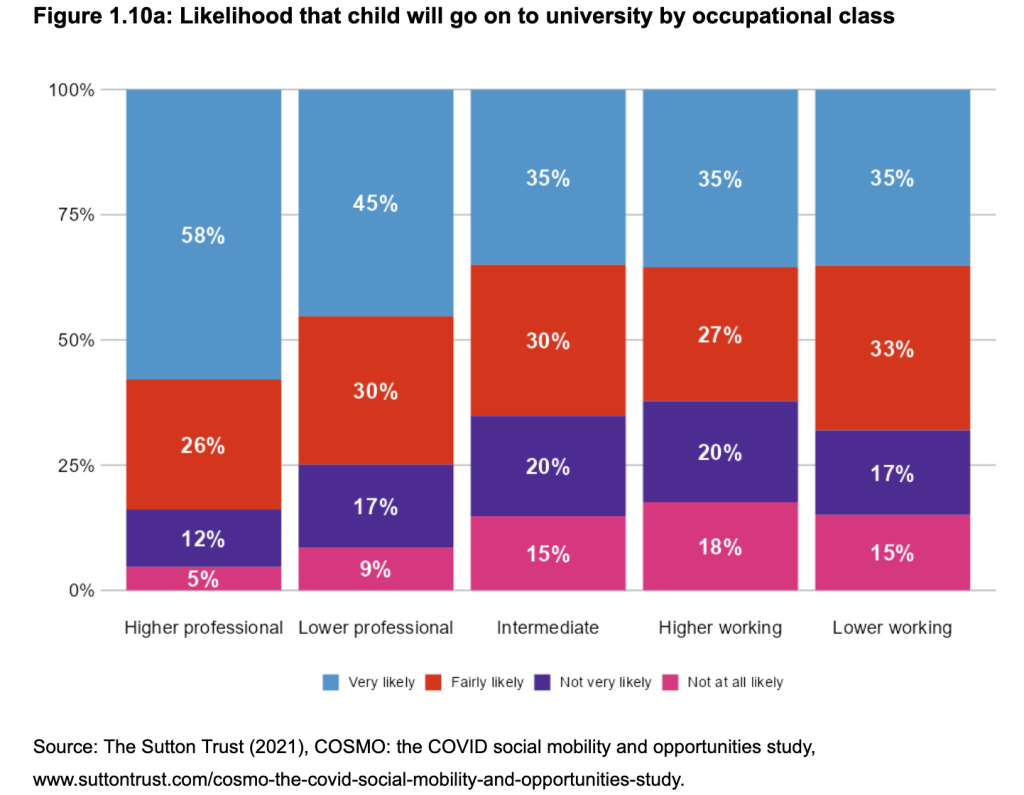
Notes: Parents’ responses when children were in year 11 (aged 15 to 16); geographical coverage is England only.
Figure 1.10b: Likelihood that child will go on to university by educational level
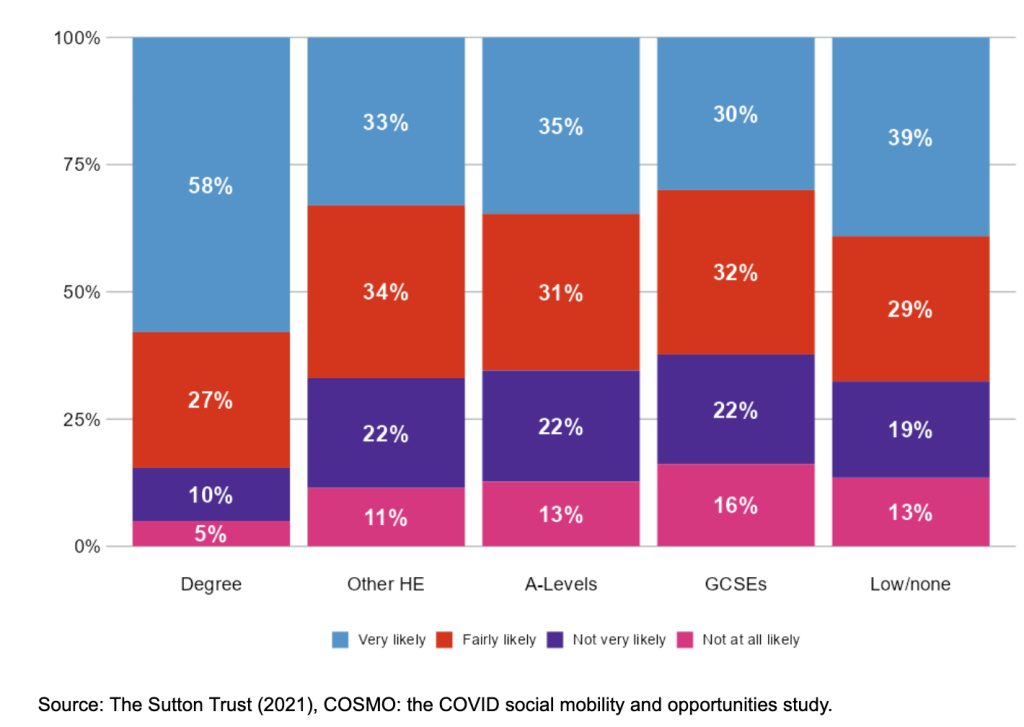
Notes: Parents’ responses when children were aged 15 to 16; geographical coverage is England only. HE refers to ‘higher education’.
This is further supported by an additional question where parents responded to the statement “Nowadays you need qualifications in order to get a job worth having”. Figures 1.11a and 1.11b show that 85% of parents in the lower working class and 87% of parents with low or no education strongly agree with this statement, compared to 53% and 49% of higher professionals and degree-educated parents, respectively. Thus, parents are well aware of the need for their children to obtain qualifications.
Figure 1.11a: “Nowadays you need qualifications in order to get a job worth having” by occupational class
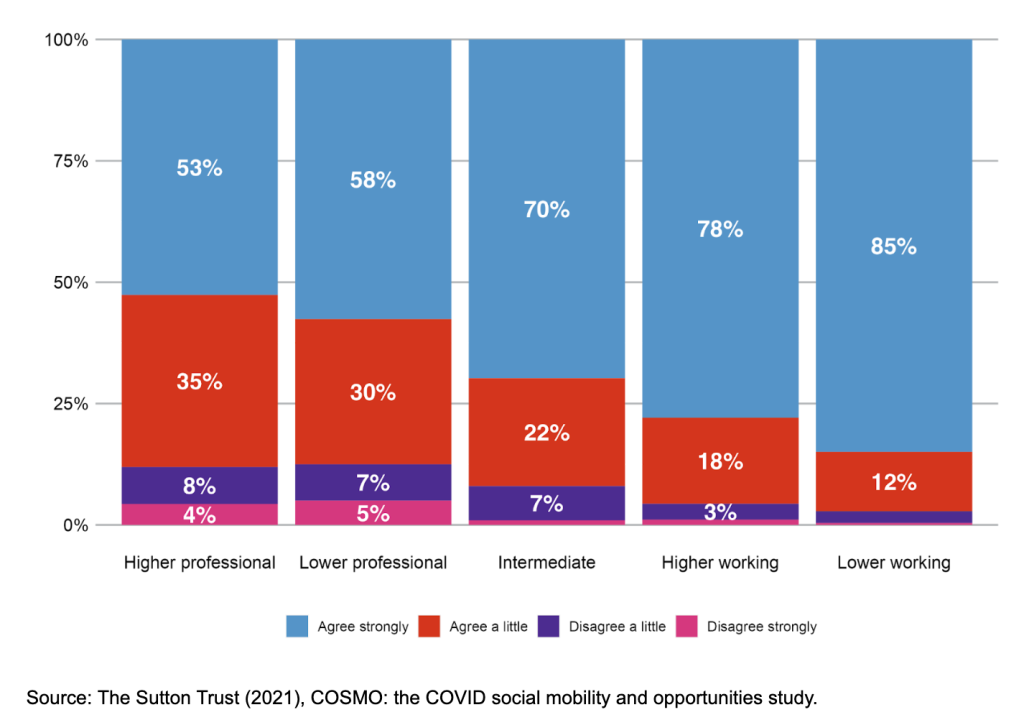
Notes: Parents’ responses when children were aged 15 to 16; geographical coverage is England only. Where the label is not shown, the value is 2% or less.
Figure 1.11b: “Nowadays you need qualifications in order to get a job worth having” by educational level
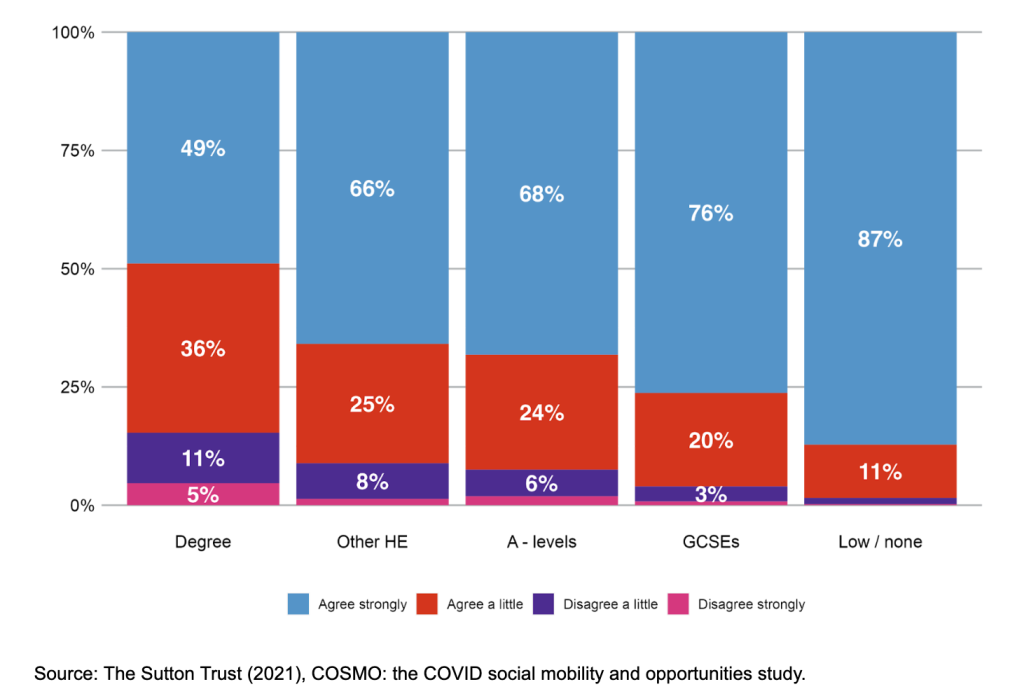
Notes: Parents’ responses when children were aged 15 to 16; geographical coverage is England only. HE refers to ‘higher education’. Where the label is not shown, the value is 2% or less.
The academic literature on social mobility has suggested that knowledge of the education system is likely to be a key way in which parents pass along their advantage. After all, if parents are university-educated, they are more familiar with how it works, how to apply, what the best places and courses might be and so on. We show parental knowledge of the education system in Figures 1.12a and 1.12b, based on agreement with the statement “I know all I need to know about how I can help with their education”. The results reveal that confidence in knowledge of the education system appears to be high across the board. Among higher-professional parents, 40% strongly agree and a further 48% agree that they know what they need to know in order for their child to do well (Figure 1.12a). Among lower-working-class parents, 42% strongly agree and 40% agree. Thus, there is only a small difference between socio-economic groups. This is also the case when looking at patterns by parental education (Figure 1.12b).
Figure 1.12a: Parents’ knowledge of education system by occupational class
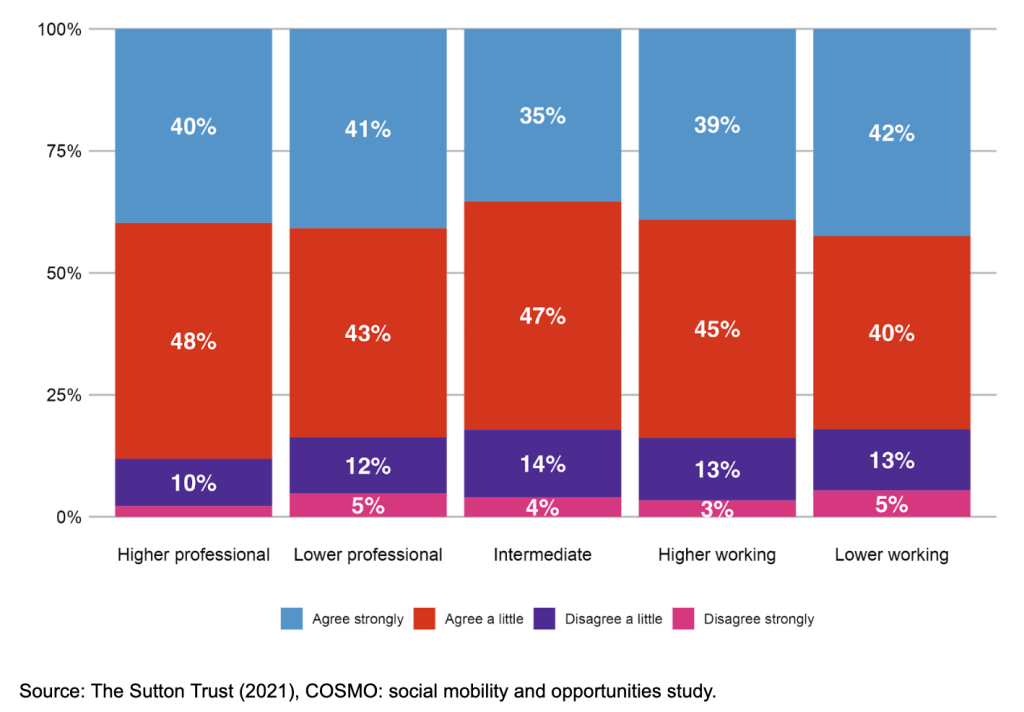
Notes: Parents’ responses when children were aged 15 to 16; geographical coverage is England only. Where the label is not shown, the value is 2% or less.
Figure 1.12b: Parents’ knowledge of education system by educational level
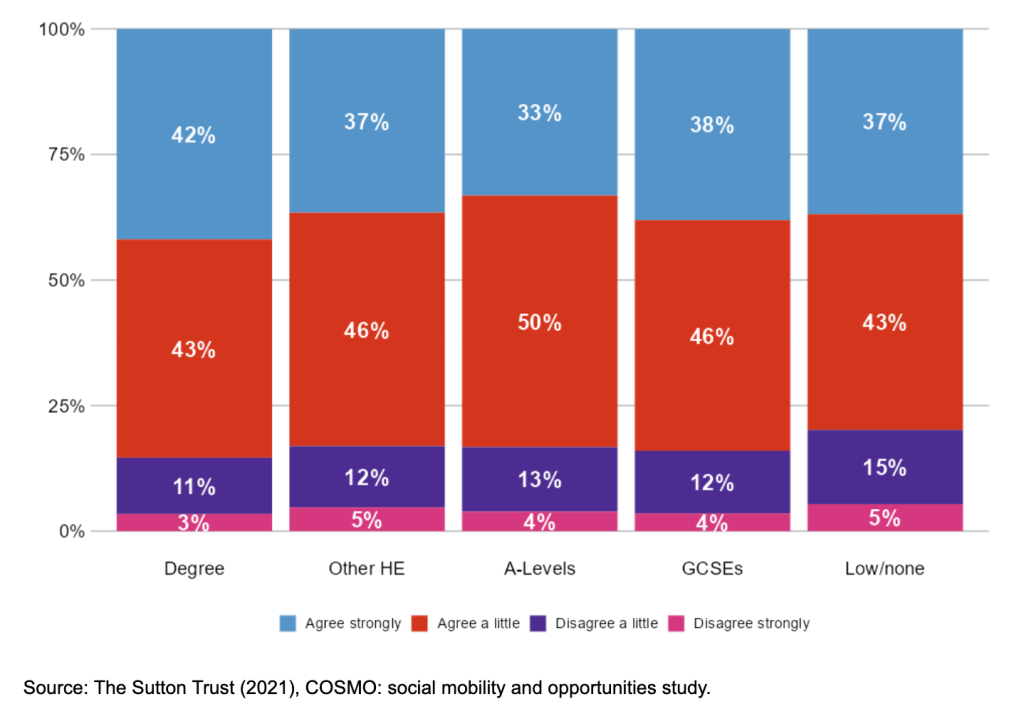
Notes: Parents’ responses when children were aged 15 to 16; geographical coverage is England only. HE refers to ‘higher education’.
Finally in this chapter, we include a measure of how interested parents are in ‘STEAM’ subjects, which stands for science, technology, engineering, arts and maths. This could be considered another aspect of cultural capital, but more broadly it is likely to be another resource that parents have that can be passed along to children, in developing their understanding of academic subjects and helping with advanced-level homework or university applications. Figure 1.13 shows that levels of interest in any subject are higher among degree-educated parents than those with lower qualifications. Interest in maths is low across all groups, at 5% for degree holders and 3% for those with no qualifications. There is also a striking difference in interest in the arts: 31% among parents with a degree but 11% among parents with no qualifications. This could be consequential for young people who want to pursue arts-based careers; such a choice is often considered to be financially risky, but parents with higher levels of education and in higher occupational classes would be better placed to support a child’s career choice. We include the chart by occupational class in the Appendix (Figure A1.7)
Figure 1.13: Parents’ interest in science, technology, engineering, arts and maths (STEAM) by educational level
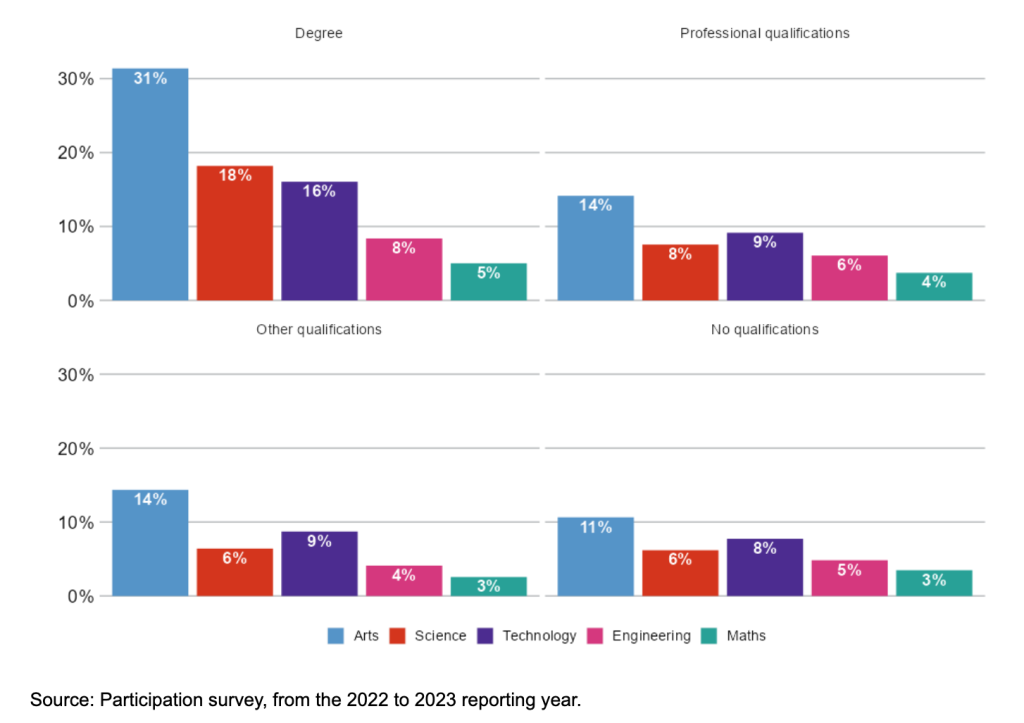
Notes: Parents; geographical coverage is England.
Part 2. Parental investments
Main findings
- The picture is mixed in terms of the type of ‘investments’ in a home learning environment, such as doing activities and helping with homework. We do not see a uniform picture of parents in a lower occupational class or less-educated parents lacking in investments in terms of activities with their children. In many cases they actually do more than more-advantaged parents, and for some activities such as music, stories and arts, the picture is one of greater inequality within lower socio-economic groups, i.e., more children do daily activities but there are also more who never do these things.
- Time use data shows that mothers with higher socio-economic status spend on average 79 minutes per weekday on ‘developmental activities’ – reading and playing with their young children – compared with 50 minutes for lower-working-class mothers.
- There are moderate gradients in parental monitoring, talking about things that matter, discussing school reports, and quarrels, although the overall ‘parenting styles’ seem to be very similar across socio-economic groups.
1. The home learning environment
In this section, we consider various aspects of parental investments that relate to the home learning environment, and a range of learning enrichment activities, as well as activities directly related to schooling. Our evidence here is largely drawn from the Millenium Cohort Study, which followed a cohort of babies born in 2000 and 2001. It asked different questions in different years, and the evidence therefore relates to children of different ages.
First, looking at helping children with aspects of their schoolwork, we show the frequency of helping with maths homework (Figures 2.1a and 2.1b) and with writing (Figures 2.2a and 2.2b) when children are of school age (an average at 2 time points, when children are aged 8 and 12). These charts reveal a generally high level of parental investment in this area of life, with almost all parents helping children once or twice a week or more.
Figure 2.1a: Helping with maths homework by occupational class
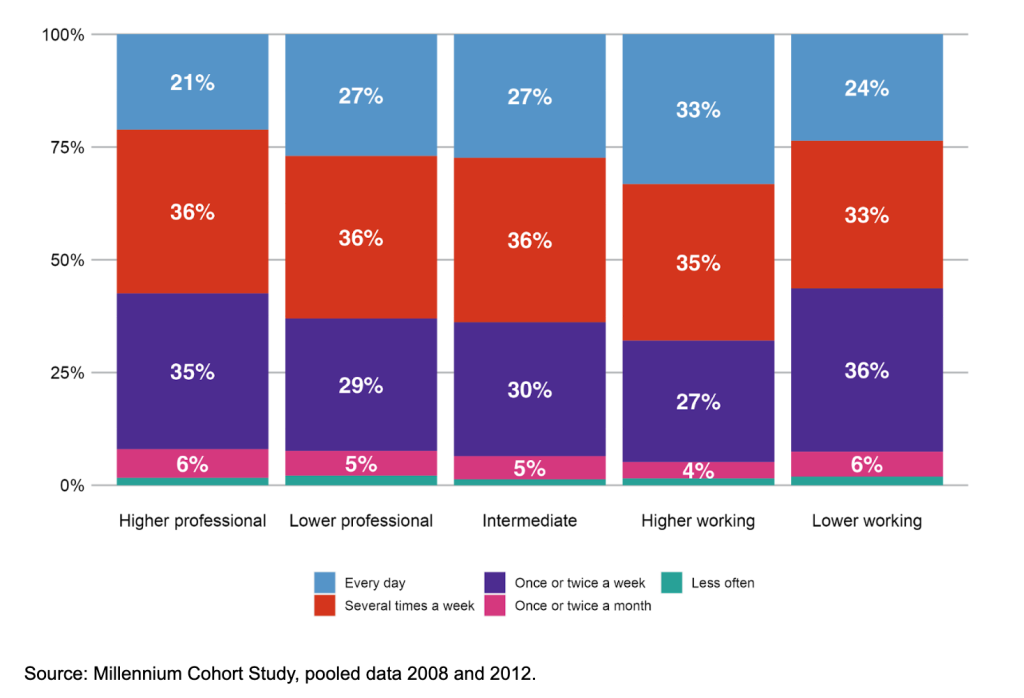
Notes: Parents’ responses when children aged 8 and 12; geographical coverage is the United Kingdom. Where the label is not shown, the value is 2% or less.
Figure 2.1b: Helping with maths homework by educational level
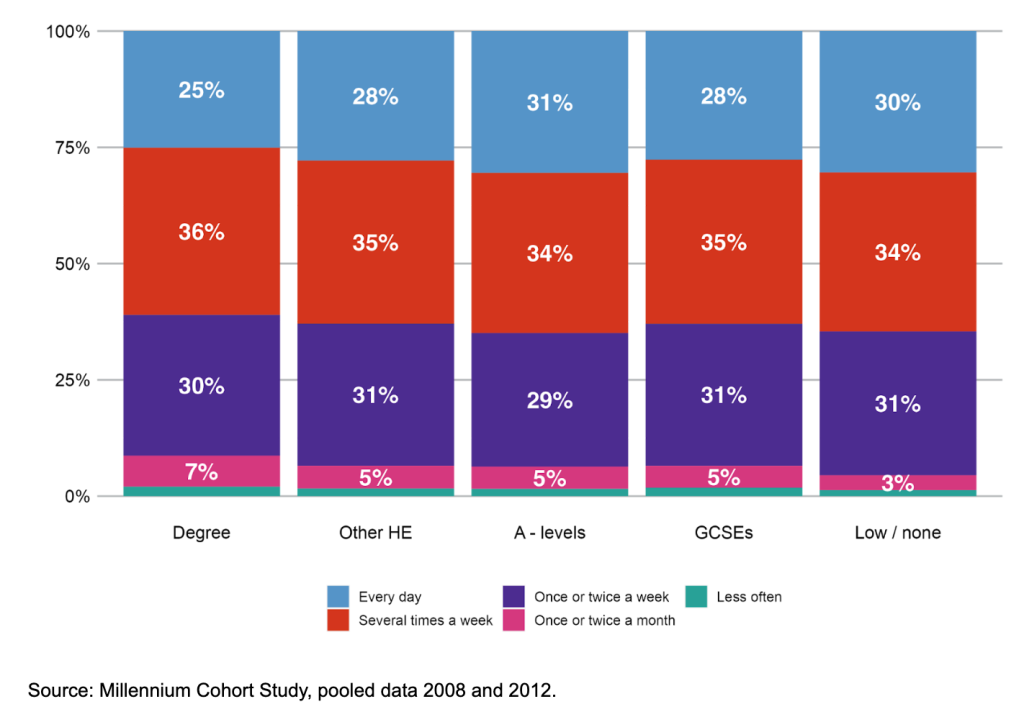
Notes: Parents’ responses when children aged 8 and 12; geographical coverage is the United Kingdom. HE refers to ‘higher education’. Where the label is not shown, the value is 2% or less.
Figure 2.2a: Helping with writing by occupational class
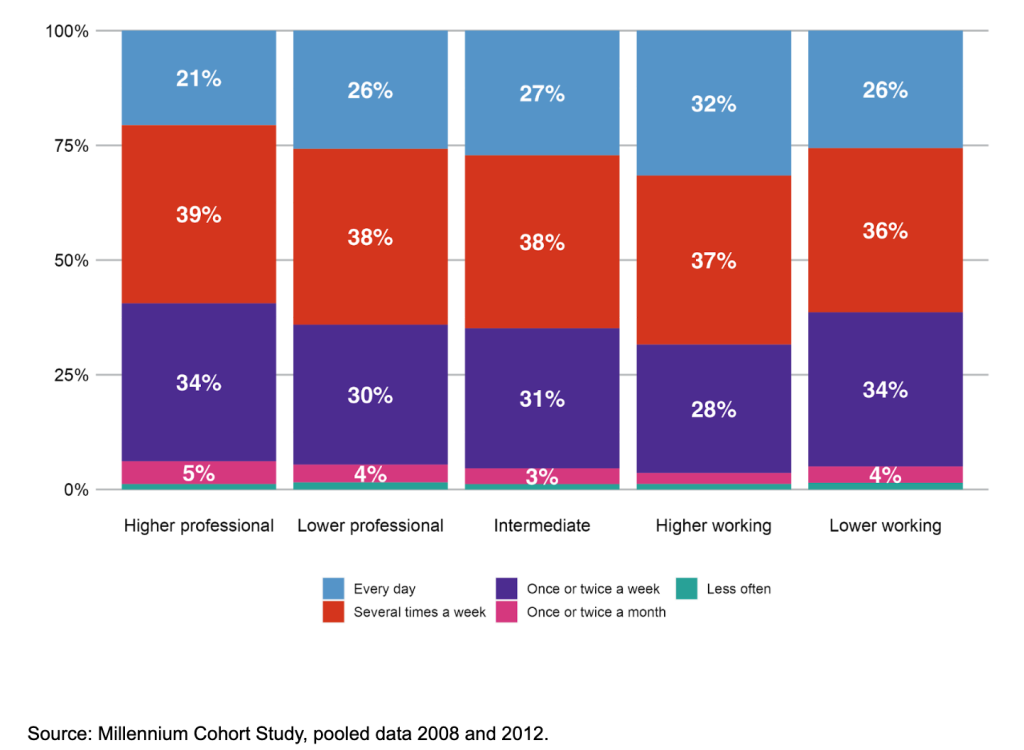
Notes: Parents’ responses when children aged 8 and 12; geographical coverage is the United Kingdom. Where the label is not shown, the value is 2% or less.
Figure 2.2b: Helping with writing by educational level
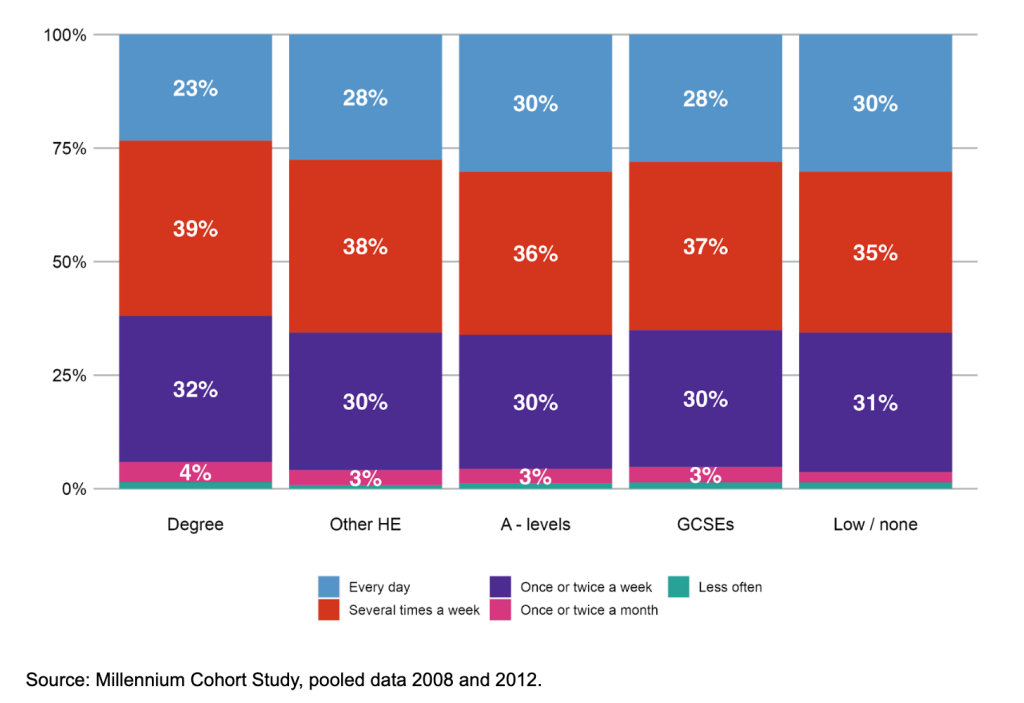
Notes: Parents’ responses when children aged 8 and 12; geographical coverage is the United Kingdom. HE refers to ‘higher education’. Where the label is not shown, the value is 2% or less.
In terms of the socio-economic differences, we find that those in the lower working class and in the low or no education group do just as much as parents in higher socio-economic groups, and sometimes more: 24% of lower-working-class parents help their children with maths every day, for example, compared to 21% of higher-professional parents (Figure 2.1a). Similarly, 26% of lower-working-class parents help with writing every day compared to 21% of parents in the higher professional class (Figure 2.2a). In terms of occupational class, it is the higher-working-class parents who are most likely to help every day, and in terms of parental education it is the parents with low or no education most likely to do so. It could, of course, be argued that perhaps the children in these groups need more help with their homework, and that the higher professionals and degree-educated parents are putting their values (as we discussed in the last section) into force, encouraging self-sufficiency in their children. The professional-class families could also be paying for private tutoring, removing some of the need for their own time, though our findings (see Figures 2.7a and 2.7b) are ambiguous on this. Either way, we do not see a pattern of the lower socio-economic groups investing less time in this regard.
The pattern with regard to reading to children is slightly different (Figures 2.3a and 2.3b). Here, there is more evidence for a gradient where the higher socio-economic groups are doing more – a pattern particularly prominent when looking at parental education rather than class (Figure 2.3b). Of parents who hold a degree, 37% read to their young child every day compared to 26% of those with low or no education. There are also large differences evident when we look at the “less often” or “not at all” categories, which comprise 15% for those with low or no education compared to just 5% for the degree-educated. For reading in particular, then, it seems that education is the key dimension of socio-economic status, perhaps because reading is highly valued throughout the education system and understood to be the key skill for independent study (at university) as well for learning about other subjects. These results are consistent with the 2016 report, which showed that by 2006, only around 3% of higher-professional-class mothers read to their children less than weekly, and around 10% of working-class mothers.
Figure 2.3a: Reading to child by occupational class
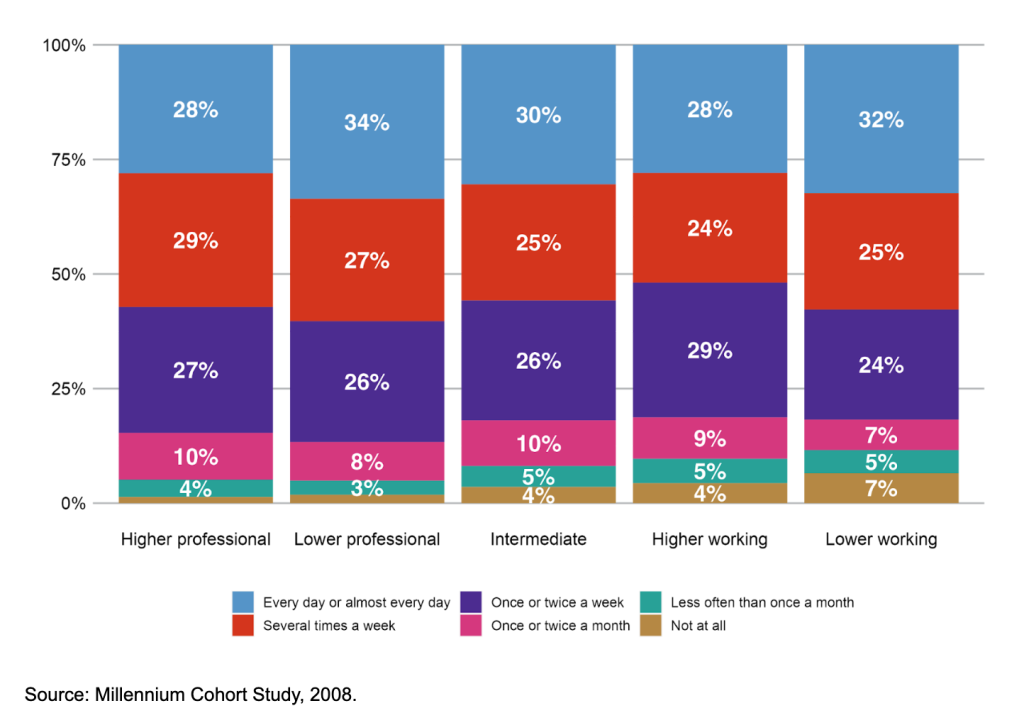
Notes: Parents’ responses when children aged 8; geographical coverage is the United Kingdom. Where the label is not shown, the value is 2% or less.
Figure 2.3b: Reading to child by educational level
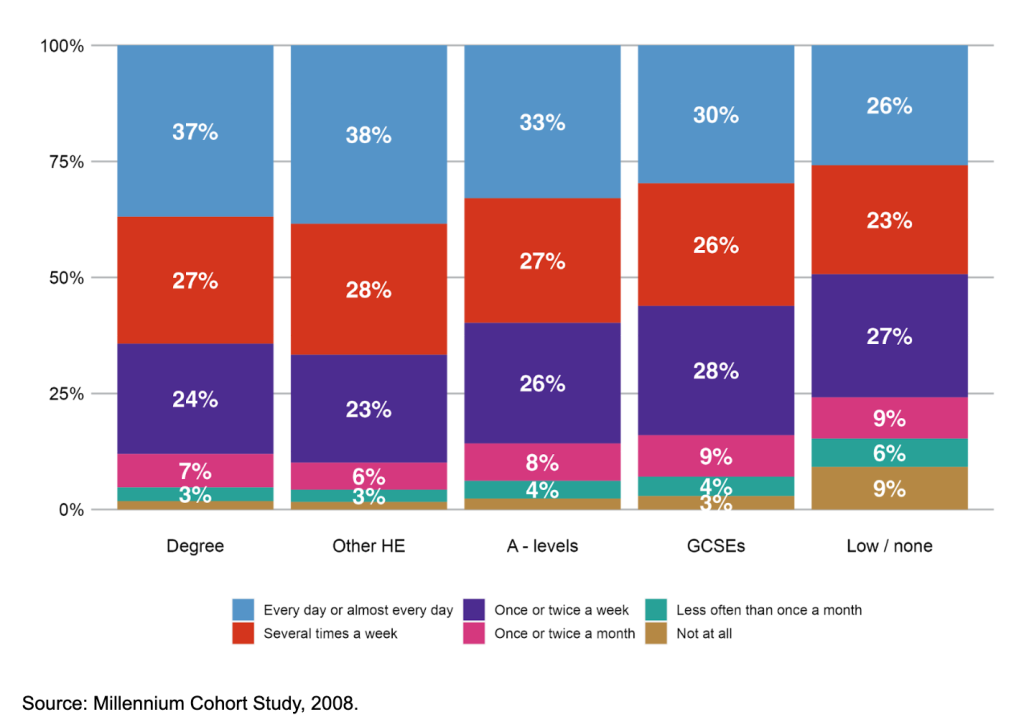
Notes: Parents’ responses when children aged 8; geographical coverage is the United Kingdom. HE refers to ‘higher education’. Where the label is not shown, the value is 2% or less.
We have 2 further indicators of the home learning environment when children are aged 8, shown in Figures 2.4 and 2.5 for doing musical activities with children and telling stories to children. Music-based activities include listening to music, dancing and playing musical instruments. These activities – which we might think of as providing a stimulating learning environment although they are less directly related to schooling – demonstrate a different pattern.
Looking at the top and bottom categories, representing the most and least frequent activities, we see that lower-working-class parents are more likely to do more of these activities than higher-professional parents (30% compared to 18% for musical activities every day) but also more likely to do fewer (10% compared to 6% for never). There are correspondingly more children falling into the middle-frequency items among the higher socio-economic group than the lower. This highlights 2 important points: first, experiences of being a child in a lower-working-class household are diverse, and second, there is greater inequality in these activities for those in the lower working class. We show similar patterns with drawing and painting in the Appendix (Figure A2.1).
Figure 2.4a: Doing musical activities with child by occupational class
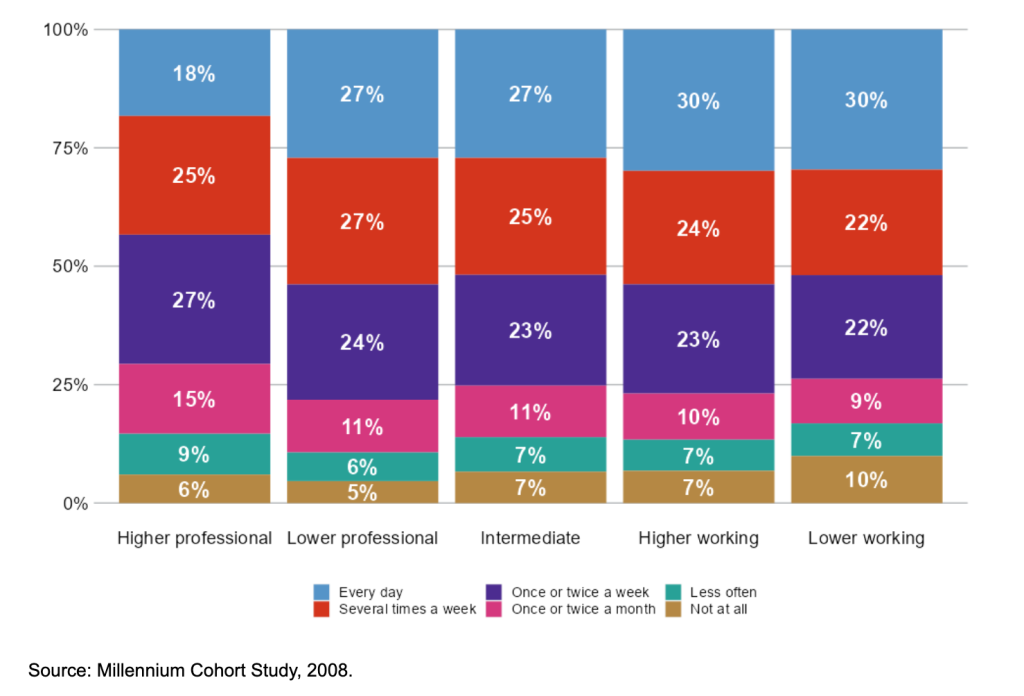
Notes: Parents’ responses when children aged 8; geographical coverage is the United Kingdom.
Figure 2.4b: Doing musical activities with child by education level
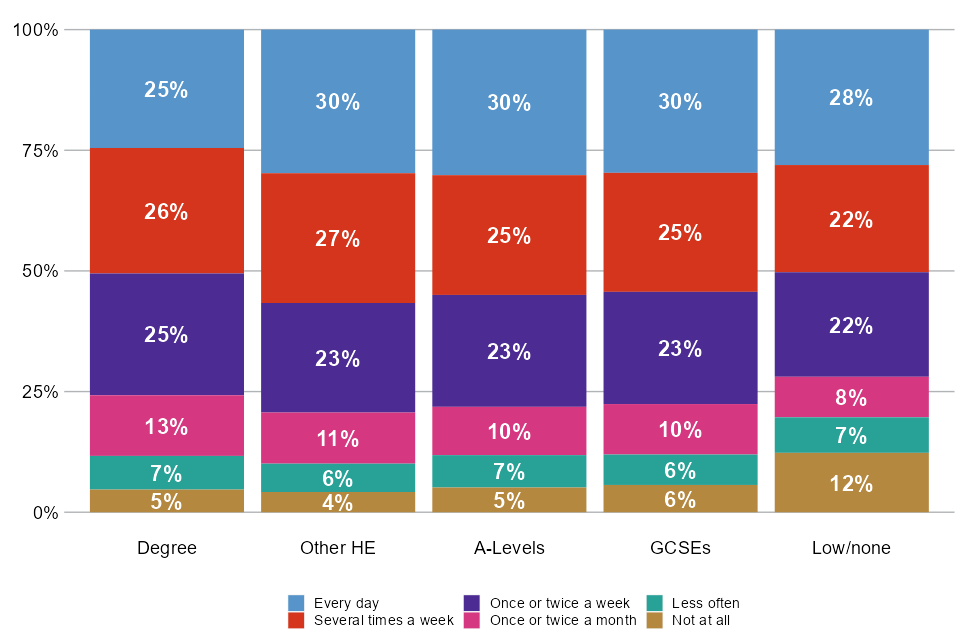
Source: Millennium Cohort Study, 2008.
Notes: Parents’ responses when children aged 8; geographical coverage is the United Kingdom. HE refers to ‘higher education’.
Figure 2.5a: Telling stories to child by occupational class
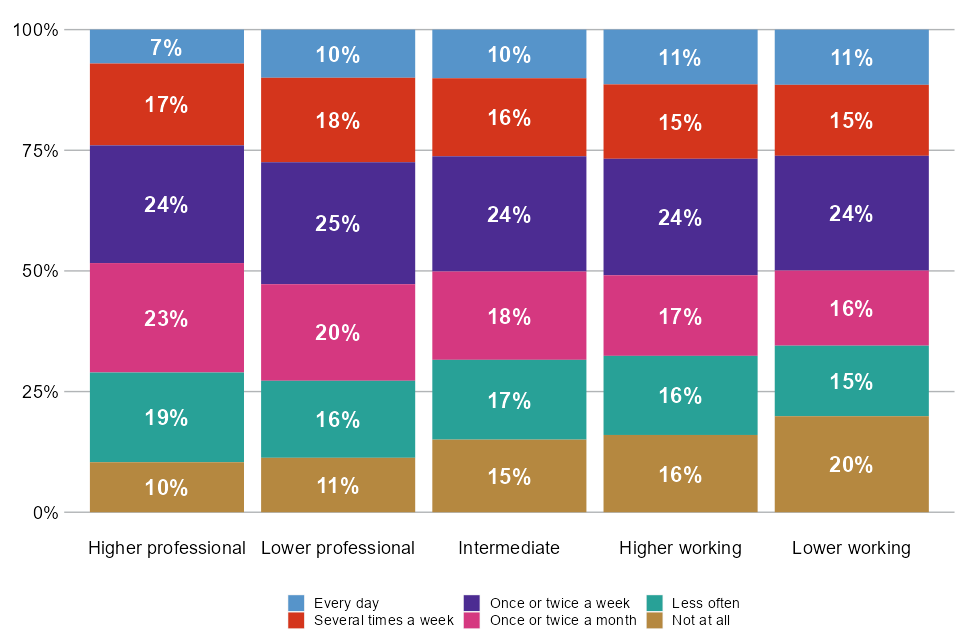
Source: Millennium Cohort Study, 2008.
Notes: Parents’ responses when children aged 8; geographical coverage is the United Kingdom.
Figure 2.5b: Telling stories to child by educational level
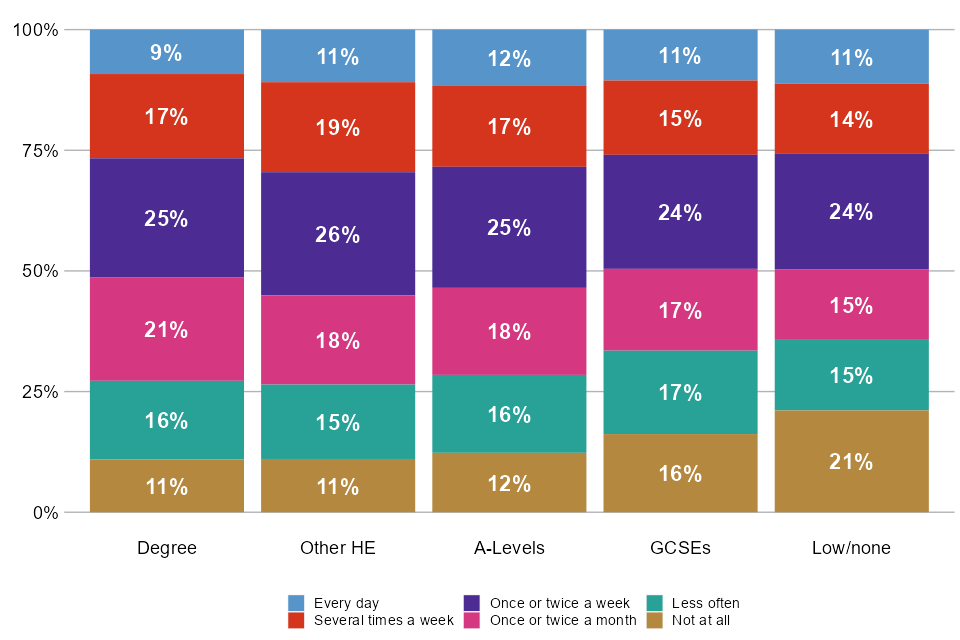
Source: Millennium Cohort Study, 2008.
Notes: Parents’ responses when children aged 8; geographical coverage is the United Kingdom. HE refers to ‘higher education’
These indicators, then, highlight complex patterns rather than a consistent story that holds for all activities. It may be that higher socio-economic groups, particularly degree-educated parents, read more often to their children, but that for other activities (e.g., helping with homework) the pattern reverses, and for children in lower-working-class or low-educated families, certain activities appear to be more unevenly distributed. There is a greater chance of a child from these families never doing music, story-telling or art activities, but this does not characterise everyone growing up in this position. Some parents are aware of the benefits that these activities afford and seek to provide them regardless of economic situation.
We have one additional measure relating to these patterns of parental investment in their children’s home learning environment, which relates to the amount of time that parents spend on these activities. Using a different kind of data – time diaries collected by the Centre for Time Use Research (CTUR) at University College London (UCL) – we are able to calculate how many minutes per day, on average, parents spend on teaching their child, helping with homework, and reading, playing and talking with their child. Time diaries are usually collected over a 24-hour period, equivalent to 1,440 minutes, usually in 10- to 15-minute slots or in an episode format, providing a highly accurate account of the activities that participants are engaging in. Parents fill in time diaries by providing a sequential account of what their daily routine consists of in terms of activities, corresponding to the way our memory stores events, and therefore resulting in higher validity.
The original 2016 report highlighted that time investment, or “Gruffalo time” as it was called, had seen widening inequalities over time. We are unable to continue using the same time use survey, as there was no follow-up data collection. However, we have been able to get recent estimates of developmental childcare time investments from 2023 (see Figures 2.6a and 2.6b). The data is separated into weekdays and weekends, as this is likely to influence how much time parents have available for reading and playing with their children. Note that we have different categorisations of both parents’ occupational class and education here due to data availability. We find that professional mothers spend 79 minutes per day on weekdays and 71 on weekends, compared to 50 minutes on weekdays and 60 minutes on weekends among working-class mothers. The disparity by educational level is larger.
Figure 2.6a: Time spent in minutes on developmental childcare (mothers only) by occupational class
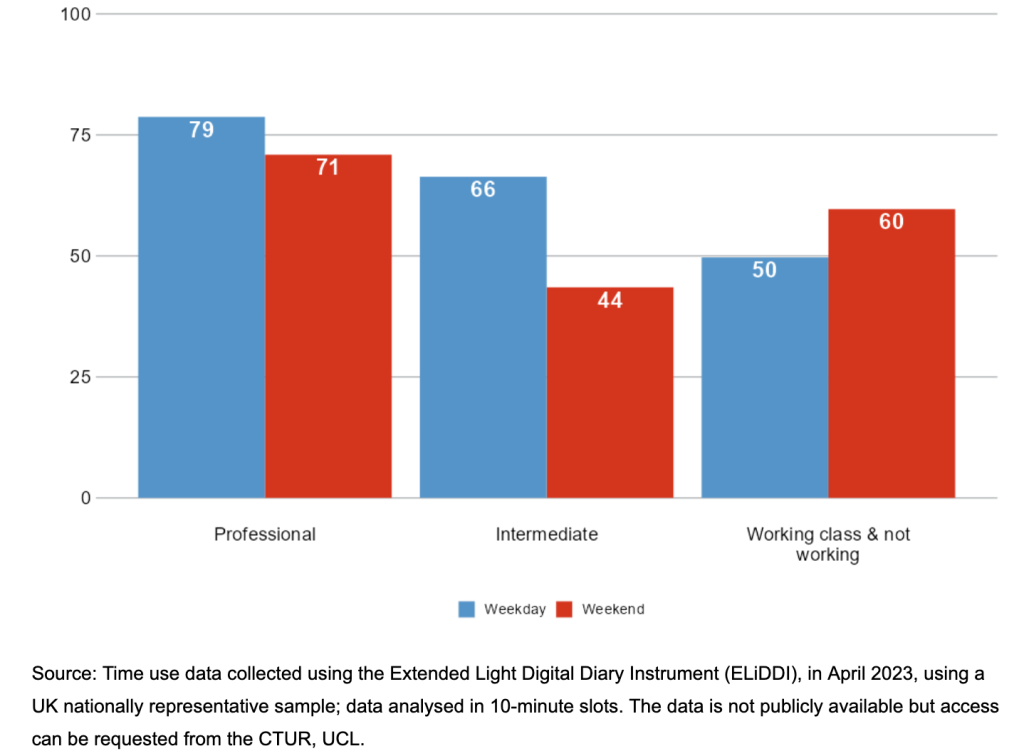
Notes: Mothers only, with children aged under 5; geographical coverage is the United Kingdom.
Figure 2.6b: Time spent in minutes on developmental childcare by educational level
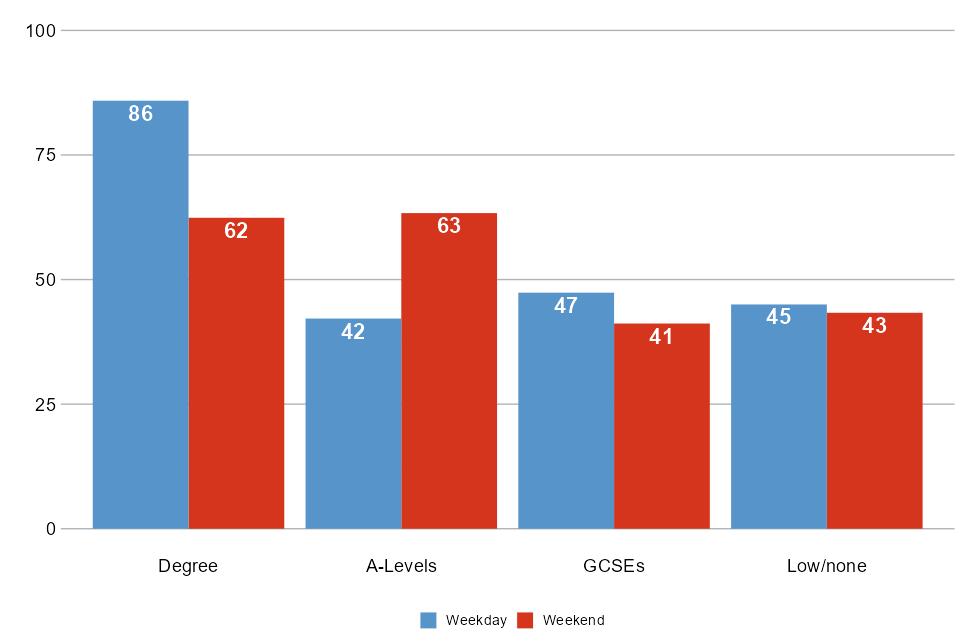
Source: Time use data collected using the Extended Light Digital Diary Instrument (ELiDDI), in April 2023, using a UK nationally representative sample; data analysed in 10-minute slots.The data is not publicly available but access can be requested from the CTUR, UCL.
Notes: Mothers only, with children aged under 5; geographical coverage is the United Kingdom.
We should acknowledge here that there are some data limitations. We wanted to look at time spent by fathers as well (included in Appendix Figure A2.2) but many of the estimates are unreliable due to small sample sizes. We would also have liked to explore differences according to whether the mothers are single mothers or partnered, but we do not have a large enough sample to do this. Nonetheless, our evidence here suggests that the inequality we showed in 2016 continues.
2. Extra tuition
In this section we show the chances of children doing extra (paid-for) tuition outside of school in English, maths and science. In Figures 2.7a and 2.7b, we show that when children are aged 15, extra tuition is relatively unusual (maximum 10% of children in any category), and also that there are few differences between groups. Because these numbers are small, we show 95% error bars, and these reveal a lot of overlap in the estimated percentages for each socio-economic group.
Between 7% and 10% of children from all backgrounds were receiving tuition in maths, between 4% and 6% in English, and between 1% and 3% in science (Figure 2.7a). For science and English, it appears that those from lower socio-economic backgrounds, particularly evidenced in relation to parental education, are slightly more likely to be receiving extra tuition (Figure 2.7b).
As a supplementary analysis, we use data from a second data source (Understanding society) when the children are aged between 11 and 15. This alternative source concurs that paid private tuition takes place for around 5% to 10% of children at any time, but this data suggests that it is more likely for children from higher socio-economic backgrounds to receive extra tuition than those from lower socio-economic backgrounds. Our safest conclusion, then, given this lack of consistency, is that differences by background are small.
Figure 2.7a: Children getting extra tuition by occupational class
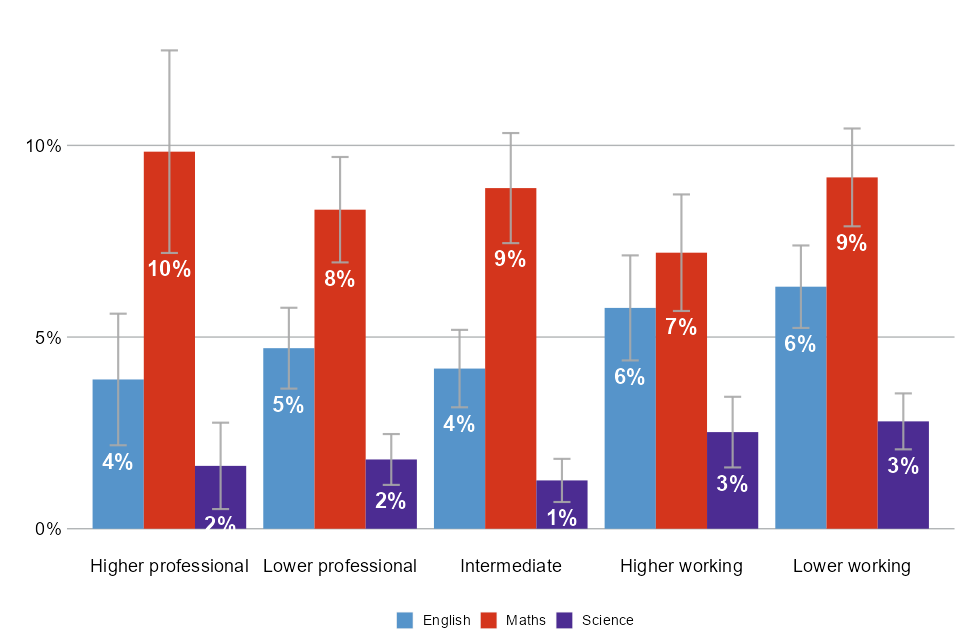
Source: Millennium Cohort Study, 2015.
Notes: Parents’ responses when children aged 15; geographical coverage is the United Kingdom.
Figure 2.7b: Children getting extra tuition by educational level
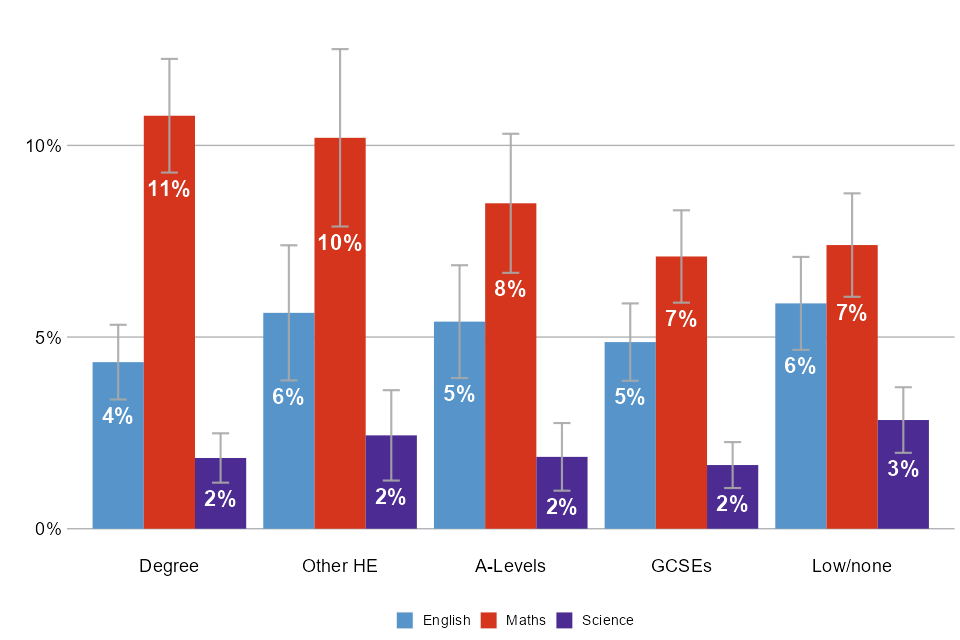
Source: Millennium Cohort Study, 2015.
Notes: Parents’ responses when children aged 15; geographical coverage is the United Kingdom. HE refers to ‘higher education’.
3. Parent–child relationship
In this section we shift our focus to different aspects of the parent–child relationship, including parenting style, and indicators of closeness as a family. The academic literature has highlighted many of these aspects of family life as being important for doing well in life. The first indicator is eating family meals together and could be thought of as an indicator of good relationships, as family meals offer a time for discussion, information sharing and social support. There are likely to be important issues here such as whether one of the parents is at home and has time to prepare a meal, rather than this being about what families prefer to do.
Figures 2.8a and 2.8b show that there is a socio-economic gradient, with 80% of higher-professional families eating together 3 times a week or more, compared to 68% of lower-working-class families, and a similar difference by parental education. There may be very good reasons for this pattern: for example, working-class jobs are more likely to include shiftwork that interferes with regular mealtimes. Of course, it can also be the case that parents in professional occupations are short of time and may need to work in the evenings. Nonetheless, despite the differences, the data shows that most families do eat together regularly across all backgrounds. In the Appendix (Figure A2.3) we show that the level of eating meals together has not changed over time, nor has the size of the gap between the higher and lower socio-economic groups.
Figure 2.8a: Families eating meals together by occupational class
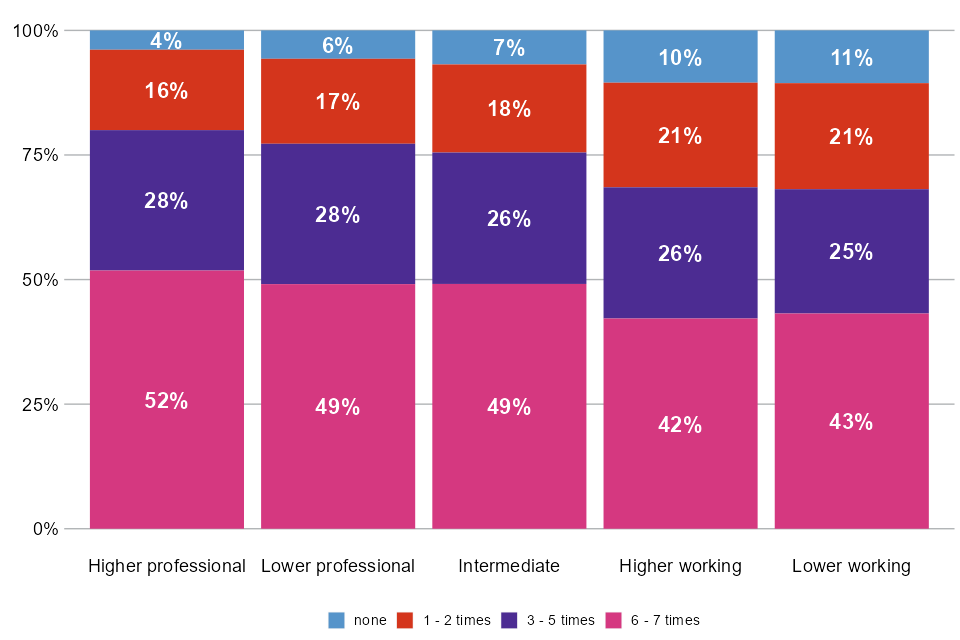
Source: Understanding society, pooled data 2009 to 2020.
Notes: Child responses, aged 11 to 15; geographical coverage is the United Kingdom.
Figure 2.8b: Families eating meals together by educational level
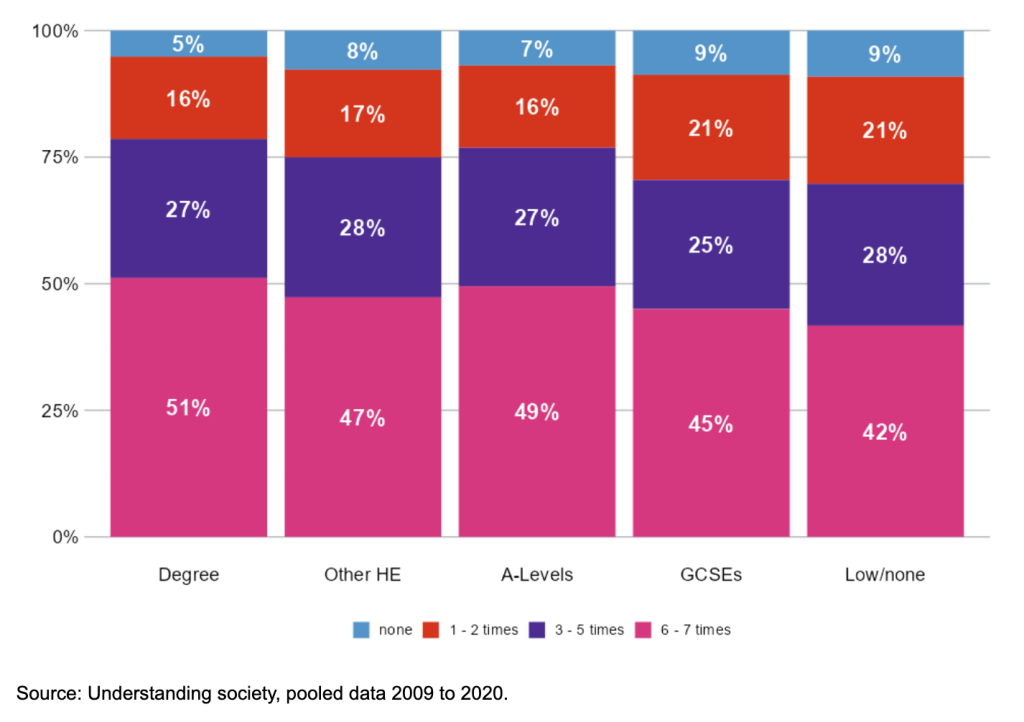
Notes: Child responses, aged 11 to 15; geographical coverage is the United Kingdom. HE refers to ‘higher education’.
Figures 2.9a and 2.9b show child-reported (aged 11 to 15) frequencies of talking to their parents “about things that matter”. Here we show mothers and fathers separately due to the differences between them (children report more often talking to their mother than their father). For mothers, we see a pattern – similar to some of the activities described above – of greater inequality. Children in lower working-class families are more likely to report hardly ever talking to their mother, but also talking to their mother every day (Figure 2.9a).
For fathers, a gradient is more evident where “hardly ever” talking about things that matter is far more common (44%) in lower-working-class families compared to higher-professional families (26%). The level of talking to fathers most days looks similar across the board. The differences look similar by education (Figure 2.9b). Again, we show the over-time trends in the Appendix (Figures A2.4 and A2.5), but we find that there is little change, although the frequency of “hardly ever talking to dad” has been slowly reducing over time.
Figure 2.9a: Talking to parents about things that matter by occupational class – mothers and fathers
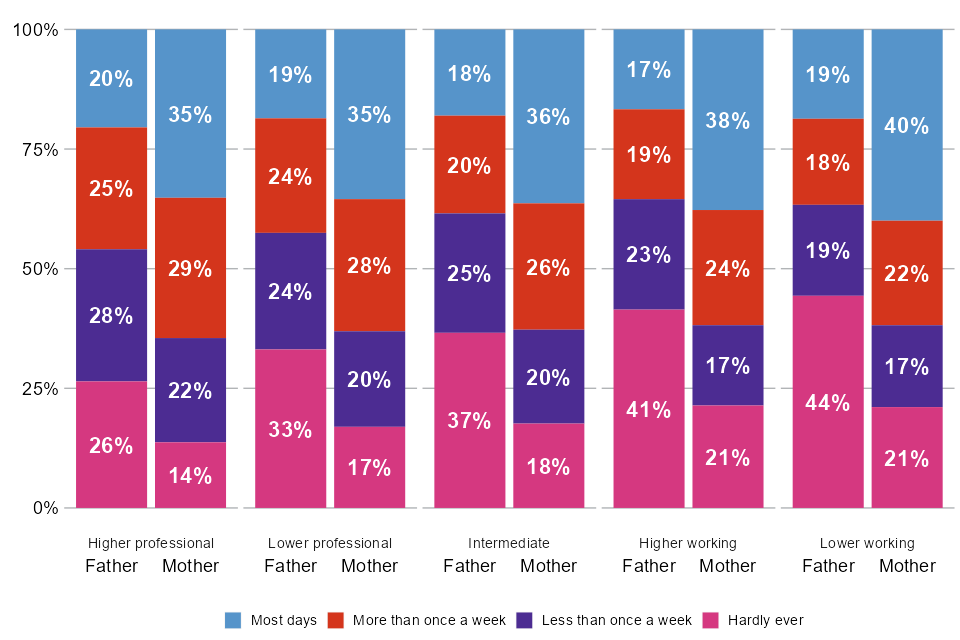
Source: Understanding society, pooled data 2009 to 2020.
Notes: Child responses, aged 11 to 15; geographical coverage is the United Kingdom.
Figure 2.9b: Talking to parents about things that matter by educational level – mothers and fathers
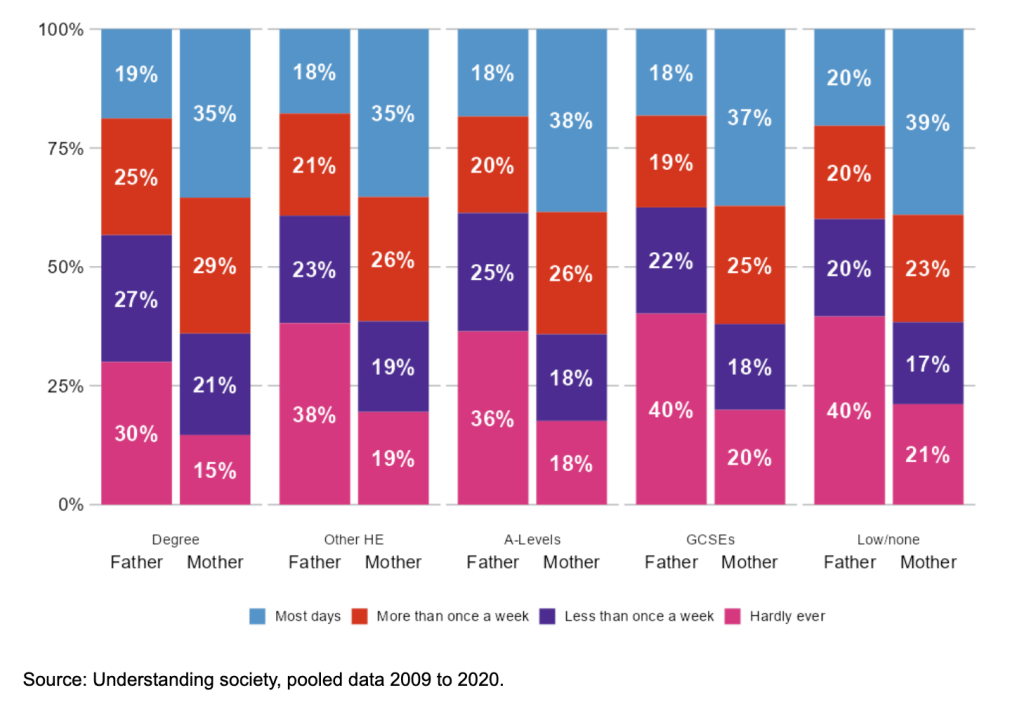
Notes: Child responses, aged 11 to 15; geographical coverage is the United Kingdom. HE refers to ‘higher education’.
A related point is the degree to which parents and children discuss school life and education. Figures 2.10a and 2.10b show whether parents report discussing school progress reports with their children. Among higher professionals, 94% report that they always discuss school reports, compared to 68% among the lower working class (Figure 2.10a). There is a similarly large difference when looking at parental education (Figure 2.10b). Thus, it would seem that a home life in which school progress and progress reports from teachers are more routinely discussed is more common in households with a higher socio-economic status than in those with a lower status.
Figure 2.10a: Frequency of talking to children about school reports by occupational class
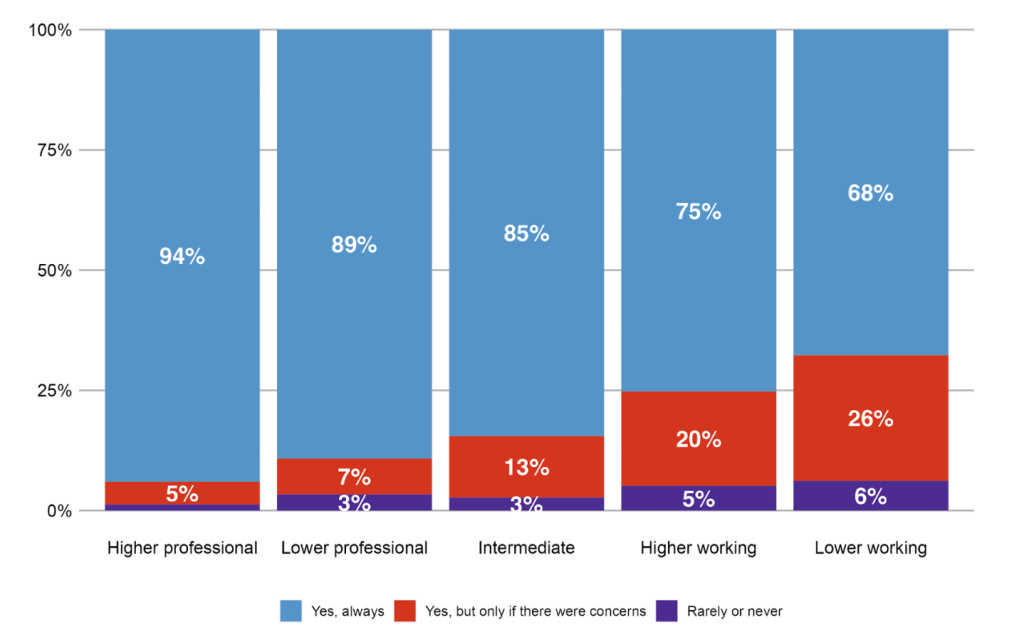
Source: The Sutton Trust (2021), COSMO: the COVID social mobility and opportunities study.
Notes: Parents’ responses when children were aged 15 to 16; geographical coverage is England only. Where the label is not shown, the value is 2% or less.
Figure 2.10b: Frequency of talking to children about school reports by educational level
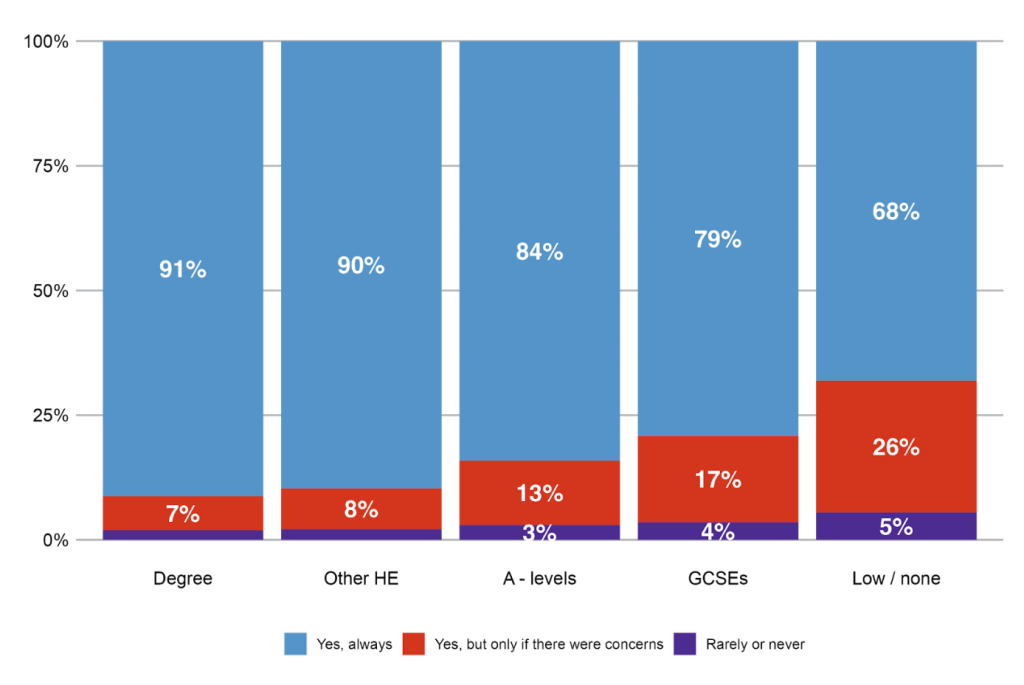
Source: The Sutton Trust (2021), COSMO: the COVID social mobility and opportunities study.
Notes: Parents’ responses when children were in year 11 (aged 15 to 16); geographical coverage is England only. HE refers to ‘higher education’. Where the label is not shown, the value is 2% or less.
We also have data on the frequency of quarrels between parents and children, reported both by the children and by the parents (Figures 2.11a and 2.11b; and 2.12a and 2.12b). Children appear to have a tendency to report fewer quarrels: for example, 7% of higher professionals’ children report quarrelling with their mother and 5% with their father on most days (Figure 2.11a) versus 17% of the fathers and 23% of mothers reporting quarrelling with their children most days (Figure 2.12a). Nonetheless, the patterns are similar overall: daily quarrels are more frequent in families from lower socio-economic backgrounds. We do not know the reasons for this. It could potentially be due to economic stress, but it could also reflect emotional problems (which we discuss in Chapter 3), or the lower general level of communication as evidenced above in “talking about things that matter”. The patterns look similar when we consider parental education level. We show in the Appendix that patterns of quarrels have not changed over time (Figures A2.6 and A2.7).
Figure 2.11a: Child-reported quarrels by occupational class
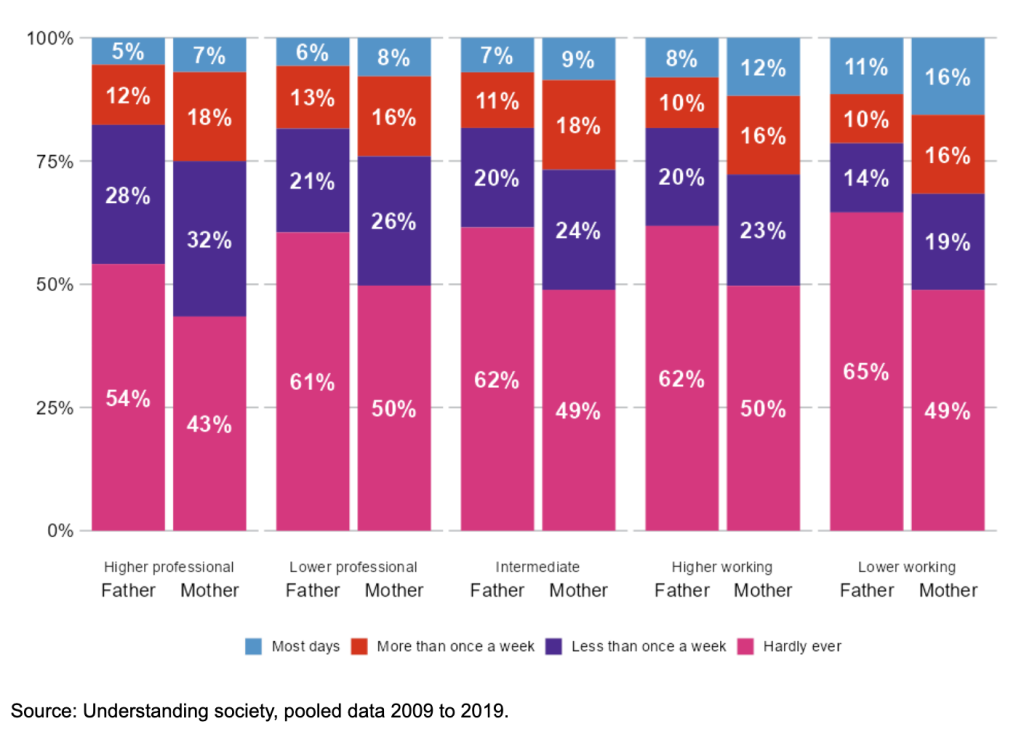
Notes: Child responses, aged 11 to 15; geographical coverage is the United Kingdom.
Figure 2.11b: Child-reported quarrels by educational level
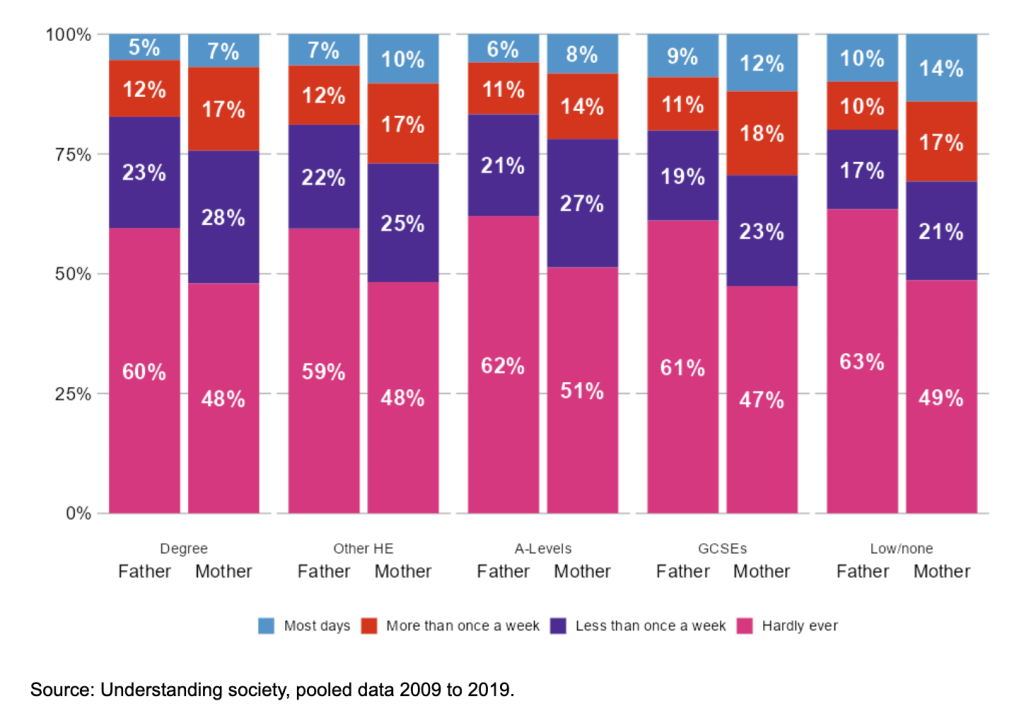
Notes: Child responses, aged 11 to 15; geographical coverage is the United Kingdom. HE refers to ‘higher education’.
Figure 2.12a: Parent-reported quarrels by occupational class
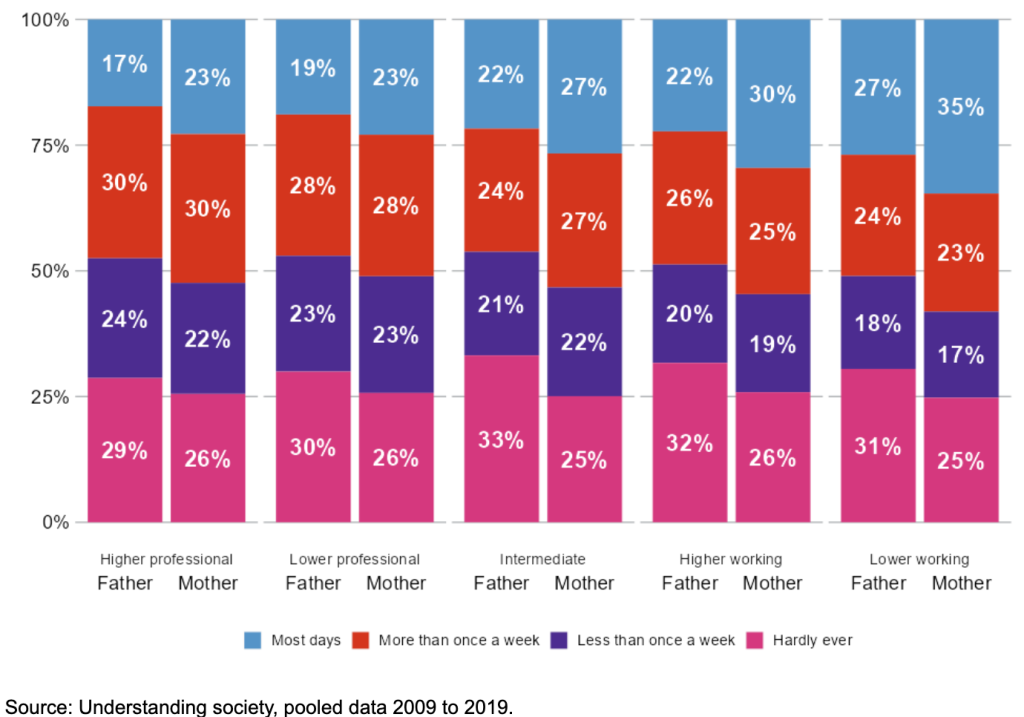
Notes: Parent responses; geographical coverage is the United Kingdom.
Figure 2.12b: Parent-reported quarrels by educational level
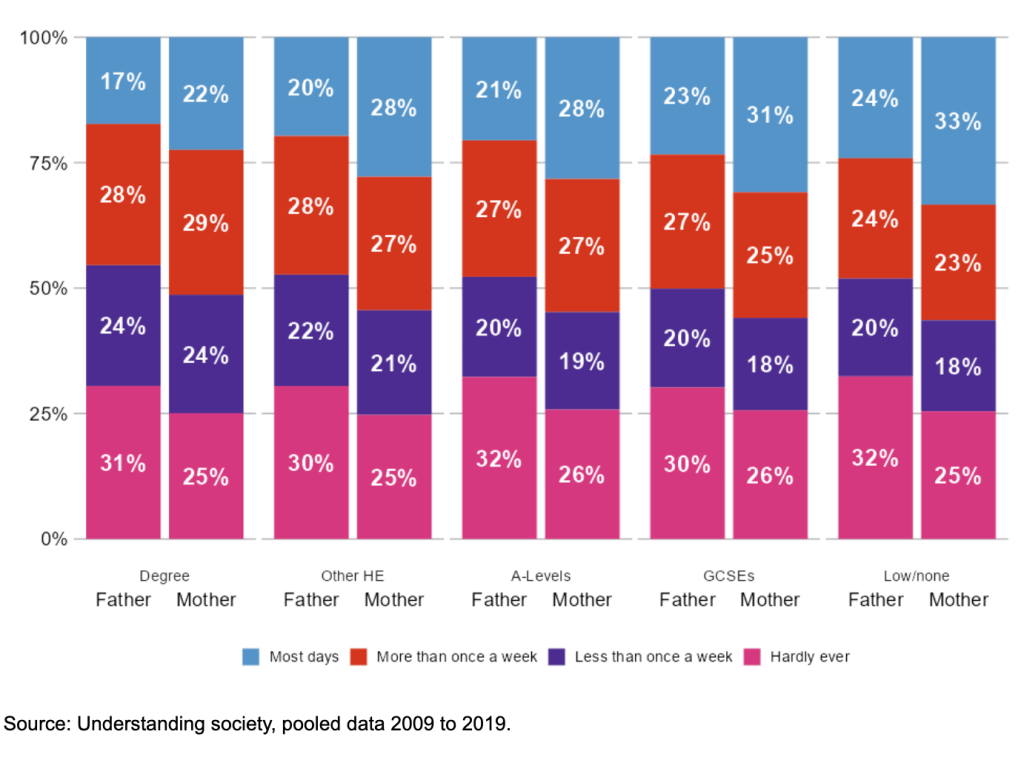
Notes: Parent responses; geographical coverage is the United Kingdom. HE refers to ‘higher education’.
Quarrels between children and parents may also relate to parenting styles – for example, if parents worry about the potential negative consequences of giving their children independence. Finally in this section, then, we look at parenting styles. We have an indicator of parental monitoring, again relying on questions answered by the children themselves on how often they are out past 9pm without their parents knowing where they are (Figures 2.13a and 2.13b). Here a clear gradient is present, with 81% of children in lower-working-class families saying “never” compared to 91% of children in higher professional families (Figure 2.13a). We find a similar pattern by educational level (Figure 2.13b).
Figure 2.13a: Parental monitoring – times out after 9pm by occupational class
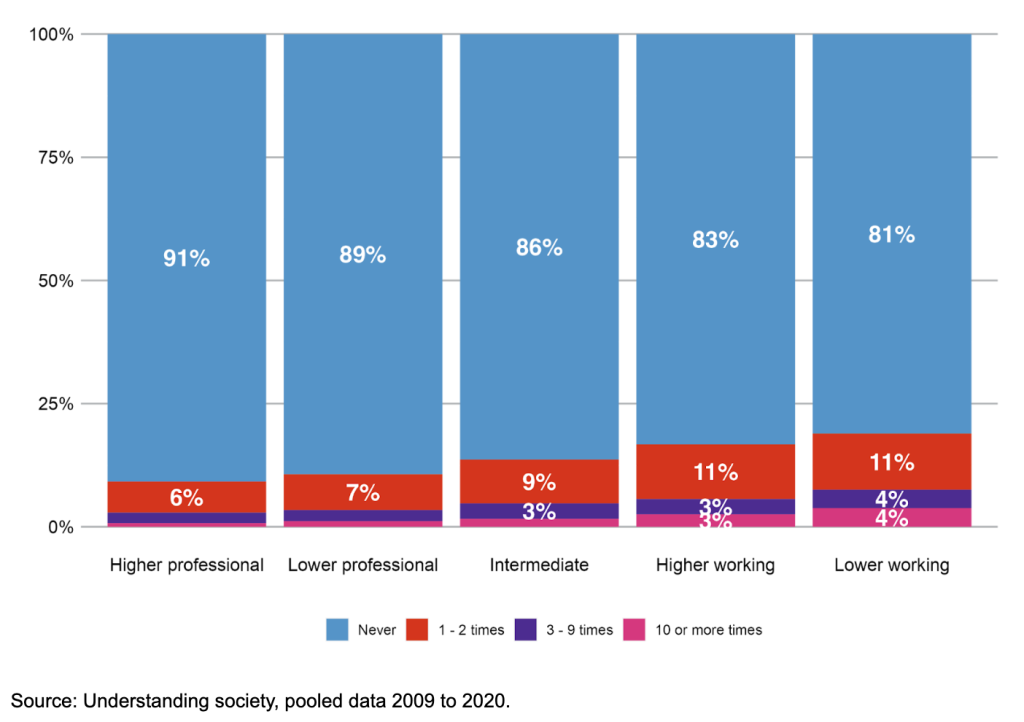
Notes: Child responses, aged 11 to 15; geographical coverage is the United Kingdom. ‘Times out’ refers to how often the child was out past 9pm without their parents knowing where they were. Where the label is not shown, the value is 2% or less.
Figure 2.13b: Parental monitoring – times out after 9pm by educational level
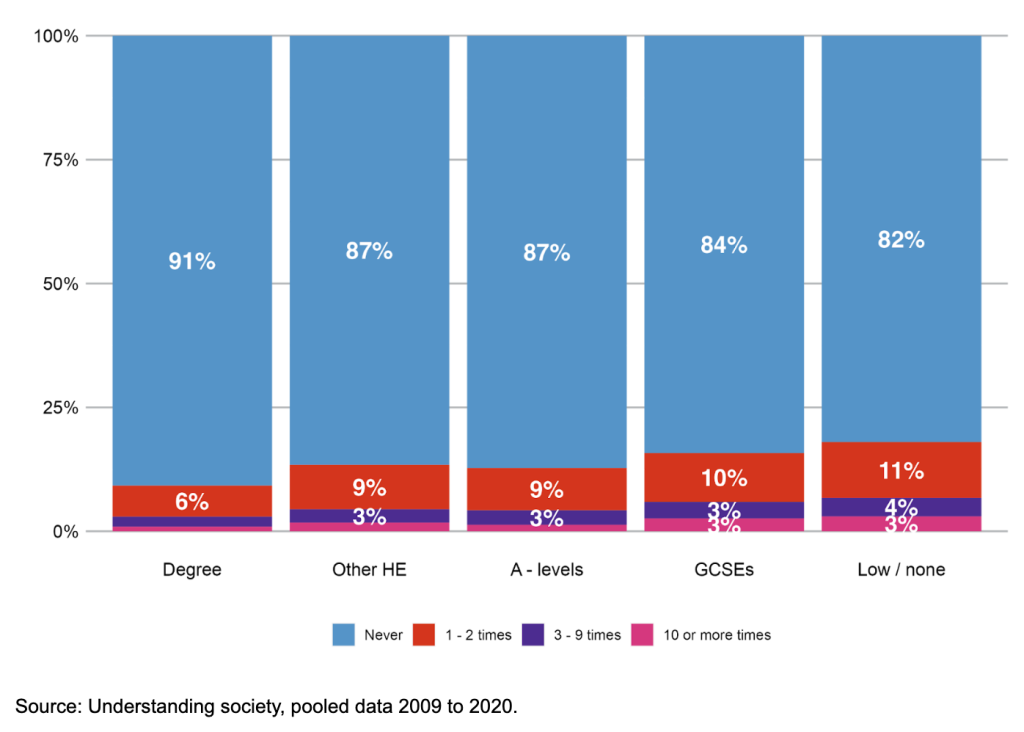
Notes: Child responses, aged 11 to 15; geographical coverage is the United Kingdom. ‘Times out’ refers to how often the child was out past 9pm without their parents knowing where they were. HE refers to ‘higher education’. Where the label is not shown, the value is 2% or less.
Our earlier findings on social capital suggest that the children who are out past 9pm are more likely to be in areas of low trust. The implications of this finding are quite broad. One is that children are missing out on time at home, where they might be doing their homework; another could be that being out late is associated with the risk of children engaging in risky behaviours such as drinking alcohol (which we discuss in Part 3).
This is one indicator where we see a clear overall trend (the chart is in the Appendix, Figure A2.8), whereby being out late without parents knowing their children’s whereabouts has become less common for both high and low socio-economic groups.
We also have an overarching indicator of parenting style that brings together some of the measures we have already discussed in this section, shown in Figures 2.14a and 2.14b. It is coded into 3 styles – authoritarian, authoritative and permissive – and a score is assigned to each for how high parents score on that style. Authoritarian-style parenting covers not permitting children to go out late, setting rules on TV, but also tending to talk to children less and quarrel more. Authoritative parenting covers knowing where children are going, setting rules on TV time (see Appendix, Figures A2.9a, A2.9b and A2.10) and eating meals together. Permissive parenting means allowing children out late and being less likely to set rules on TV watching, but also higher levels of quarrels with children. These styles have also been linked to educational outcomes and children’s wellbeing in the academic literature. However, we find almost no differences in these types of parenting by socio-economic group. Children of different backgrounds have parents scoring high on the authoritative dimension (around 60), lower on the authoritarian dimension (around 20) and low on the permissive dimension (around 10). Also, there are no clear patterns of change in parenting styles over time (Appendix, Figure A2.11).
Figure 2.14a: Parenting styles by occupational class
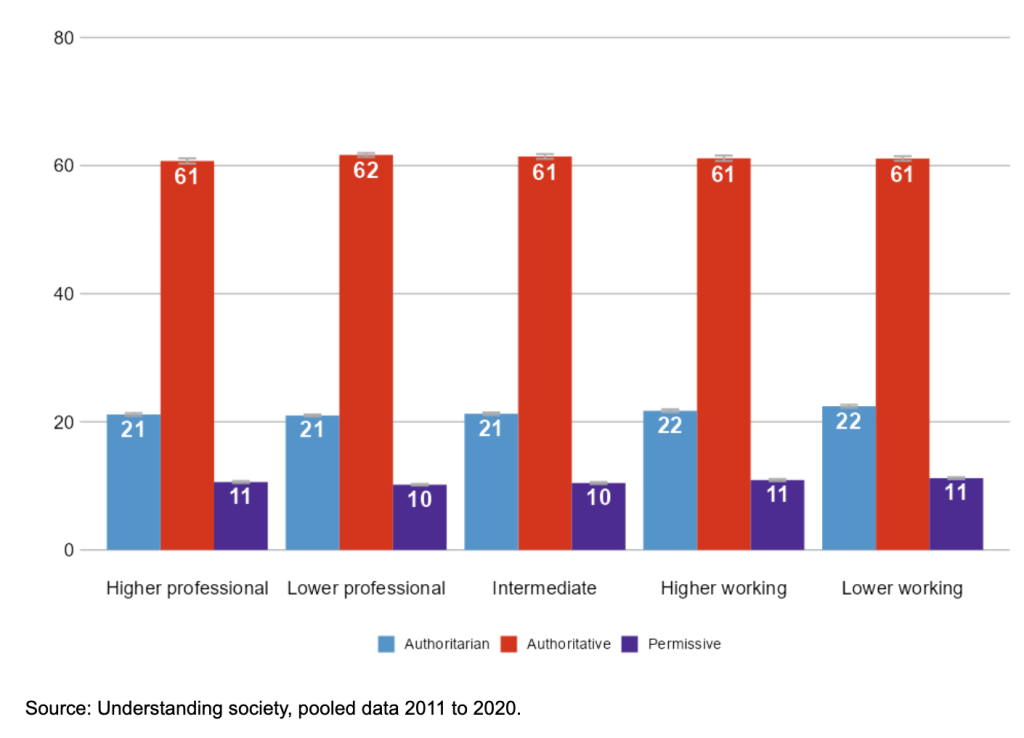
Notes: Adult and child (aged 11 to 15) responses; geographical coverage is the United Kingdom.
Figure 2.14b: Parenting styles by educational level
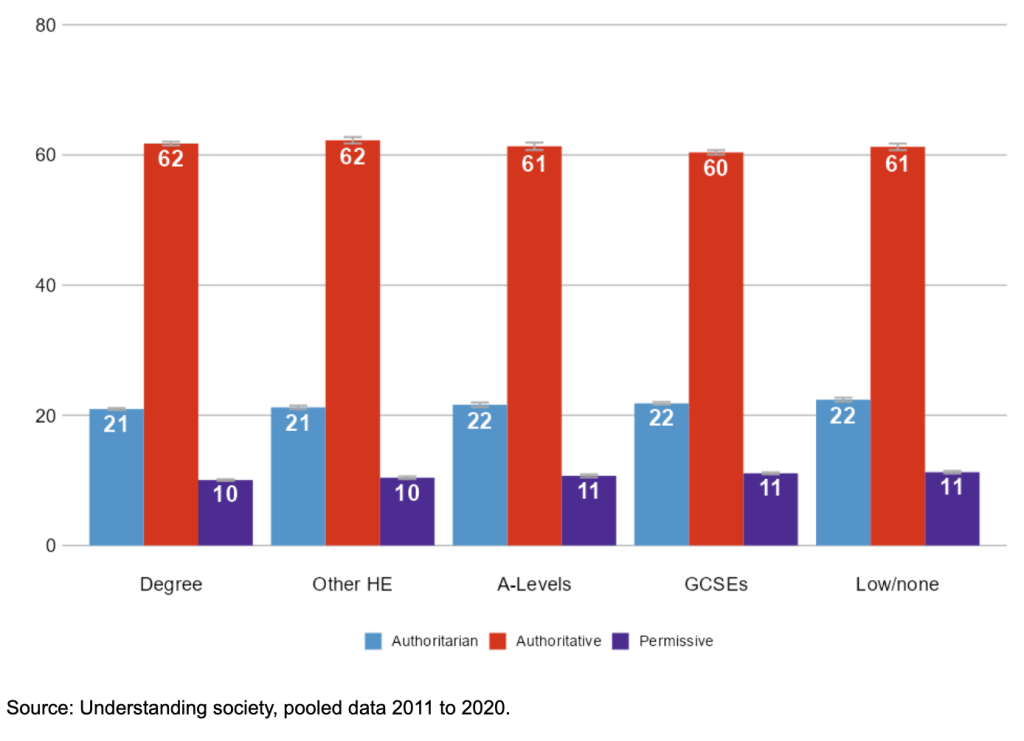
Notes: Adult and child (aged 11 to 15) responses; geographical coverage is the United Kingdom. HE refers to ‘higher education’.
Part 3. Children’s lives
Main findings
- In contrast to the 2016 report, we find no differences across socio-economic background in truancy and exclusion from school. We find a reverse gradient in drinking alcohol, vaping and illegal drugs, which is to say higher levels of these activities among school children from more-affluent families.
- Our findings are indicative of a potential crisis in adolescent mental health in the UK. On some items, such as feeling nervous and losing confidence in new situations, 35% of girls aged 11 to 15 agree – a strikingly high number.
- We find that gender differences in mental wellbeing are often larger than differences across socio-economic background, although on most measures there is also evidence that those from lower socio-economic backgrounds are worse off than those from higher socio-economic backgrounds.
- We find that the inequalities among 11-year-olds that we reported in 2016 in conduct disorders, emotional symptoms, and hyperactivity and inattention remain among children aged 17. For example, lower-working-class parents are 3 times more likely to report issues relating to hyperactivity and inattention than higher professional parents. However, the differences are almost non-existent when relying on children’s own self-reports.
- Experiences of the pandemic: we find that children from lower socio-economic groups are more likely to report that they had issues during lockdown with having a suitable place to work at home and a suitable device to work on. For example, 18% of lower-working-class children report that they relied on their mobile phone to do school work, and a further 9% had no suitable device. The figures were 5% and 1% among children in higher professional families.
- There are differences in children’s reports of whether they plan to go to university: 78% of children of higher professional parents reported planning to go to university compared with 58% of lower-working-class children. Children from lower-working-class backgrounds are more likely to report that this is because they would rather get a job, or because their family cannot afford it.
1. Norm-violating behaviours
We begin our examination of children’s lives with a look at what we call norm-violating behaviours – namely, those behaviours which may be thought of as troublesome and associated with poor educational outcomes. Studies have shown associations between truancy from school, smoking cigarettes, drinking alcohol or trying illegal drugs, and doing less well at school. Vaping is a more recent phenomenon, but studies have also found an association between vaping (smoking ‘electronic cigarettes’) and poor academic performance. While there are good reasons to believe that such behaviours will have a causal influence on how well children do at school – because, for instance, nicotine, alcohol and other drugs can influence brain development – we also need to be cautious with causality here. It is possible that poor performance at school makes school a stressful experience that makes students more likely to truant, for example, or that other stressors (such as hyperactivity or other conduct disorders, which we discuss in the next section) lead both to poor academic performance and norm-violating behaviours. Nonetheless, studies of longer-term negative outcomes suggest that these aspects of children’s lives could be consequential.
In this section, we take our evidence from ‘Smoking, drinking and drug use among young people in England’, a survey of secondary school pupils in England in years 7 to 11 (and therefore aged around 11 to 16). The school sampling methodology has many advantages; however, we do not have equivalent measures of parents’ socio-economic status available and rely here instead on a measure called the Family Affluence Score (FAS), which is grouped into high, medium and low. Here we report the most recent data, from 2021, but our findings look similar in 2018 so we are confident that the results we report here are not just a ‘blip’ in the data due to the pandemic (we show these in the Appendix, Figures A3.1 and A3.2).
We look first at truancy and exclusion from school, shown in Figure 3.1. Here we find almost no differences in truancy from school by FAS: the rate is 19% among the low affluent, but 18% among the high affluent. For being excluded from school, the rate is a little higher among the low affluent (9%) than the high affluent (7%). Looking at the over-time data, which we show in the Appendix (Figures A3.3 and A3.4), it seems that overall levels of truancy and exclusion are somewhat lower now than in the past. The data suggests that in the past, both truancy and exclusions were higher among the lower socio-economic group, but the most recent measures show that the socio-economic differences have narrowed. We do need to be cautious in interpreting the time trend, since the pre-2016 results relied on free school meals as the main indicator of family background rather than the new measure of family affluence. Nonetheless, according to our updated analysis, truancy and exclusions are a slightly more common problem among lower socio-economic groups.
Figure 3.1: Truancy and exclusion from school by Family Affluence Score, 2021
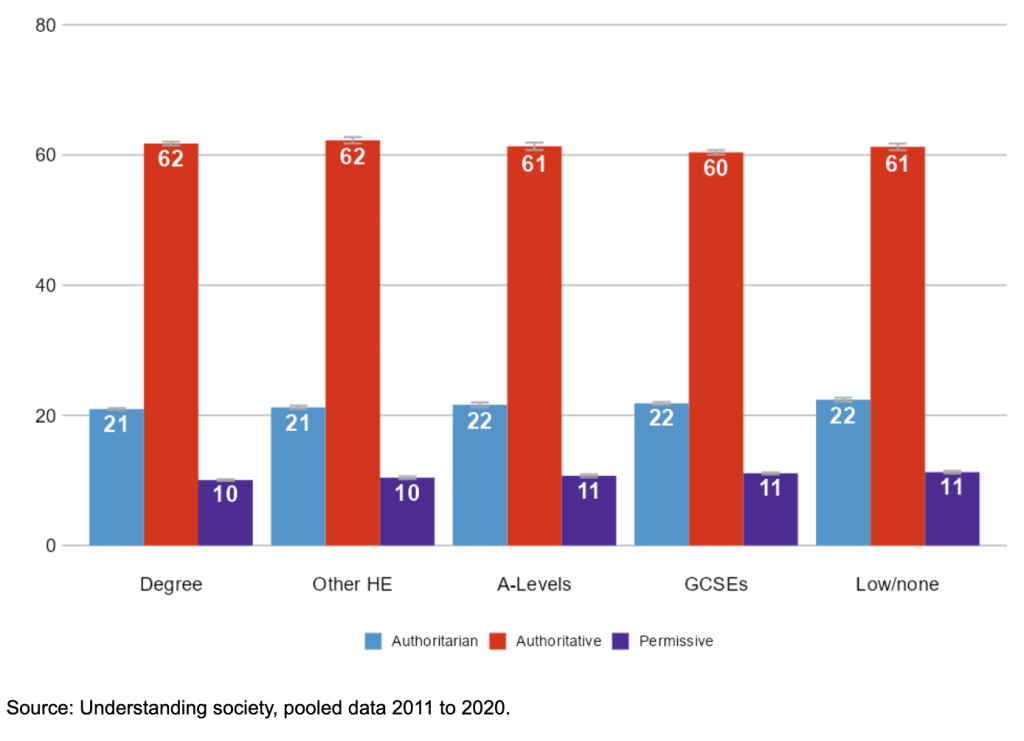
Notes: Children aged 11 to 15; geographical coverage is England.
In Figure 3.2, we show children’s self-reports of whether they drink alcohol, smoke cigarettes, vape or have tried illegal drugs. Here, the data shows a clear inverse social gradient, which is to say a gradient that runs in the opposite direction to the one many people might expect. Rates of drinking alcohol are more prevalent in more-advantaged groups. Of the young people from the high affluent group, 32% had consumed alcohol in the last month, compared to 19% of those in the low affluent group. Alcohol consumption is also known to be more frequent among adults in higher occupational classes, likely due to the costs. It is likely, therefore, that children in families from higher socio-economic backgrounds have easier access to alcohol.
A similar pattern can be seen with drug use, with higher proportions of pupils from more affluent families (23%) trying drugs compared to low affluent groups (17%). Since we find the same in 2018 (see Appendix, Figure A3.2), these results are not an anomaly of the pandemic years. Here, the trend presented in the original report seems to have inverted. Again, while we must be cautious about interpreting the data due to a change in the measures, it appears that drug use may now be more common among children from families in high socio-economic groups than those in low socio-economic groups from around 2016 (Appendix, Figure A3.8).
There appear to be no differences in smoking by family affluence. Across all groups, approximately 3% to 5% of pupils are regular or occasional smokers. Smoking has been in decline over the last 2 decades (Appendix, Figure A3.6); this is the case among adults as well, and it is therefore likely that children have less access to cigarettes at home.
However, smoking has been superseded in recent years by e-cigarettes or ‘vaping’. In Figure 3.2, we can see that vaping follows the same pattern as alcohol and drugs and is more common among the high affluence group (13%) compared to the low affluence group (10%). Vaping was included in the survey from 2016, and the over-time data (Appendix, Figure A3.7) shows that it has been on the increase in both high and low socio-economic groups.
Figure 3.2: Alcohol, cigarettes, vaping and drug use by Family Affluence Score, 2021
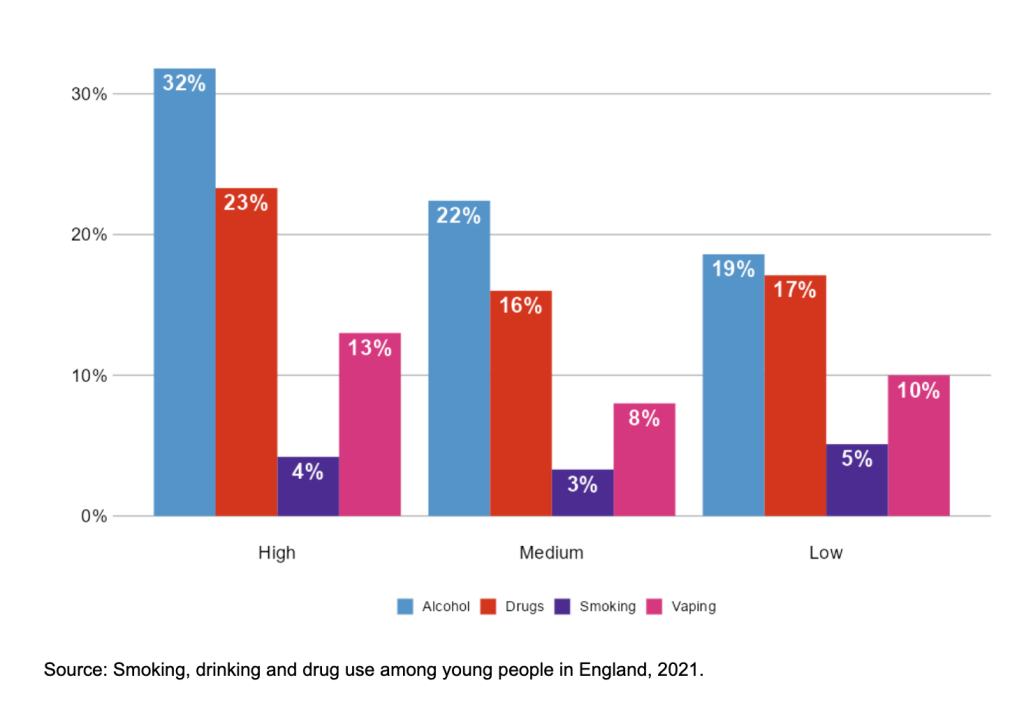
Notes: Children aged 11 to 15; geographical coverage is England.
2. Wellbeing
In this section, we focus on wellbeing, which has been a topic of media attention both during the pandemic and since. Here, as well as socio-economic differences, we also show differences between boys and girls, because they tend to show large differences in some indicators of mental health, although not all. Also, in response to the recent media attention about a crisis in adolescent wellbeing, we also show changes over time here; we have a good consistent time series which goes back to 2010 for some items, and for others we have data going back to 1995 (from the British Household Panel Study, the predecessor to Understanding Society). We add smoothed trend lines to aid interpretation of the trend shown by the data points, which are often ‘noisy’ and hard to interpret on their own.
Figure 3.3 shows the long-run trend in young people disagreeing with the statement “I am a likeable person” – a direct indicator of self-esteem and social anxiety. On this item, boys and girls exhibit similar levels; for both, the percentage disagreeing with the statement has been on the rise since 2010, from around 4%, to 9% in 2020.
Figure 3.3: “I am a likeable person” (% disagree or strongly disagree)
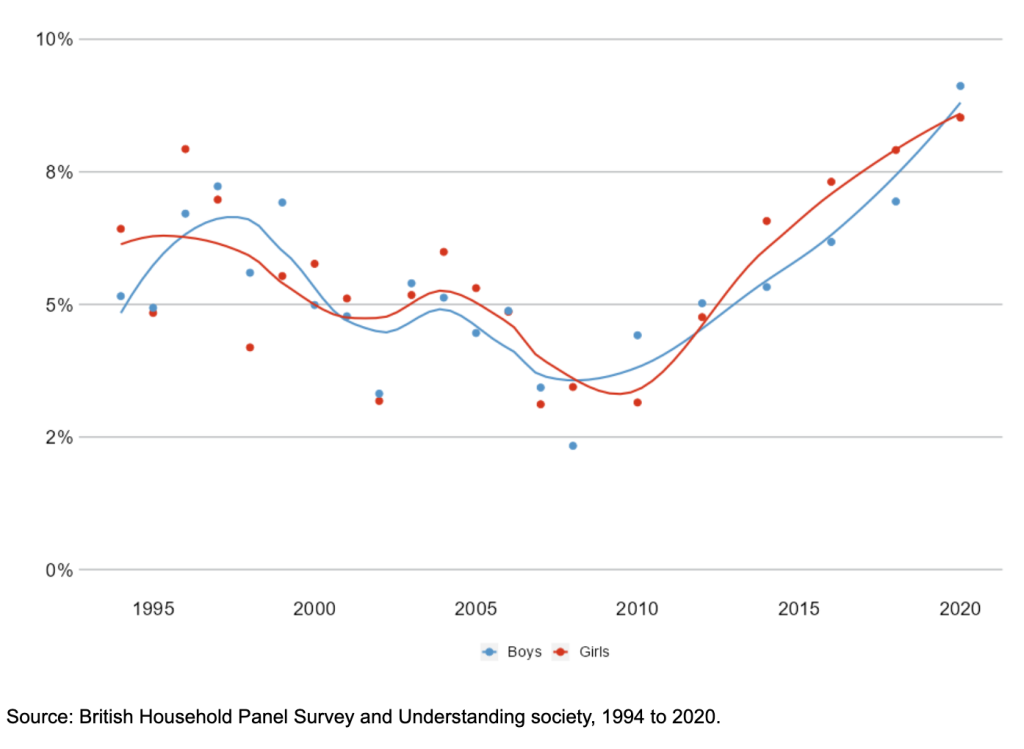
Notes: Child responses, aged 11 to 15; geographical coverage is the United Kingdom. The lines around the points are smoothed trend lines to aid interpretation.
A different question on feeling sad about life as a whole (see Figure 3.4) also shows a rise over the last decade, although feeling sad about life was also fairly high in the 1990s, especially among girls.
Figure 3.4: Feeling sad about life as a whole (% negative, sad face icon)
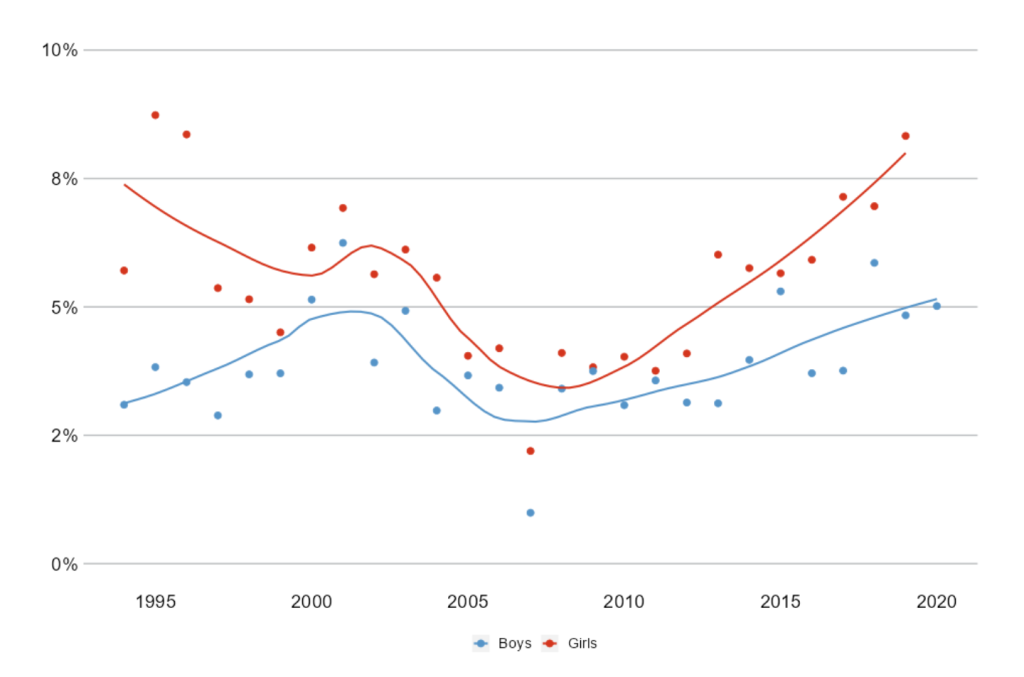
Source: British Household Panel Survey and Understanding society, 1994 to 2020.
Notes: Child responses, aged 11 to 15; geographical coverage is the United Kingdom. The lines around the points are smoothed trend lines to aid interpretation. Respondents were asked to select from a range of emojis on a 7-point scale running from happy to sad.
Figure 3.5 shows a different question, about feeling nervous and easily losing confidence. The percentages here are much higher: in 2019, 35% of girls agreed with this statement and over 20% of boys. With this indicator too, poor mental health seems to be on the rise from around 2010.
Figure 3.5: “I feel nervous and easily lose confidence in new situations” (% certainly true)
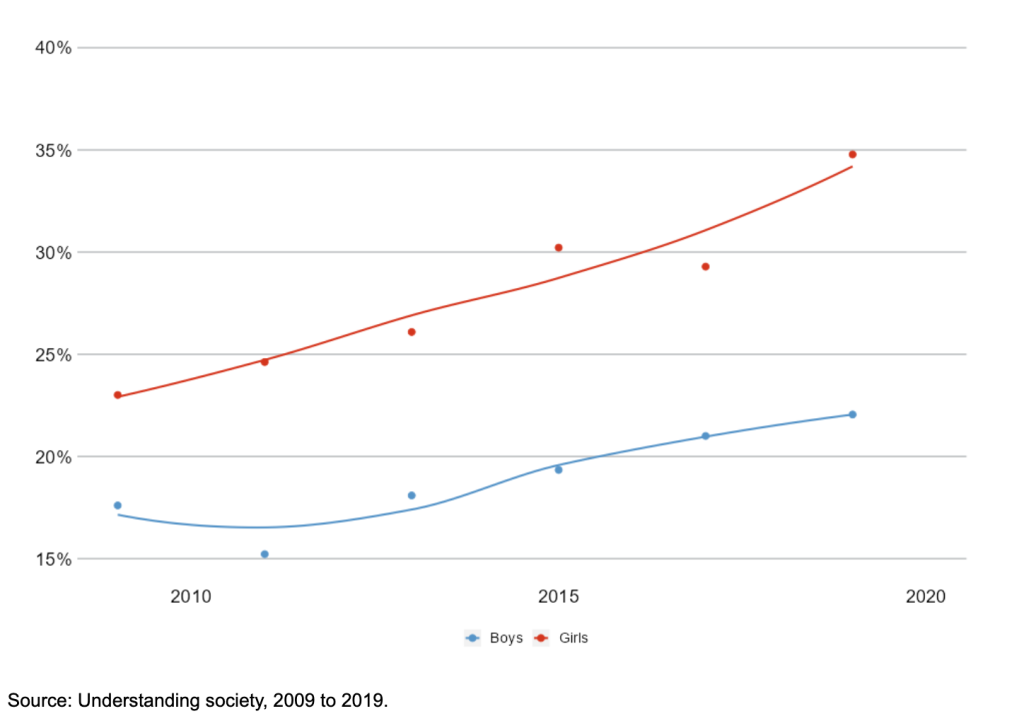
Notes: Child responses, aged 11 to 15; geographical coverage is the United Kingdom. The lines around the points are smoothed trend lines to aid interpretation.
Turning to the socio-economic inequalities shown in Figures 3.6 to 3.8, we find that there is no clear change in terms of inequality becoming worse over time; however, for much of the period the solid lines representing the lower working class are at a higher level than the dashed lines for the higher professional class, suggesting that average wellbeing is worse among lower socio-economic groups, for both boys and girls.
Figure 3.6a: “I am a likeable person” by class, girls (% disagree or strongly disagree)
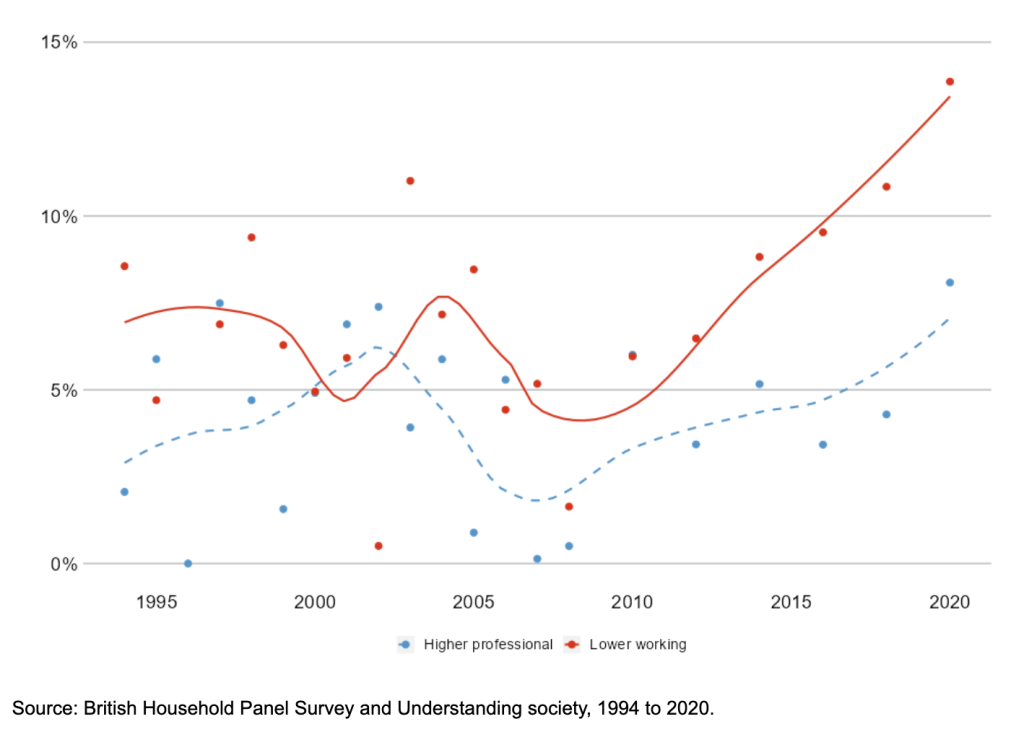
Notes: Child responses, aged 11 to 15; geographical coverage is the United Kingdom. The lines around the points are smoothed trend lines to aid interpretation.
Figure 3.6b: “I am a likeable person” by class, boys (% disagree or strongly disagree)
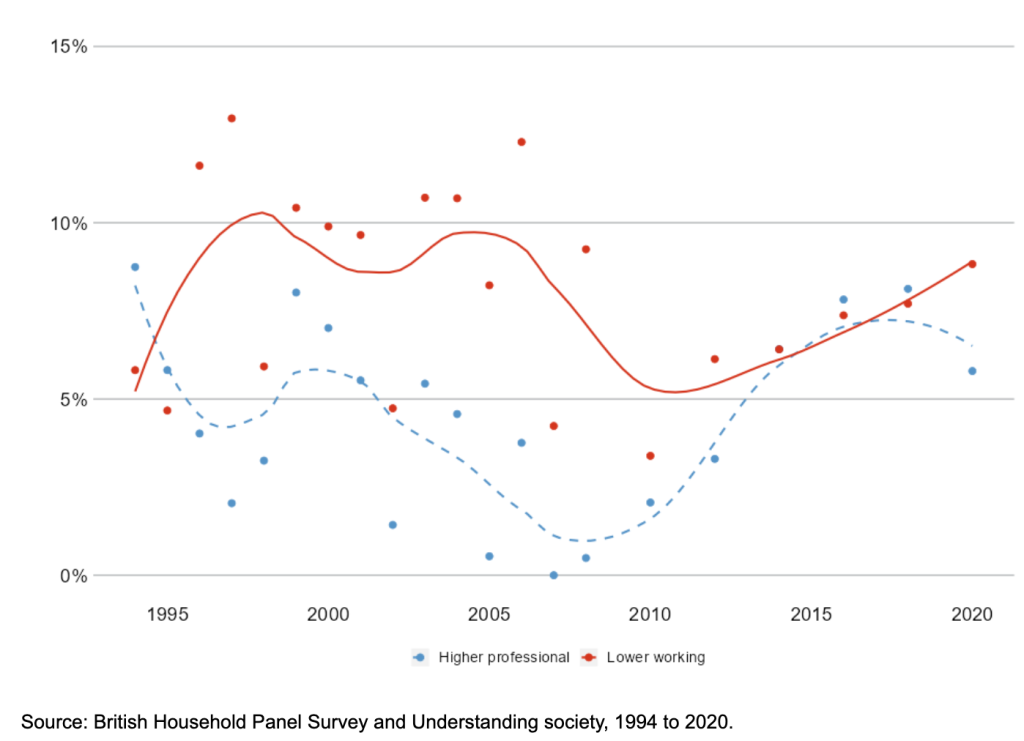
Notes: Child responses, aged 11 to 15; geographical coverage is the United Kingdom. The lines around the points are smoothed trend lines to aid interpretation.
Figure 3.7a: Feeling sad about life as a whole by class, girls (% negative, sad face icon)
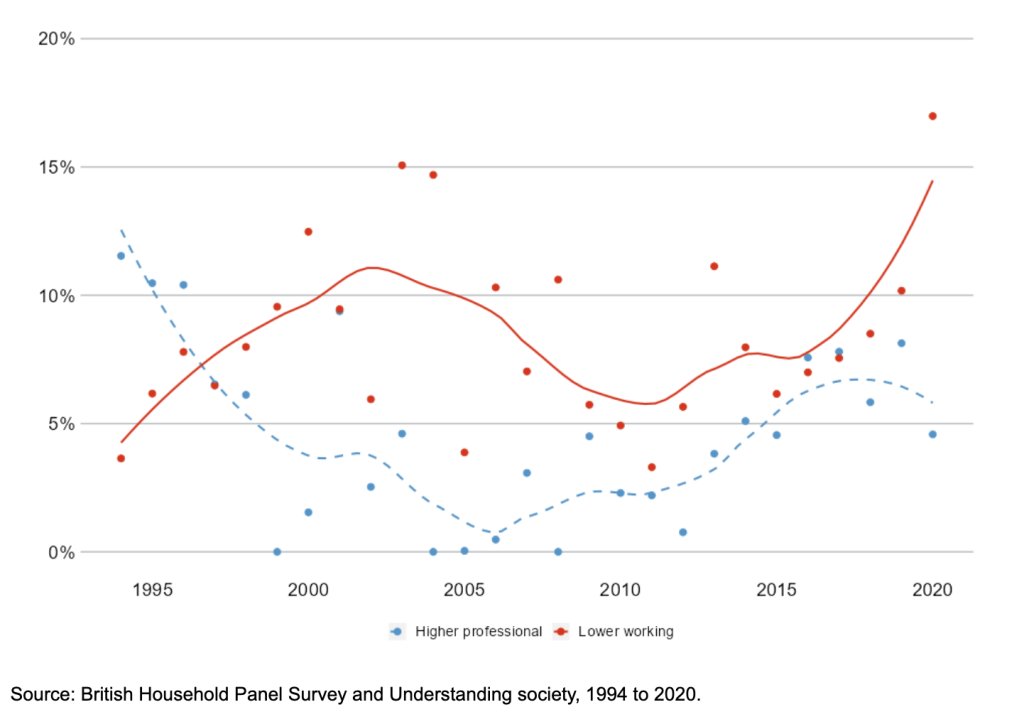
Notes: Child responses, aged 11 to 15; geographical coverage is the United Kingdom. The lines around the points are smoothed trend lines to aid interpretation. Respondents were asked to select from a range of emojis on a 7-point scale running from happy to sad.
Figure 3.7b: Feeling sad about life as a whole by class, boys (% negative, sad face icon)
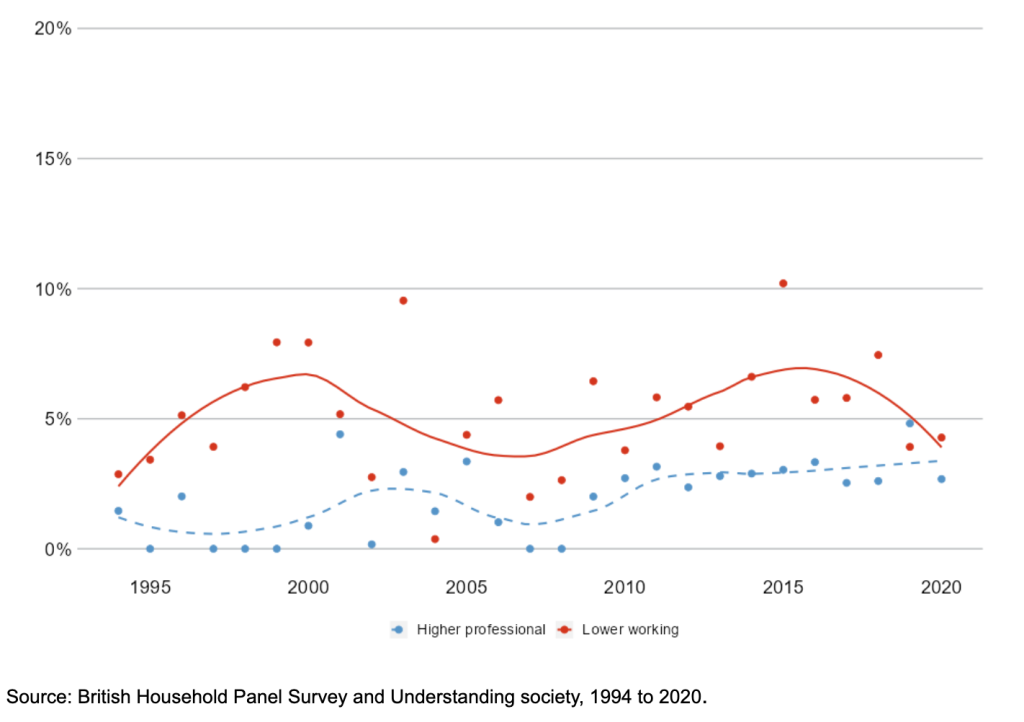
Notes: Child responses, aged 11 to 15; geographical coverage is the United Kingdom. The lines around the points are smoothed trend lines to aid interpretation. Respondents were asked to select from a range of emojis on a 7-point scale running from happy to sad.
Figure 3.8a: “I feel nervous and easily lose confidence in new situations” by class, girls (% certainly true)
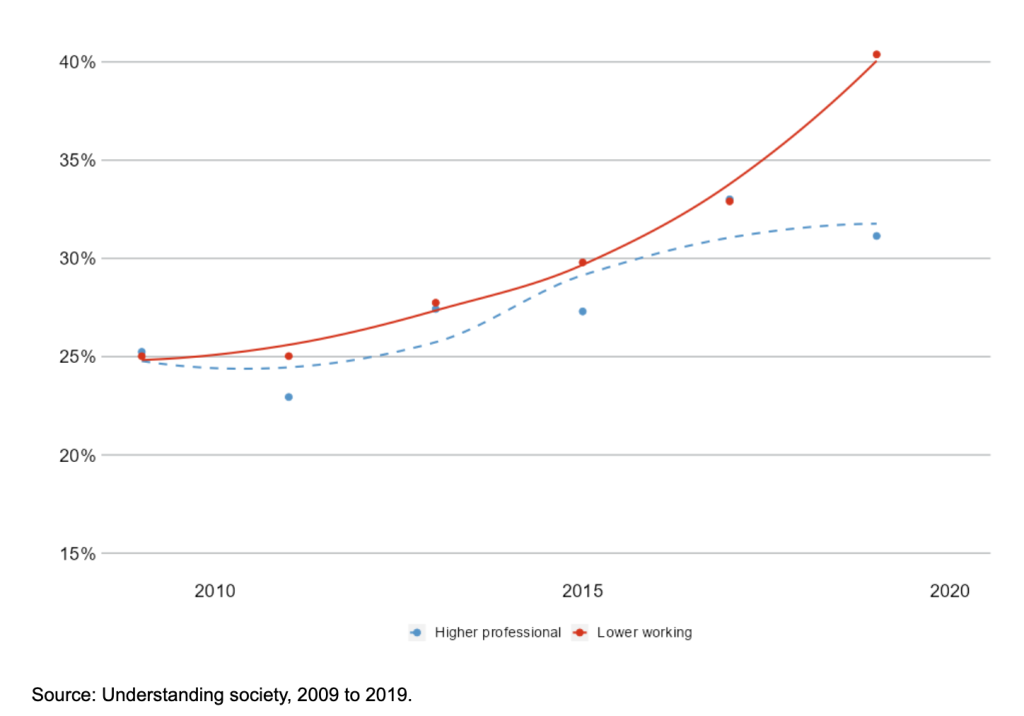
Notes: Child responses, aged 11 to 15; geographical coverage is the United Kingdom. The lines around the points are smoothed trend lines to aid interpretation.
There are some suggestions of widening inequality between socio-economic groups. For example, looking at the change over the last decade in children feeling nervous in new situations and easily losing confidence, lower-working-class boys have pulled away from the higher professional boys (see Figure 3.8b).
Figure 3.8b: “I feel nervous and easily lose confidence in new situations” by class, boys (% certainly true)
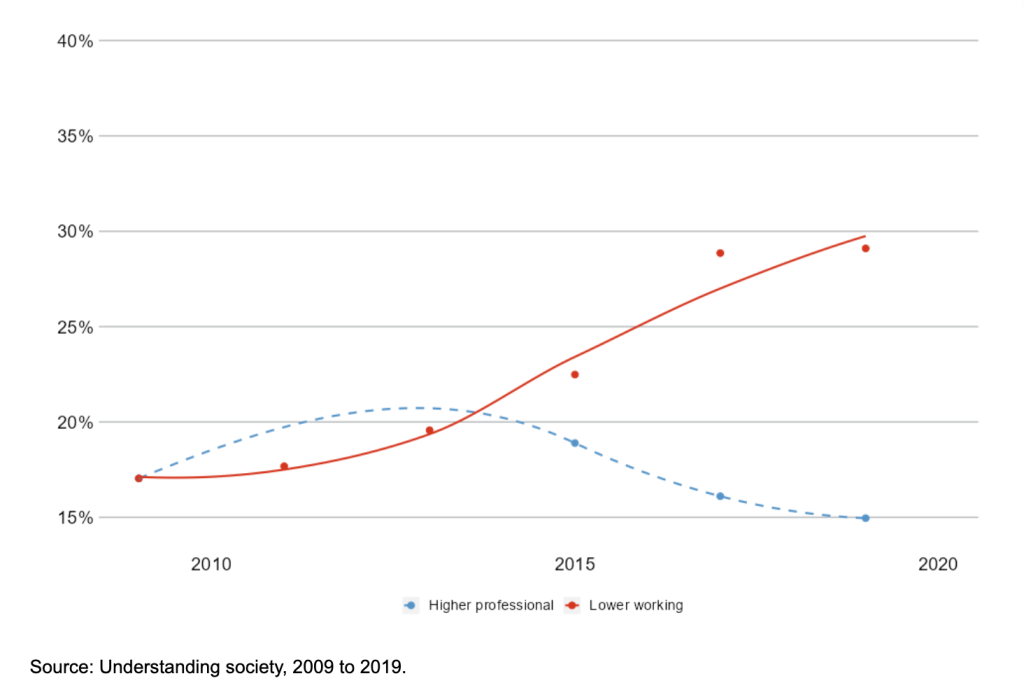
Notes: Child responses, aged 11 to 15; geographical coverage is the United Kingdom. The lines around the points are smoothed trend lines to aid interpretation.
Finally, we look at a set of items measured in the ‘Strengths and Difficulties Questionnaire’, which is a questionnaire tool used for many decades that includes a set of questions that are asked usually to parents, but sometimes also to children, which capture the behaviours and wellbeing of children. The questions tell us about whether children have behavioural problems, or ‘conduct disorders’, whether they experience hyperactivity or inattention, and about their emotional wellbeing.
In the original report in 2016, we looked at which children were more likely to fall into the extreme 10% with the most problems and showed that inequalities between socio-economic groups had been widening over time. The original analysis used data from 3 of the UK’s ‘cohort studies’, the most recent of which is the Millenium Cohort Study, a study of a group of babies born in 2000 to 2001. We do not have the data to be able to look at a new cohort of young children, but here we wanted to know whether the inequalities – with worse problems and lower wellbeing in the lower socio-economic group – have remained the same. To do that, we show newer analysis among older children in the Millenium Cohort who were aged around 17 for this analysis.
Figures 3.9, 3.10 and 3.11 show the results in the form of the ‘relative risk’ of the child experiencing conduct disorders, emotional symptoms, and hyperactivity and inattention compared to the higher professional class. Thus, the numbers show how many times more likely children from the other 4 occupational classes are to experience a problem compared to children from higher-professional families. Looking at conduct disorders, then, we can see that lower-professional children – shown in the red bar – are just a little more likely (1.1 times) to have high levels of conduct disorders than higher-professional children; this rises to 2.8 times more likely among the lower working class. The blue bar shows that these differences are similar among 11-year-olds (i.e., when this cohort was 6 years younger).
Figure 3.9: Risk of conduct disorders at age 11 (parent-reported) by occupational class
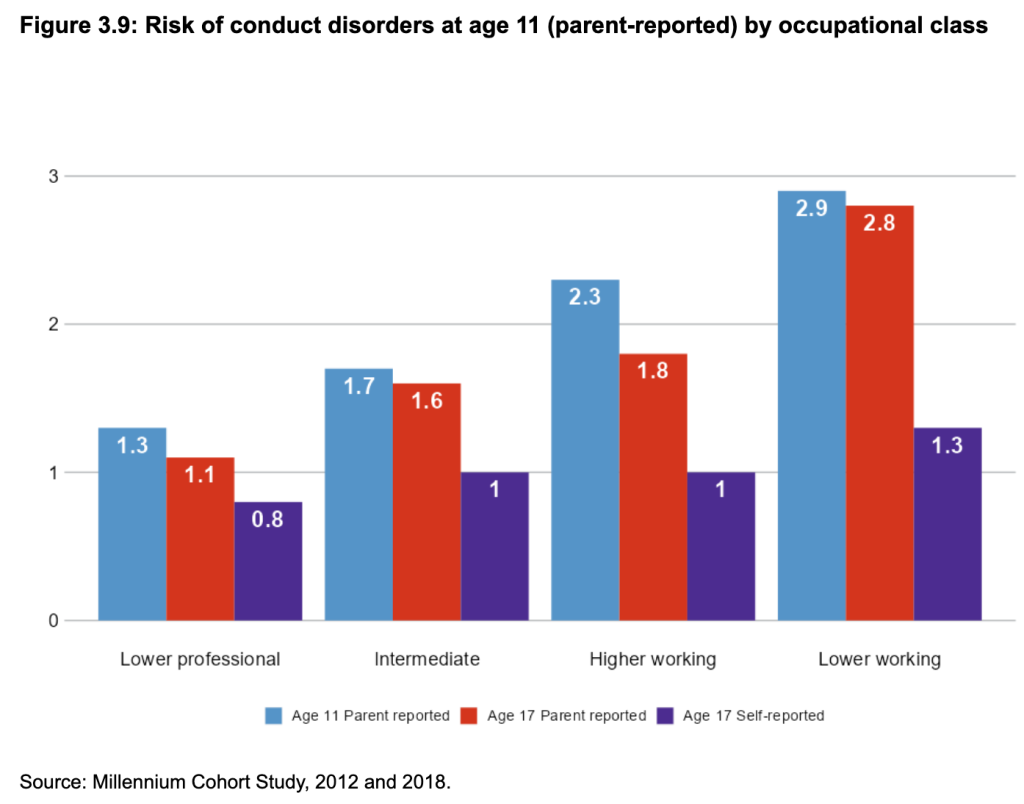
Notes: Parent and child (aged 11 and 17) responses; geographical coverage is the United Kingdom. Numbers show relative risk compared with children in higher-professional families.
We find similar gradients in the risk of emotional symptoms (Figure 3.10), where children in lower-working-class families are 2.5 times more likely to experience extreme symptoms than those in higher-professional families.
Figure 3.10: Risk of emotional symptoms at age 11 (parent-reported) by occupational class
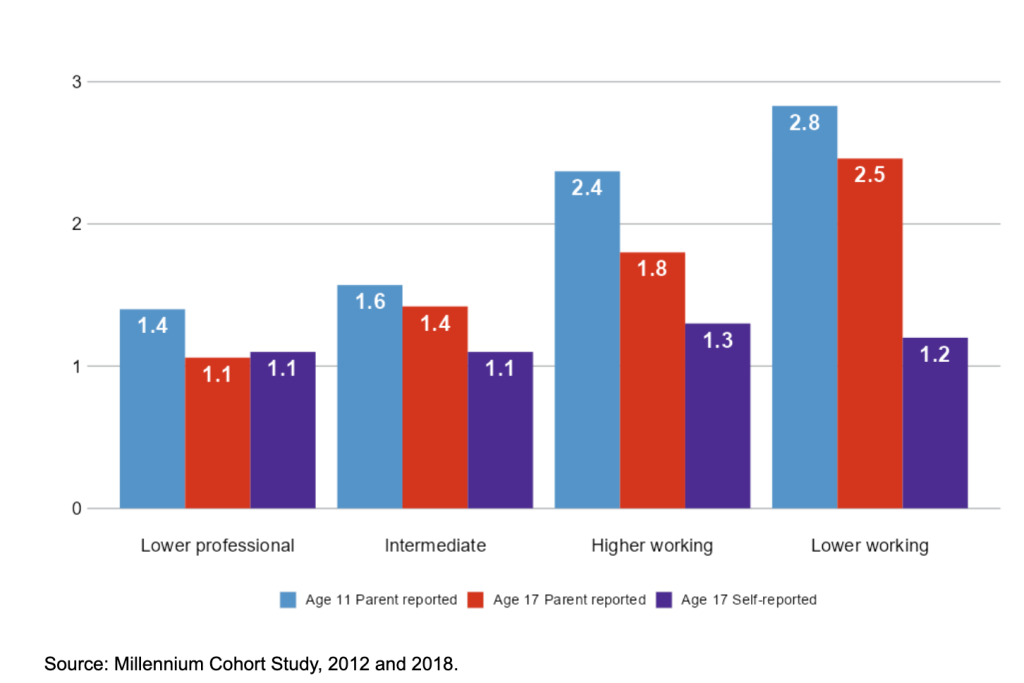
Notes: Parent and child (aged 11 and 17) responses; geographical coverage is the United Kingdom. Numbers show relative risk compared with children in higher-professional families.
In Figure 3.11, we see that children in lower-working-class families are 3.1 times more likely to experience extreme hyperactivity and inattention compared to those from higher-professional families. The graphs by educational level of parents can be found in the Appendix (Figures A3.9 to A3.11).
A final point here is that when the children were 17, we also had self-report measures available on the ‘Strengths and Difficulties Questionnaire’, which was asked to the children themselves as well as the parents. Interestingly, there are no real differences by socio-economic status when looking at the child-reported measures, shown in the purple bars.
Figure 3.11: Risk of hyperactivity and inattention at age 11 (parent-reported) by occupational class
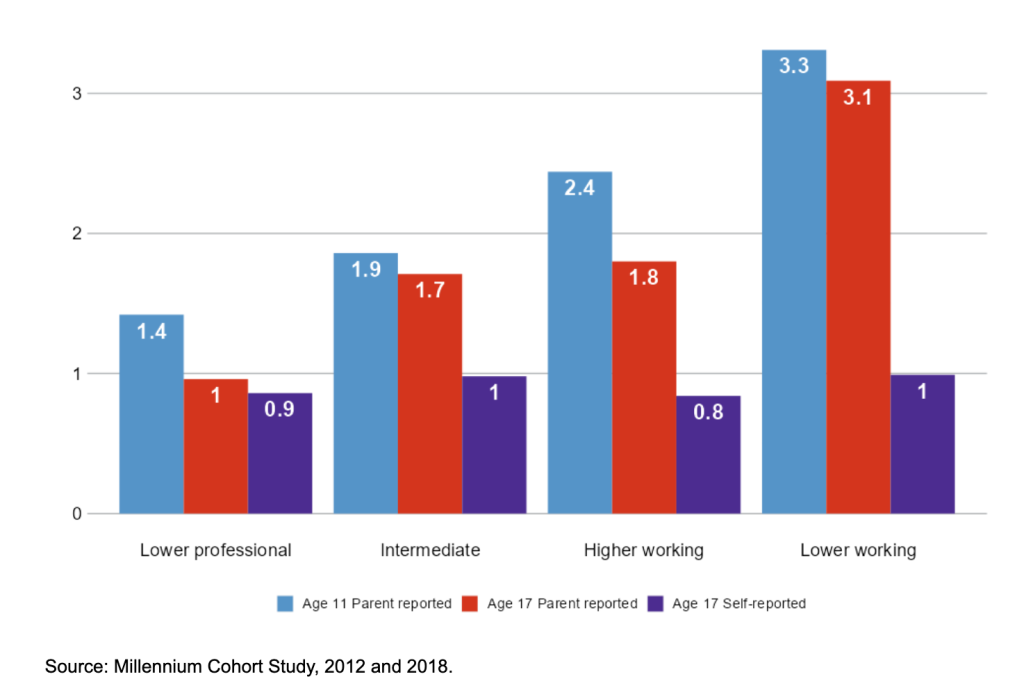
Notes: Parent and child (aged 11 and 17) responses; geographical coverage is the United Kingdom. Numbers show relative risk compared with children in higher-professional families.
3. Experiences of the pandemic
For many people, it may feel like the COVID-19 pandemic is now part of history and life is back to pre-pandemic ‘normal’. However, it is useful to examine some of the data arising from that period for 3 reasons. First, many topics included in the pandemic-related surveys have broader relevance. For example, because of its new salience, people were concerned with whether children studying at home had access to a suitable device to work on, good internet connection and a decent workspace. These things, of course, are important all the time, but they became an issue of greater concern when schools were closed. A second reason that this period is of importance is that there may be lasting consequences for the ‘COVID generation’ in terms of educational inequalities – a pattern which may not be fully understood for some time. Third, we may also take the patterns we saw during COVID as a more general understanding of what might happen in families in tumultuous times, and therefore as an indicator of how vulnerable or resilient families are to shocks such as the pandemic.
In Figure 3.12a, we see that almost all children had a device to work on at home during the COVID-19 lockdowns, but that far larger percentages of children in lower-working-class families relied on a mobile phone (18%) or had no device (9%) compared to the children in higher-professional families (5% and 1%), and we see a similar pattern by parental education (Figure 3.12b). We similarly find that problems accessing the internet were more frequent among families in lower socio-economic groups, and that children in these families were more likely to have to share a device on which to do their school work with another family member. We show these charts in the Appendix (Figures A3.12 and A3.13).
Figure 3.12a: Having suitable device for online work during lockdown by occupational class
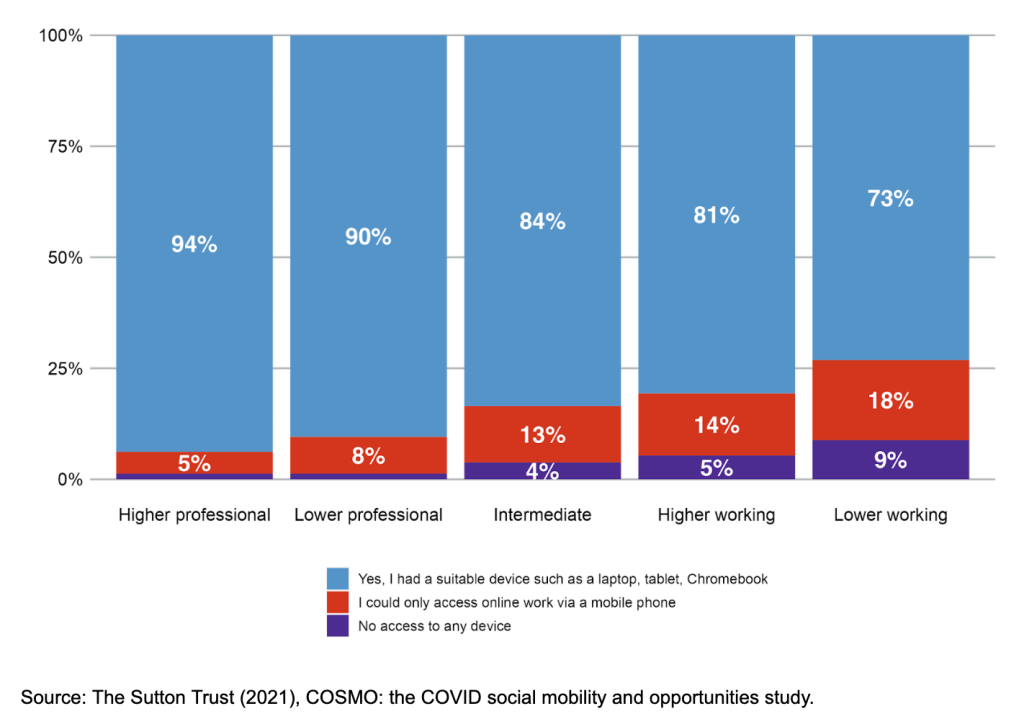
Notes: Parents’ responses when children were in year 11 (aged 15 to 16); geographical coverage is England only. Where the label is not shown, the value is 2% or less.
Figure 3.12b: Having suitable device for online work during lockdown by educational level
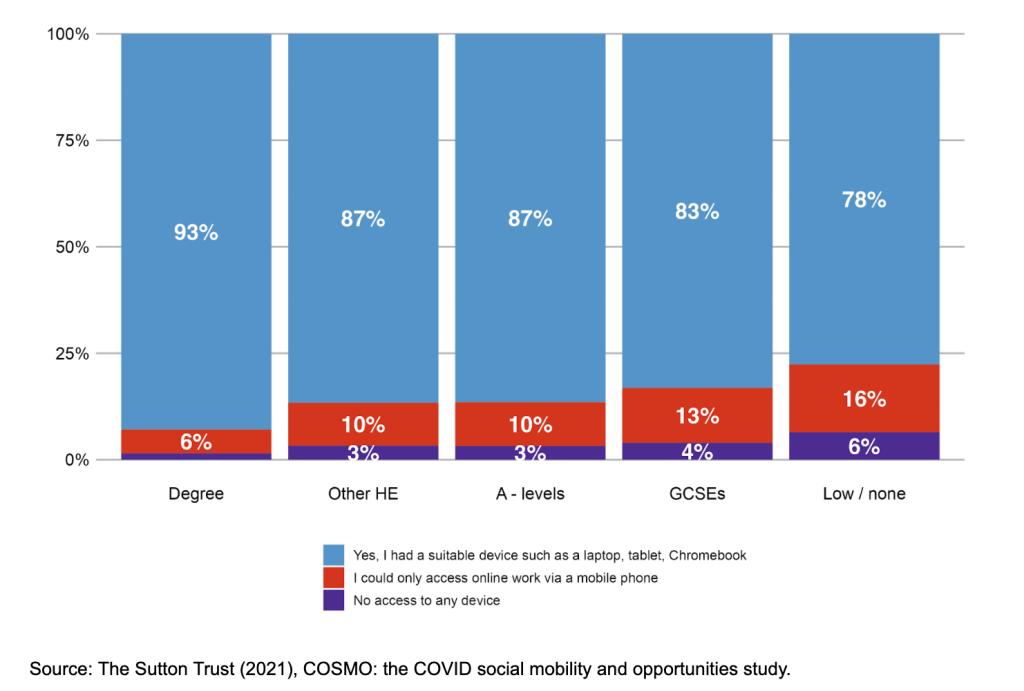
Notes: Parents’ responses when children were aged 15 to 16; geographical coverage is England only. HE refers to ‘higher education’. Where the label is not shown, the value is 2% or less.
Study space has also been shown to be important for children to achieve their academic potential, and in Figure 3.13a we show that during the pandemic, 22% of children in lower-working-class families lacked a suitable space for doing school work, compared to 11% of those in higher-professional families. We see a similar discrepancy by parental education in Figure 3.13b.
Figure 3.13a: Not having suitable workspace at home during lockdown by occupational class
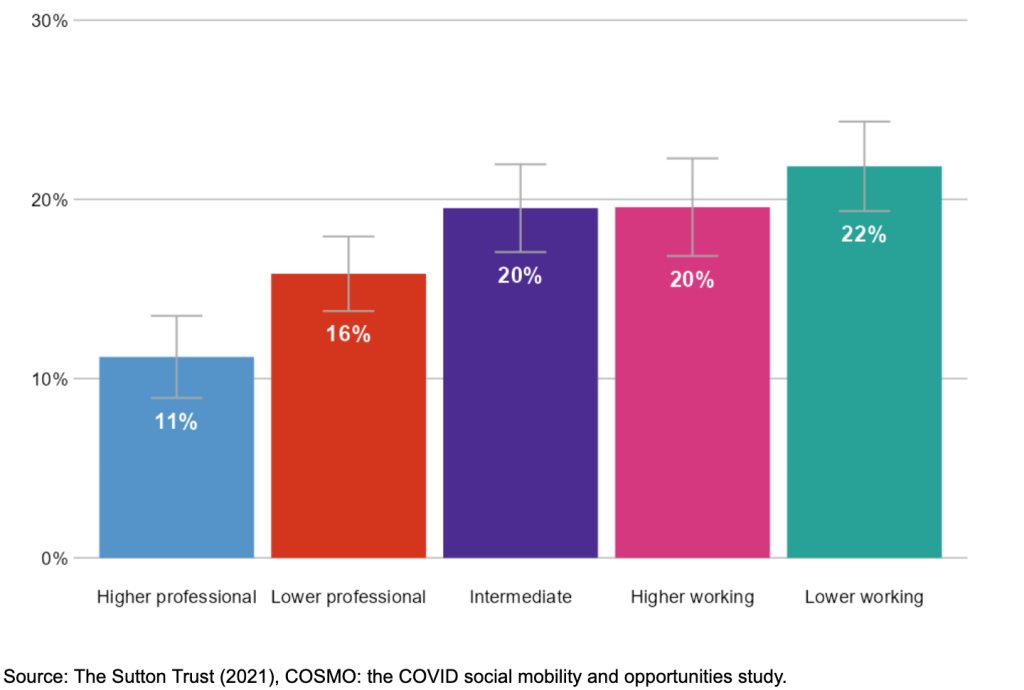
Notes: Parents’ responses when children were aged 15 to 16; geographical coverage is England only.
Figure 3.13b: Not having suitable workspace at home during lockdown by educational level
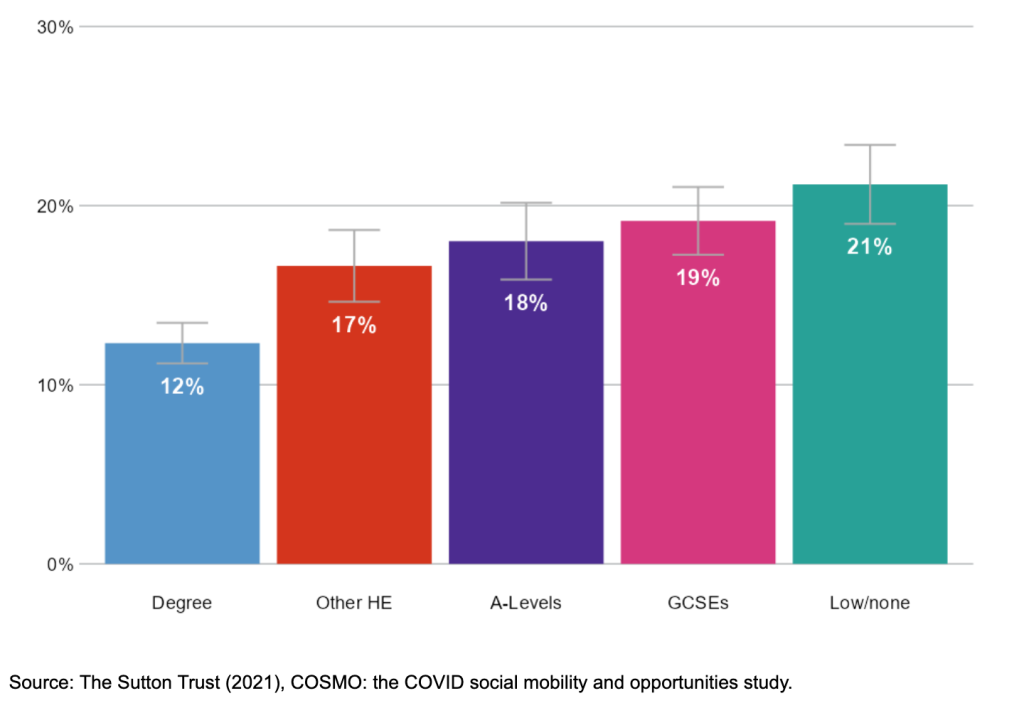
Notes: Parents’ responses when children were aged 15 to 16; geographical coverage is England only. HE refers to ‘higher education’.
4. Experiences of school and aspirations
In this final section, we focus on experiences of school and children’s own aspirations in terms of whether they think they will go to university. Recall that earlier, in Part 1, we showed that parental aspirations tend to be high across the board when parents were asked about what they expected their children to do, but with the highest likelihood of attending university reported among parents with a higher socio-economic status. Figure 3.14a shows a similar pattern when children themselves are asked about their plans: 78% of children in higher-professional families say they are likely to go to university, compared to 71% of those in lower-professional families, 62% in the intermediate class, 57% among the higher working class and 58% among the lower working class. The gradient by parental education is similar and can be seen in Figure 3.14b. With more than half of children of lower socio-economic status planning to go to university, the rates are overall rather high, but there is still a large gap, of 20 percentage points, between children in lower-working-class families and those in higher-professional families.
Figure 3.14a: Child self-reported plans to attend university by occupational class
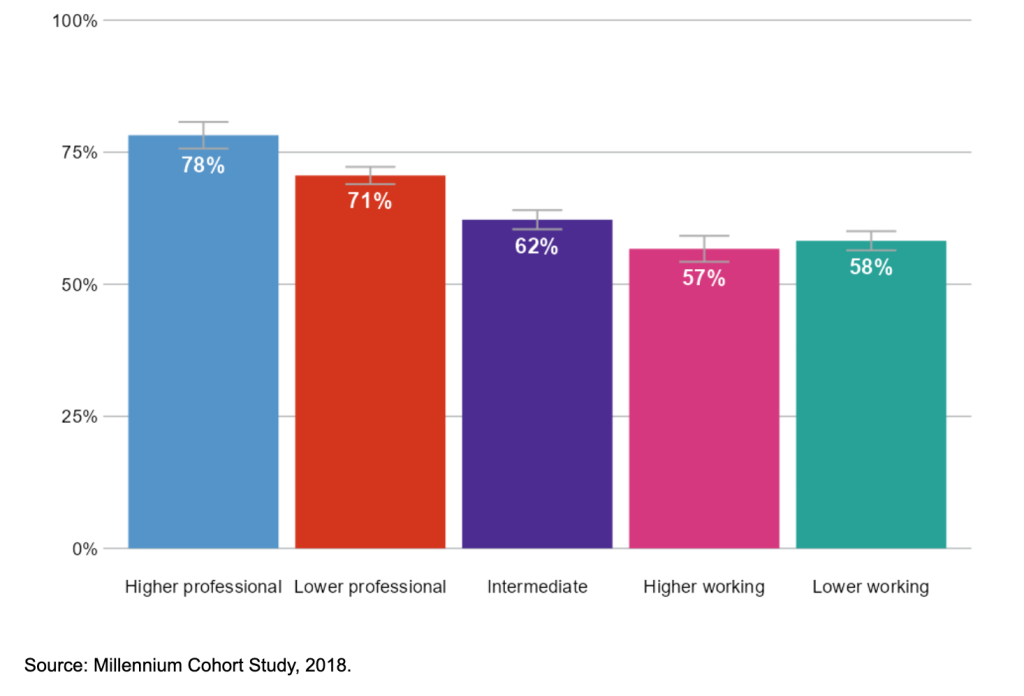
Notes: Child responses, aged 17 to 18; geographical coverage is the United Kingdom.
Figure 3.14b: Child self-reported likelihood of attending university by educational level
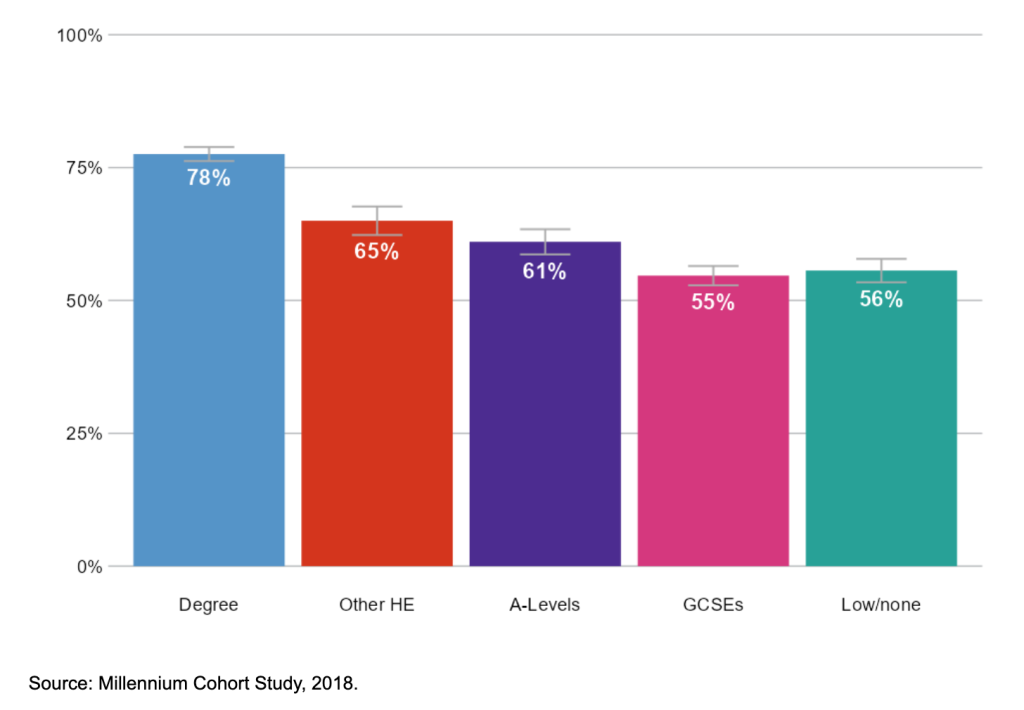
Notes: Child responses, aged 17 to 18; geographical coverage is the United Kingdom. HE refers to ‘higher education’.
More interesting, perhaps, are the reported reasons given by the children themselves for not planning to go to university (see Figure 3.15a and Figure 3.15b). These reasons are reported only by those who plan not to go, so we should bear in mind that the number of responses is lower for those from families with higher socio-economic status. Nonetheless, it is interesting to see that “I will not get the grades” is the reason most commonly reported by children in higher-professional families at 43%, compared to 33% of the lower working class families (Figure 3.15a).
The second most common reason is “I would prefer to get a job or start a career”, which is given by 19% of the children of higher professionals, 25% of the children of lower-working-class parents, and 27% of those with higher-working-class parents. The imperative to get out into the labour market thus appears to be stronger in the lower classes. Another important difference is in those children saying that they or their family cannot afford university. While the percentages for this answer option are quite low, there is a difference between the lower working class, 16% of whom give this reason, and the higher professionals at 9%. The question in this survey allowed the children to choose only one answer, and we should acknowledge the possible methodological shortcoming here. Worrying about the costs of university, for example, and wanting to get a job could be interconnected, and thus stemming from the same underlying reason.
The percentages of children reporting not being interested in going to university or believing that university would not help for their future career are rather similar across the board, as are the percentages saying that it is too early to decide. As the children were in year 11 at the time of the survey, there was still time left for them to make decisions about their future. The patterns are rather similar by parental education (Figure 3.15b).
Figure 3.15a: Child-reported reasons for not going to university by occupational class
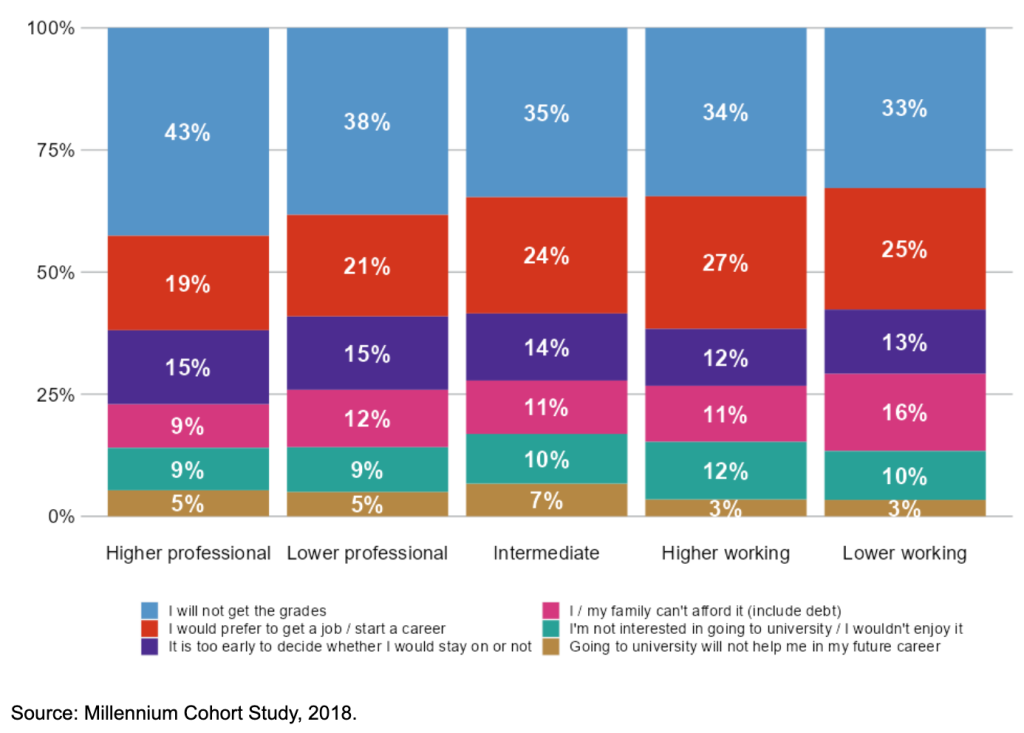
Notes: Child response, aged 17 to 18; geographical coverage is the United Kingdom.
Figure 3.15b: Child-reported reasons for not going to university by educational level
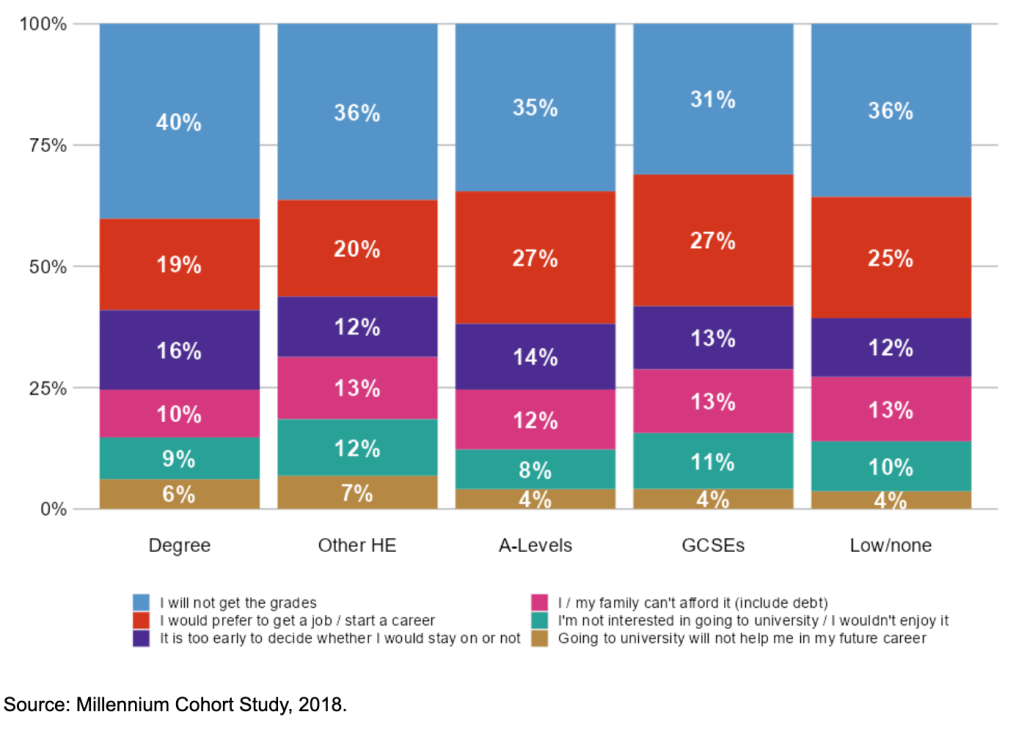
Notes: Child response, aged 17 to 18; geographical coverage is the United Kingdom. HE refers to ‘higher education’.
Finally, we show children’s reported feelings about school in Figure 3.16. Like our earlier measures we split these by boys and girls. We can see here rather larger differences – which have been persistent over time – in that children from lower-working-class families have a much higher rate of reporting being unhappy with their school than children from higher professional class families.
Figure 3.16: Feelings about school (% sad face icon) – boys and girls by occupational class
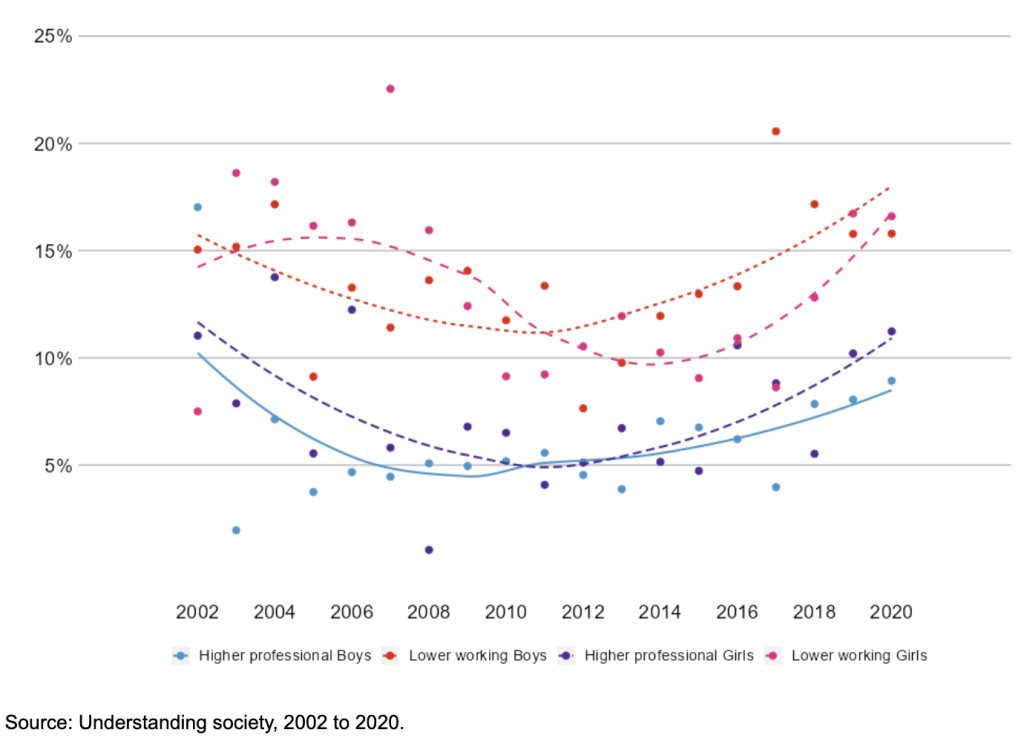
Notes: Child responses, aged 11 to 15; geographical coverage is the United Kingdom. The lines around the points are smoothed trend lines for aiding interpretation. Respondents were asked to select from a range of emojis on a 7-point scale running from happy to sad.
Bibliography
Anderson, L.R. (2018). Adolescent mental health and behavioural problems, and intergenerational social mobility: a decomposition of health selection effects. Social Science & Medicine, 197, 153–160.
Augenstein, J.A., Smaldone, A.M., Usseglio, J. and Bruzzese, J.M. (2023). Electronic cigarette use and academic performance among adolescents and young adults: a scoping review. Academic Pediatrics, 24(2), 228–242.
Baker, W. and Barg, K. (2019). Parental values in the UK. The British Journal of Sociology, 70(5), 2092–2115.
Barg, K. (2019). Why are middle-class parents more involved in school than working-class parents? Research in Social Stratification and Mobility, 59, 14–24.
Beard, E., Brown, J., West, R., Kaner, E., Meier, P. and Michie, S. (2019). Associations between socio-economic factors and alcohol consumption: a population survey of adults in England. PloS One, 14(2), e0209442.
Becker, G.S. and Tomes, N. (1979). An equilibrium theory of the distribution of income and intergenerational mobility. Journal of Political Economy, 87(6), 1153–1189.
Benton, T.D., Boyd, R.C. and Njoroge, W.F. (2021). Addressing the global crisis of child and adolescent mental health. JAMA Pediatrics, 175(11), 1108–1110.
Bloomfield, K. (2020). Understanding the alcohol-harm paradox: what next? The Lancet Public Health, 5(6), e300–e301.
Blyth, E. and Milner, J. (1993). Exclusion from school: a first step in exclusion from society? Children & Society, 7(3), 255–268.
Booth, C., Moreno-Agostino, D. and Fitzsimons, E. (2023). Parent–adolescent informant discrepancy on the Strengths and Difficulties Questionnaire in the UK Millennium Cohort Study. Child and Adolescent Psychiatry and Mental Health, 17(1), article 57.
Bukodi, E. and Goldthorpe, J.H. (2018). Social mobility and education in Britain: research, politics and policy. Cambridge University Press.
Bynner, J., Schuller, T. and Feinstein, L. (2003). Wider benefits of education: skills, higher education and civic engagement. Zeitschrift für Pädagogik, 49(3), 341–361.
Chan, T.W. and Koo, A. (2011). Parenting style and youth outcomes in the UK. European Sociological Review, 27(3), 385–399.
Chetty, R., Jackson, M.O., Kuchler, T., Stroebel, J., Hendren, N., Fluegge, R.B. … and Wernerfelt, N. (2022). Social capital I: measurement and associations with economic mobility. Nature, 608(7921), 108–121.
Coleman, J.S. (1988). Social capital in the creation of human capital. American Journal of Sociology, 94, S95–S120.
De Graaf, N.D., De Graaf, P.M. and Kraaykamp, G. (2000). Parental cultural capital and educational attainment in the Netherlands: a refinement of the cultural capital perspective. Sociology of Education, 73(2), 92–111.
Dederichs, K. (2024). Join to connect? Voluntary involvement, social capital, and socioeconomic inequalities. Social Networks, 76, 42–50.
Ellickson, P.L., Tucker, J.S. and Klein, D.J. (2003). Ten-year prospective study of public health problems associated with early drinking. Pediatrics, 111(5), 949–955.
Engzell, P., Frey, A. and Verhagen, M.D. (2021). Learning loss due to school closures during the COVID-19 pandemic. Proceedings of the National Academy of Sciences, 118(17), e2022376118.
Erola, J., Jalonen, S., and Lehti, H. (2016). Parental education, class and income over early life course and children’s achievement. Research in Social Stratification and Mobility, 44, 33–43.
Gershuny, J., Harms, T., Doherty, A., Thomas, E., Milton, K., Kelly, P. and Foster, C. (2020). Testing self-report time-use diaries against objective instruments in real time. Sociological Methodology, 50(1), 318–349.
Guo, G. and Harris, K.M. (2000). The mechanisms mediating the effects of poverty on children’s intellectual development. Demography, 37(4), 431–447.
Hartas, D. (2015). Parenting for social mobility? Home learning, parental warmth, class and educational outcomes. Journal of Education Policy, 30(1), 21–38.
Heath, A. and Li, Y. (2024). Social mobility. Polity Press.
Jæger, M.M. (2022). Cultural capital and educational inequality: an assessment of the state of the art. In Gërxhani, K., de Graaf, N.D. and Raub, W. (eds), Handbook of Sociological Science (pp. 121–134). Edward Elgar Publishing.
Kan, M.Y. and Pudney, S. (2008). Measurement error in stylized and diary data on time use. Sociological Methodology, 38(1), 101–132.
Karamanos, A., Stewart, K., Harding, S., Kelly, Y. and Lacey, R.E. (2022). Adverse childhood experiences and adolescent drug use in the UK: the moderating role of socioeconomic position and ethnicity. SSM-Population Health, 19, 101142.
Kearns, A. (2022). Housing space and occupancy standards: developing evidence for policy from a health and wellbeing perspective in the UK context. Building Research & Information, 50(7), 722–737.
Lareau, A. (2003). Unequal childhoods: class, race, and family life. University of California Press.
McGinnity, F., McMullin, P., Murray, A., Russell, H. and Smyth, E. (2022). Understanding differences in children’s reading ability by social origin and gender: the role of parental reading and pre- and primary school exposure in Ireland. Research in Social Stratification and Mobility, 81, 100729.
Miller, P. and Plant, M. (1999). Truancy and perceived school performance: an alcohol and drug study of UK teenagers. Alcohol and Alcoholism, 34(6), 886–893.
Newlove-Delgado T., McManus, S., Sadler, K., Thandi, S., Vizard, T., Cartwright, C., Ford, T. and Mental Health of Children and Young People group (2021). Child mental health in England before and during the COVID-19 lockdown. Lancet Psychiatry, 8(5), 353–354.
NHS Digital (2022). Smoking, drinking and drug use among young people in England, 2021. https://digital.nhs.uk/data-and-information/publications/statistical/smoking-drinking-and-drug-use-among-young-people-in-england.
NHS England (2023). Mental health of children and young people in England, 2023: wave 4 follow up to the 2017 survey. https://digital.nhs.uk/data-and-information/publications/statistical/mental-health-of-children-and-young-people-in-england.
O’Connell, M. (2023). Assessing patterns of anti-social and risky behaviour in the Millennium Cohort Study: what are the roles of SES (socio-economic status), cognitive ability and personality? Behavioral Sciences, 13(1), 46.
ONS (Office for National Statistics) (2023). Drug misuse in England and Wales: year ending March 2023. www.ons.gov.uk/peoplepopulationandcommunity/crimeandjustice/articles/drugmisuseinenglandandwales/yearendingmarch2023.
Picoito, J., Santos, C. and Nunes, C. (2021). Emotional and behavioural pathways to adolescent substance use and antisocial behaviour: results from the UK Millennium Cohort Study. European Child & Adolescent Psychiatry, 30(11), 1813–1823.
Portes, A. (1998). Social capital: its origins and applications in modern sociology. Annual Review of Sociology, 24(1), 1–25.
Putnam, R.D. (2000). Bowling alone: the collapse and revival of American community. Simon & Schuster.
Putnam, R.D. (2015). Our kids: the American dream in crisis. Simon & Schuster.
Reay, D. (1998). ‘Always knowing’ and ‘never being sure’: familial and institutional habituses and higher education choice. Journal of Education Policy, 13(4), 519–529.
Richards, L. (2016). For whom money matters less: social connectedness as a resilience resource in the UK. Social Indicators Research, 125(2), 509–535.
Robinson, C.C., Mandleco, B., Olsen, S.F. and Hart, C.H., (2001). The parenting styles and dimensions questionnaire (PSDQ). Handbook of Family Measurement Techniques, 3, 319–321.
Robinson, J. and Godbey, G. (1999). Time for life: the surprising ways Americans use their time. Pennsylvania State University Press.
Sheldon, S.B. (2002). Parents’ social networks and beliefs as predictors of parent involvement. The Elementary School Journal, 102(4), 301–316.
Social Mobility Commission (2016). The childhood origins of social mobility: socio-economic inequalities and changing opportunities. www.gov.uk/government/publications/the-childhood-origins-of-social-mobility.
Social Mobility Commission (2023). State of the Nation 2023: people and places. www.gov.uk/government/publications/state-of-the-nation-2023-people-and-places.
Social Mobility Commission (2024). State of the Nation 2024: Local to national, Mapping opportunities for all.
https://www.gov.uk/government/publications/state-of-the-nation-2024-local-to-national-mapping-opportunities-for-all
Stanistreet, P., Elfert, M. and Atchoarena, D. (2020). Education in the age of COVID-19: understanding the consequences. International Review of Education, 66, 627–633.
Strand, S. (2021). Ethnic, socio-economic and sex inequalities in educational achievement at age 16: an analysis of the Second Longitudinal Study of Young People in England (LSYPE2). Commission on Race and Ethnic Disparities (CRED).
Strand, S. (2022). Education and Achievement at 16. Sociology Review, 31(3).
Sullivan, A. (2008). Cultural capital, cultural knowledge and ability. Sociological Research Online, 12(6), 91–104.
The Sutton Trust (2021). COSMO: the COVID social mobility and opportunities study. www.suttontrust.com/cosmo-the-covid-social-mobility-and-opportunities-study.
Wodtke, G.T., Harding, D.J. and Elwert, F. (2011). Neighborhood effects in temporal perspective: the impact of long-term exposure to concentrated disadvantage on high school graduation. American Sociological Review, 76(5), 713–736.
